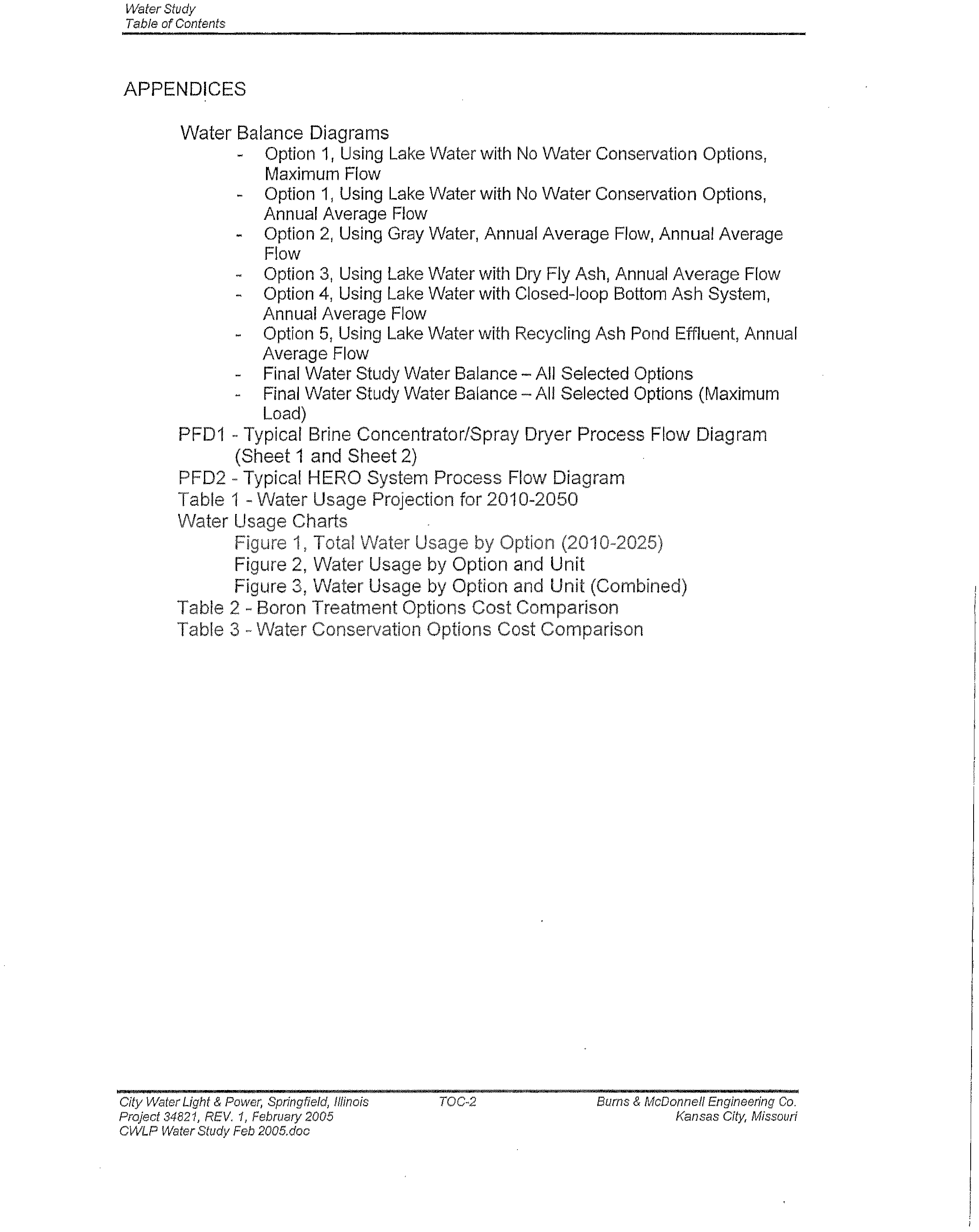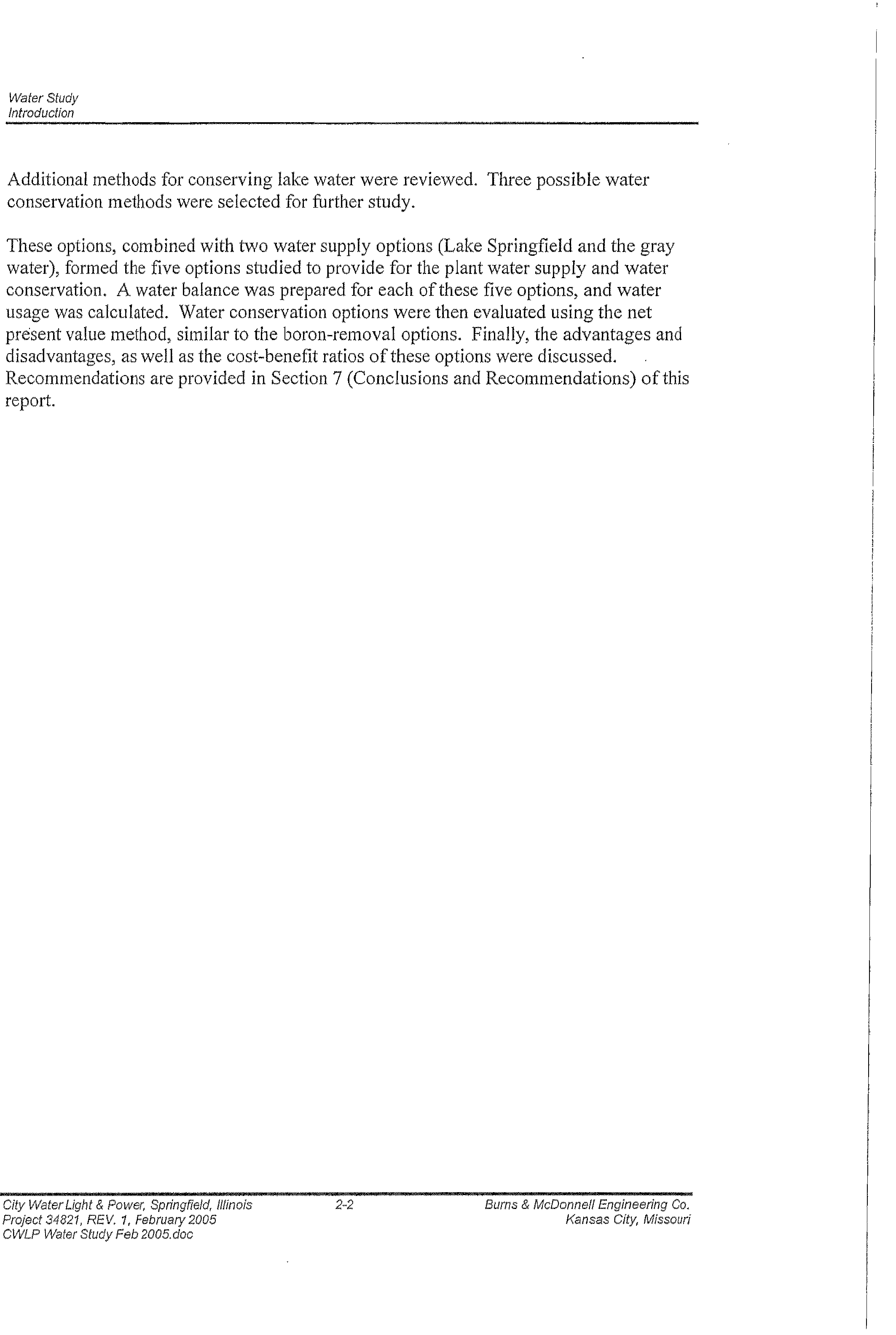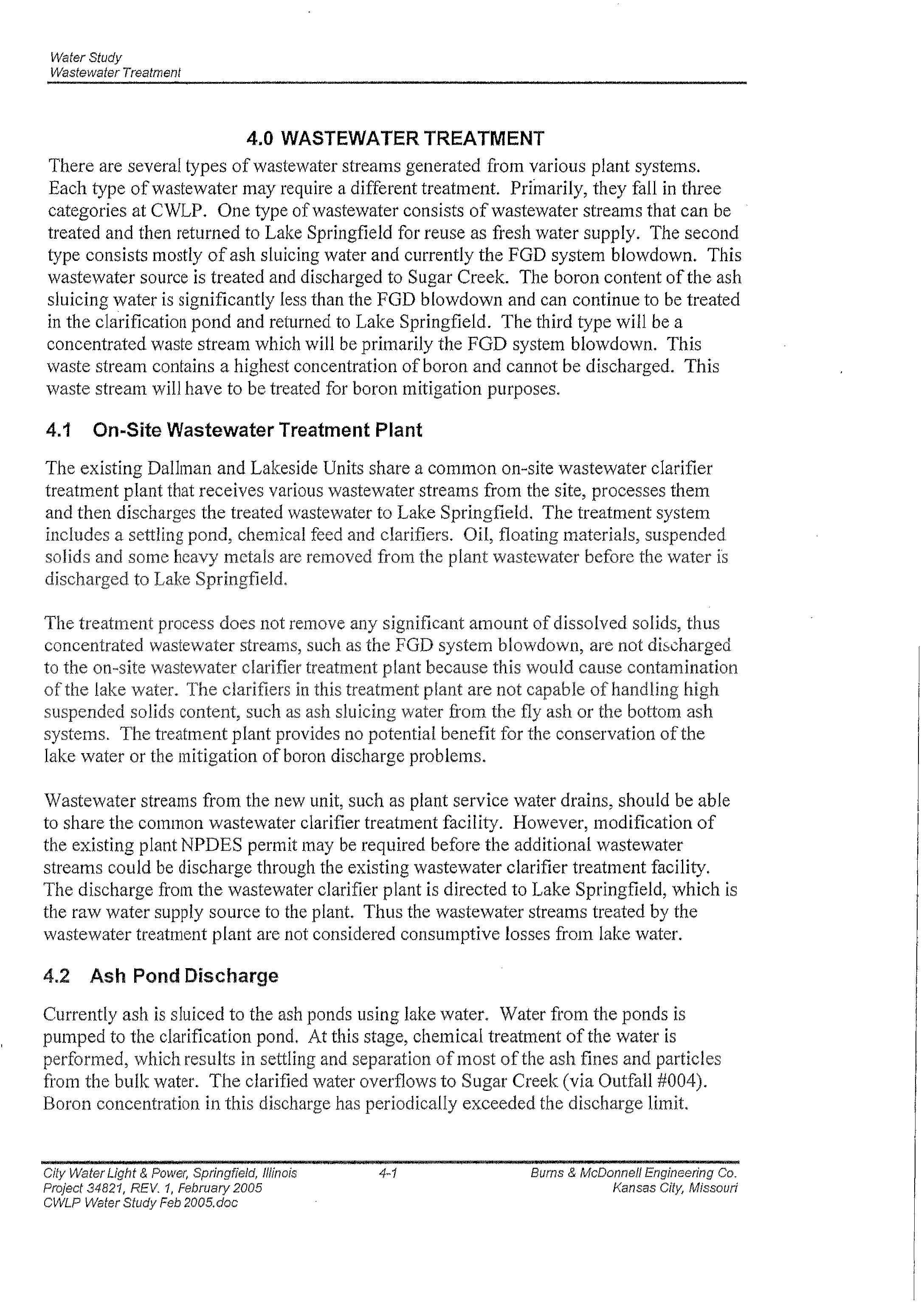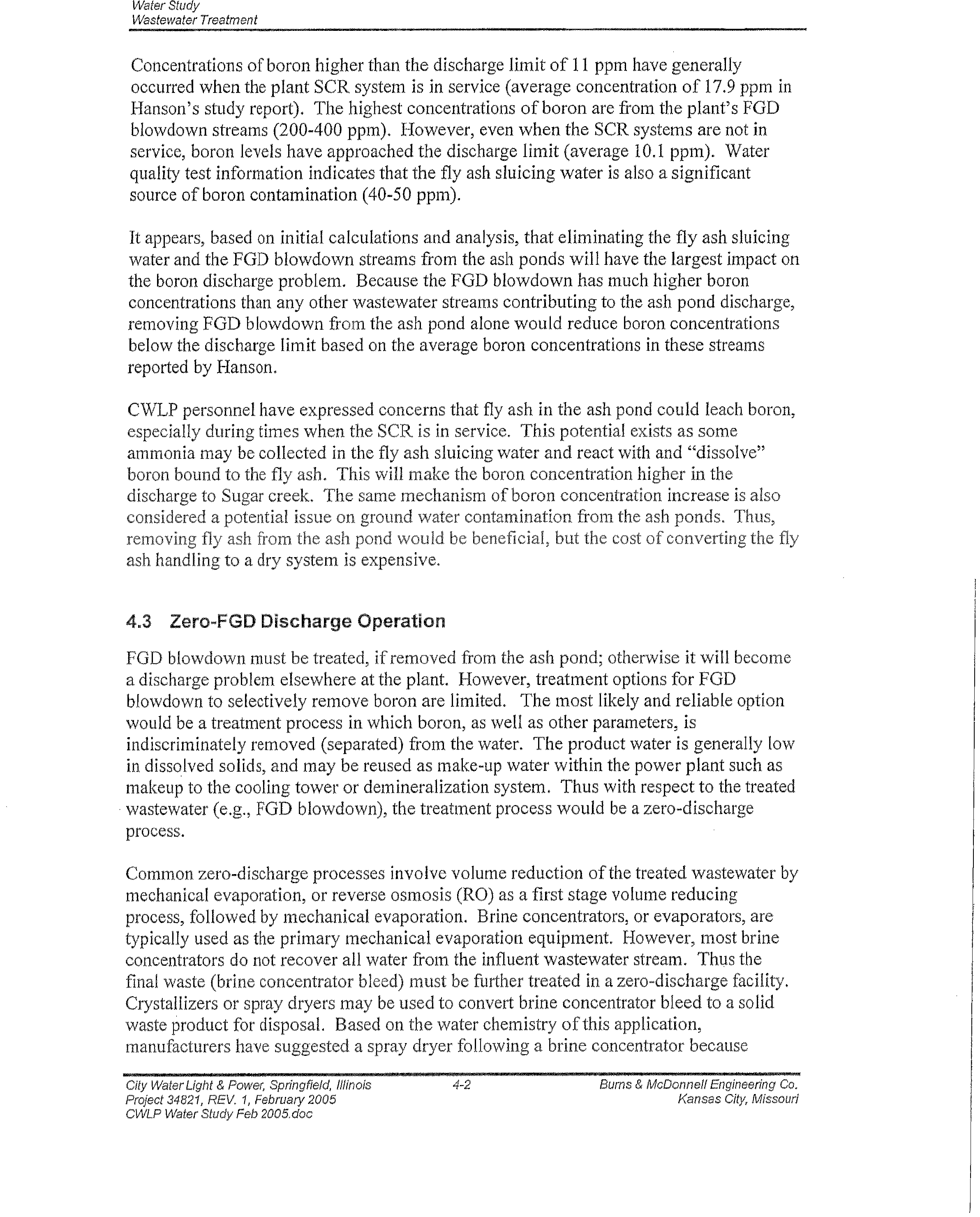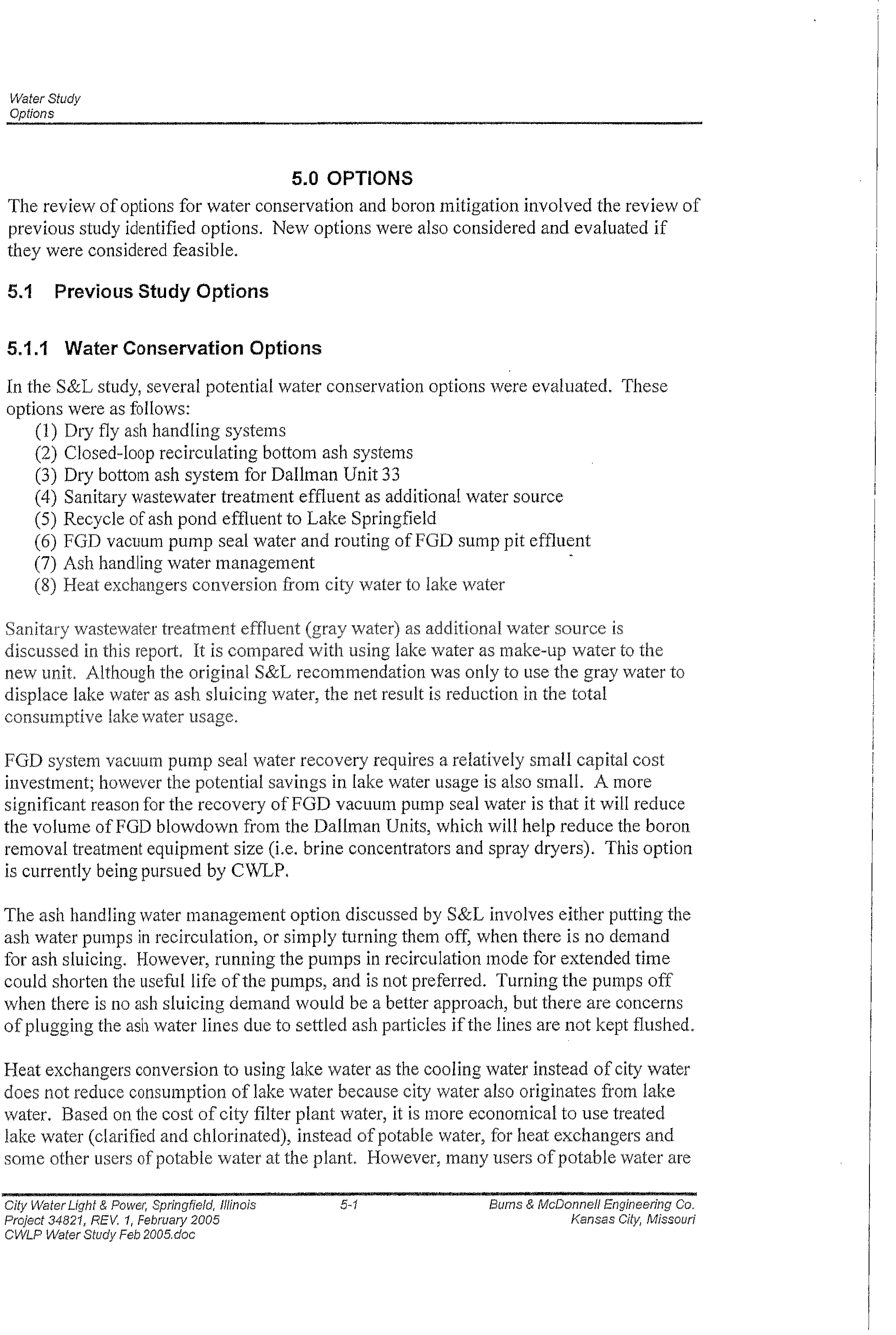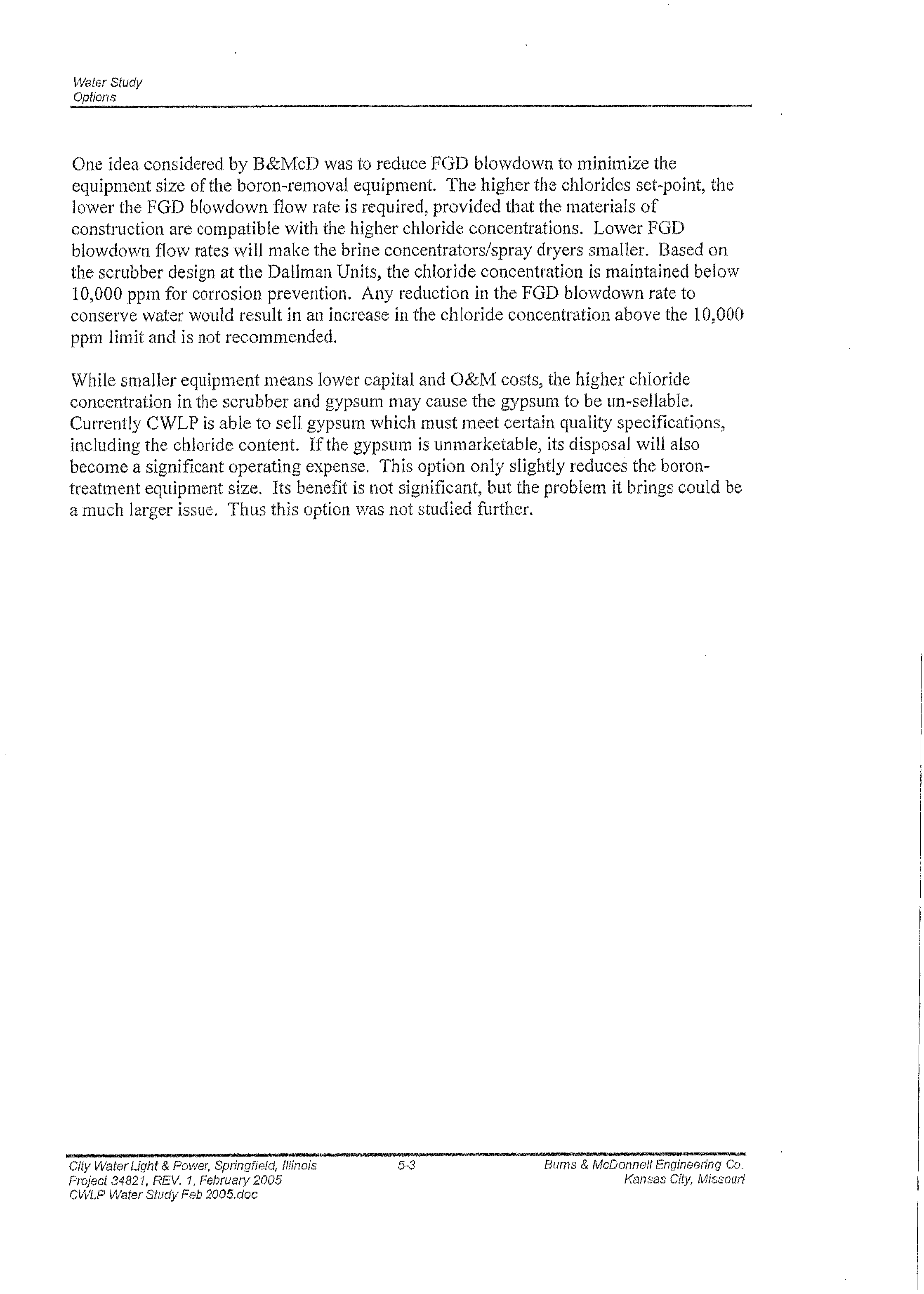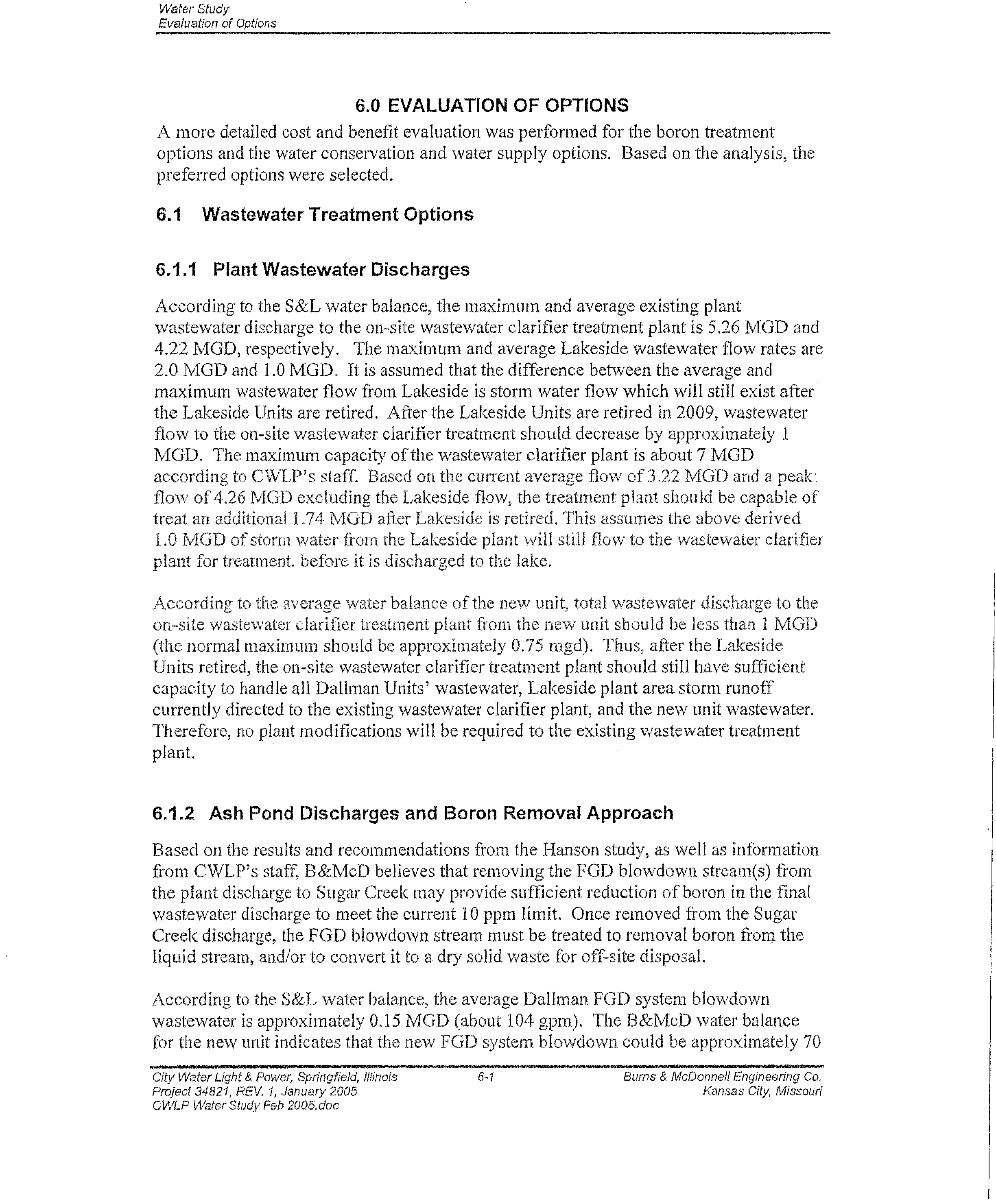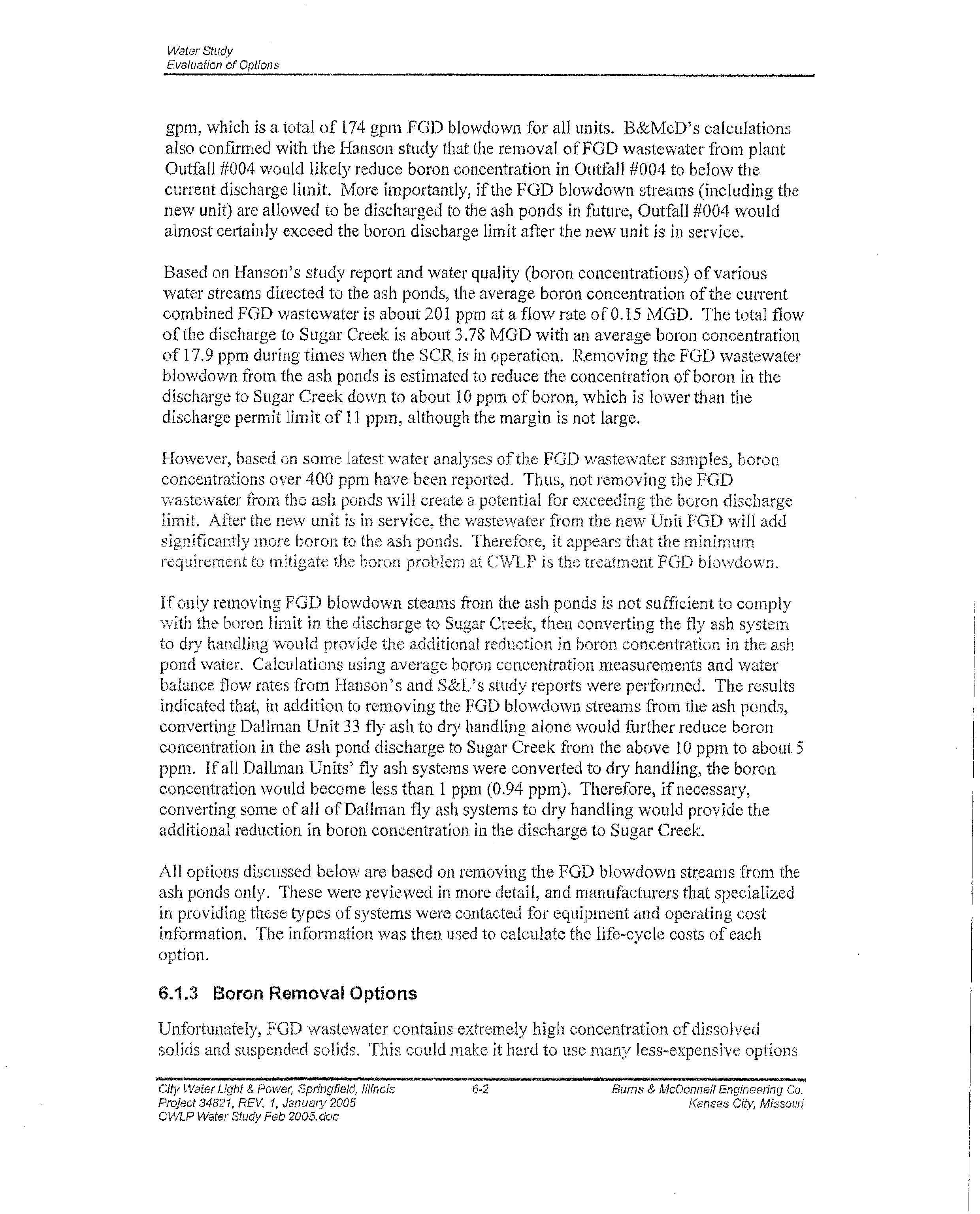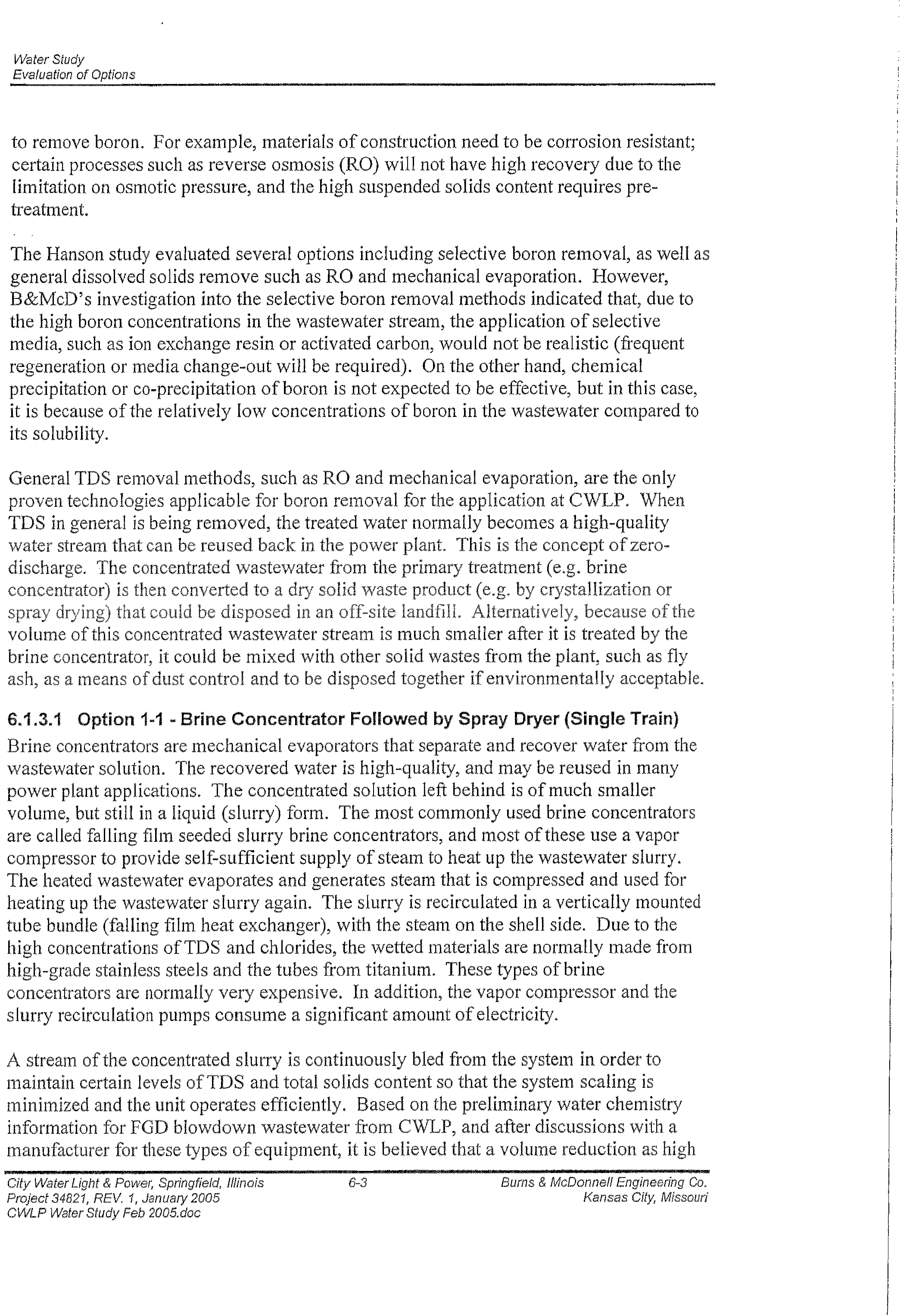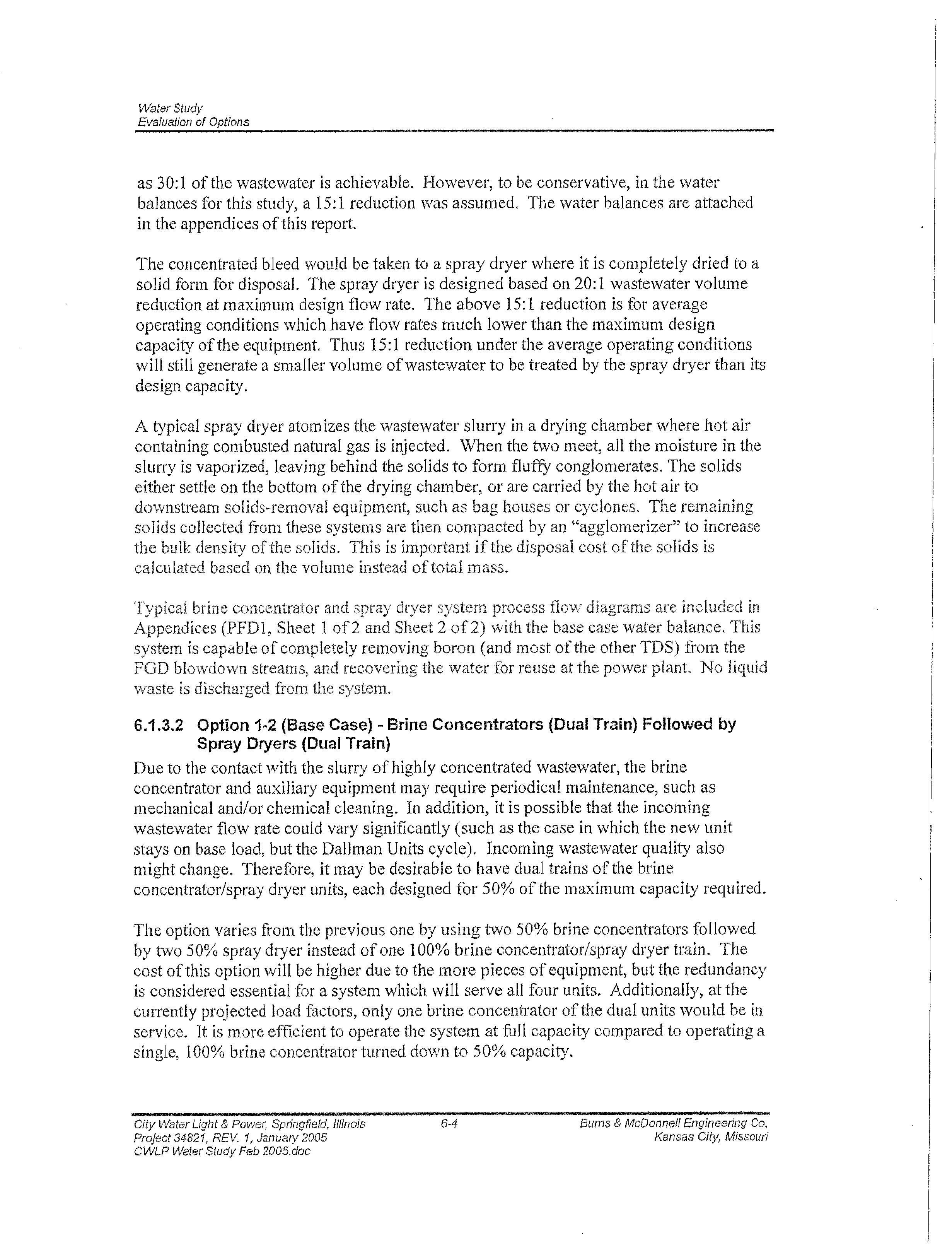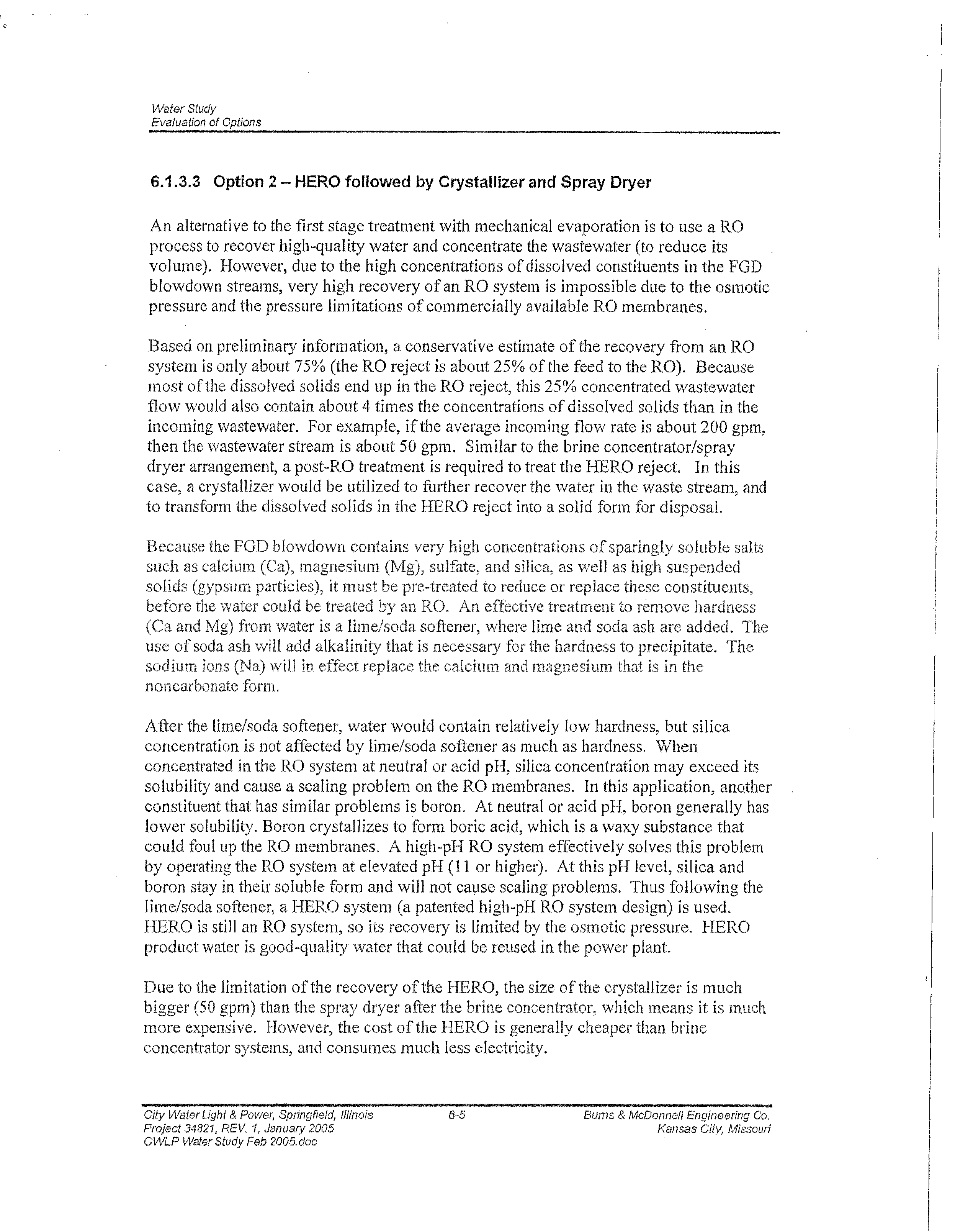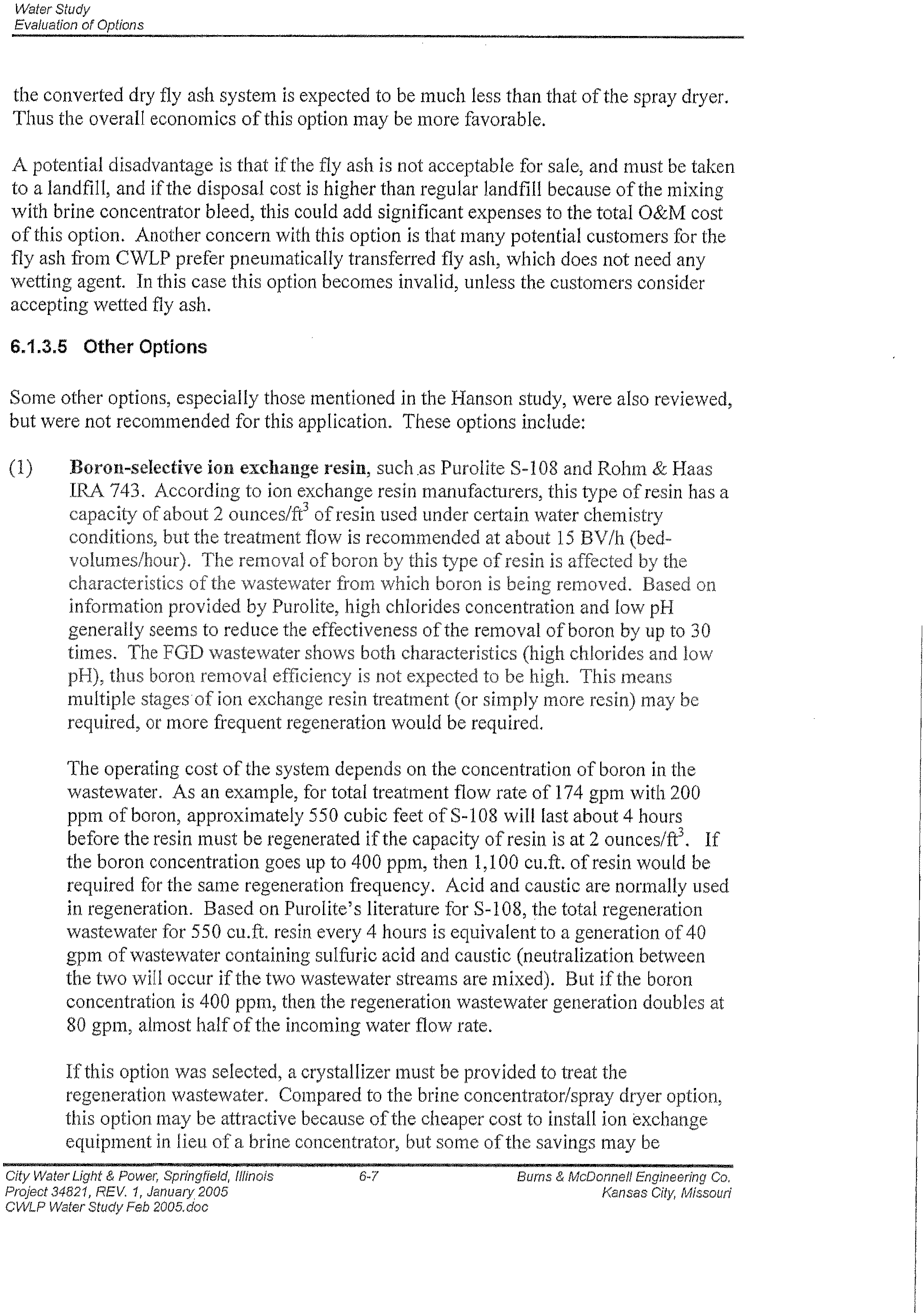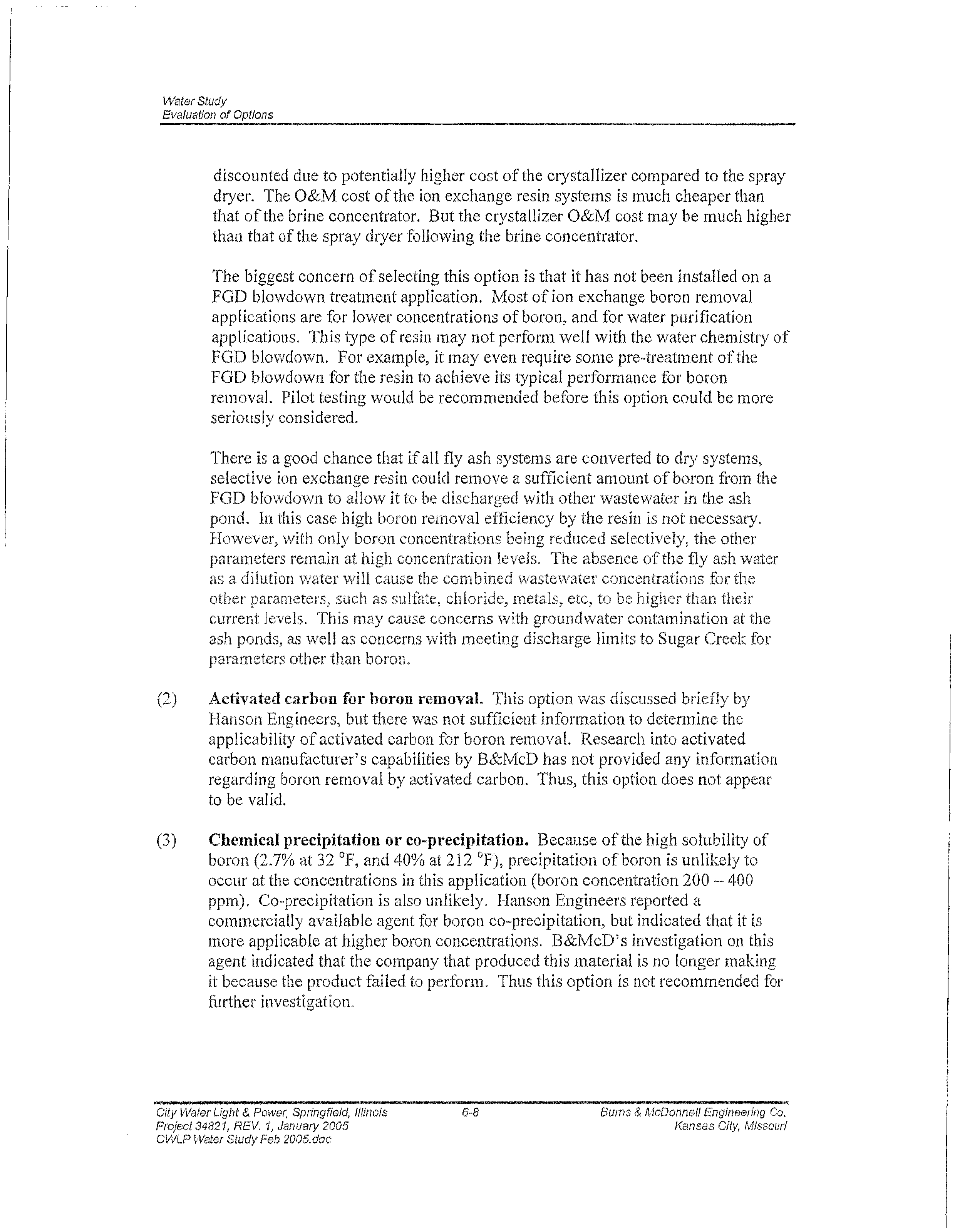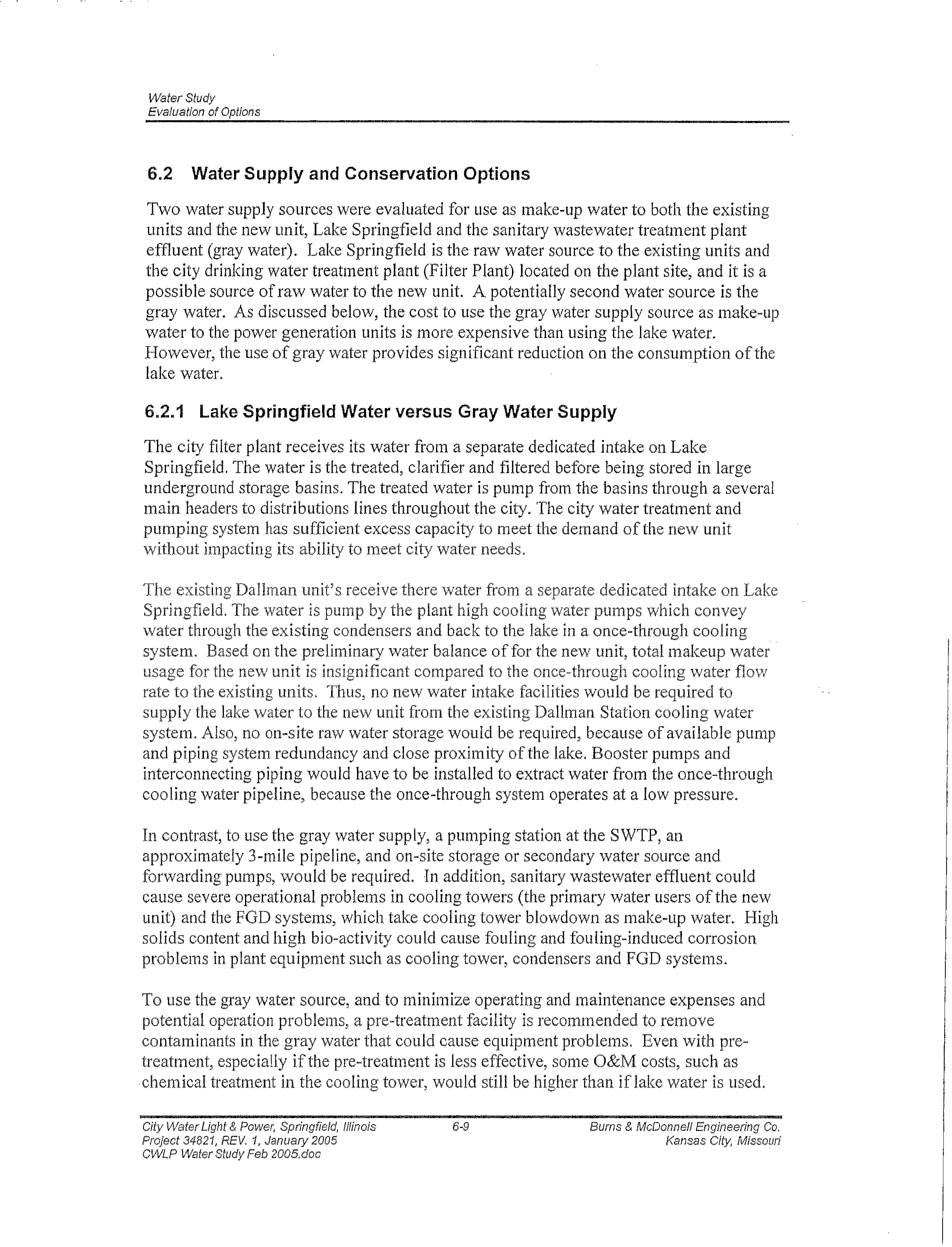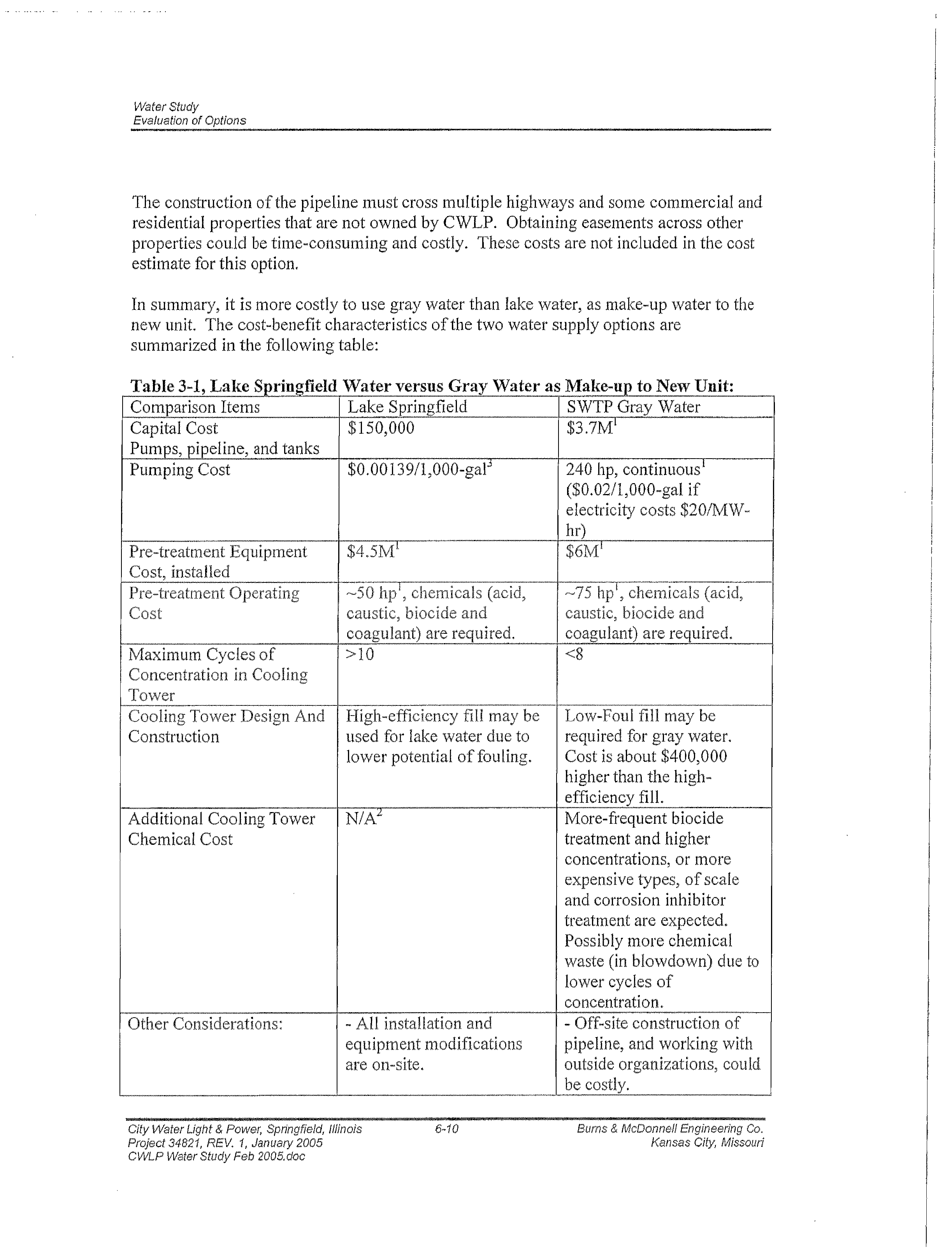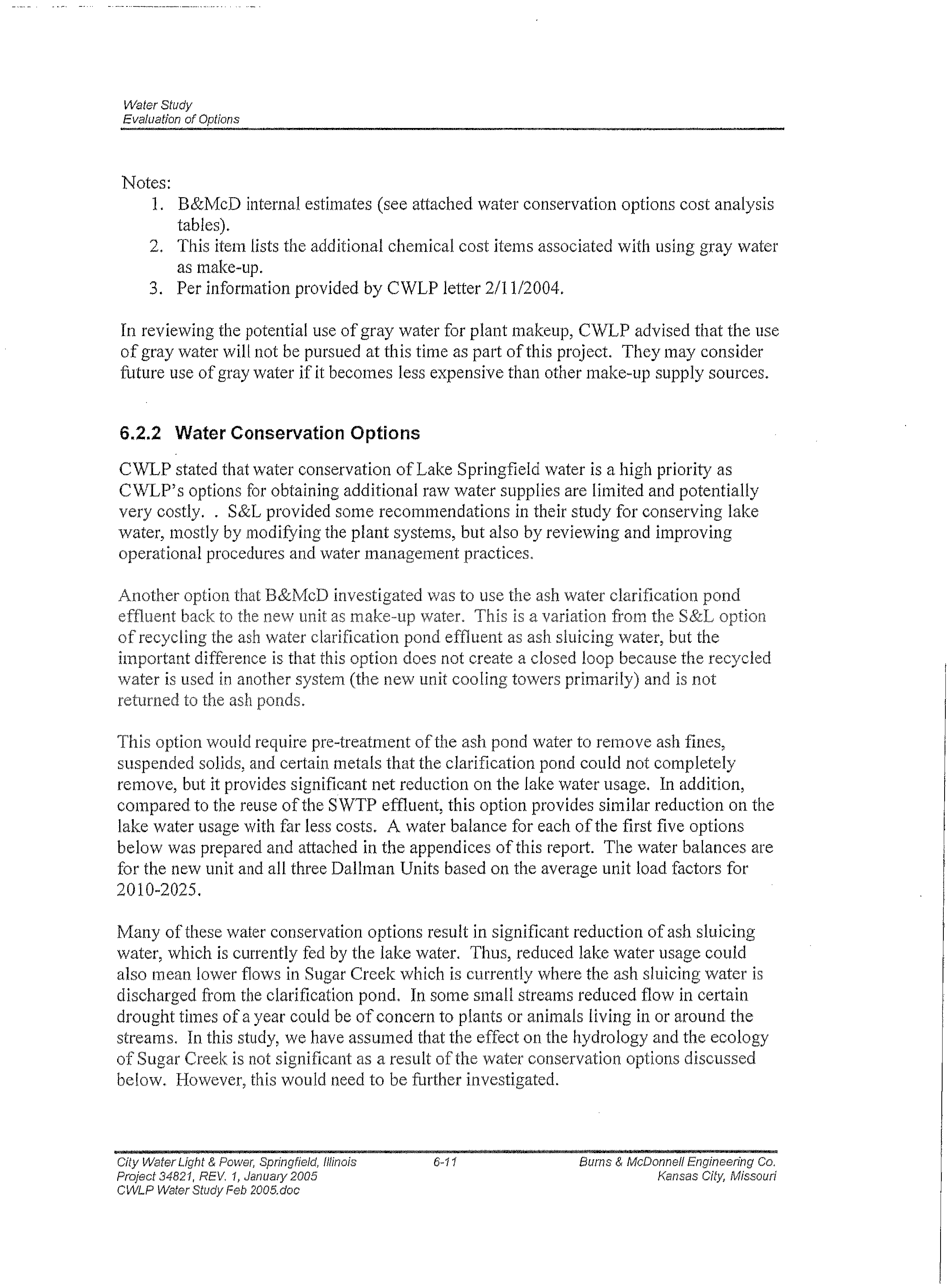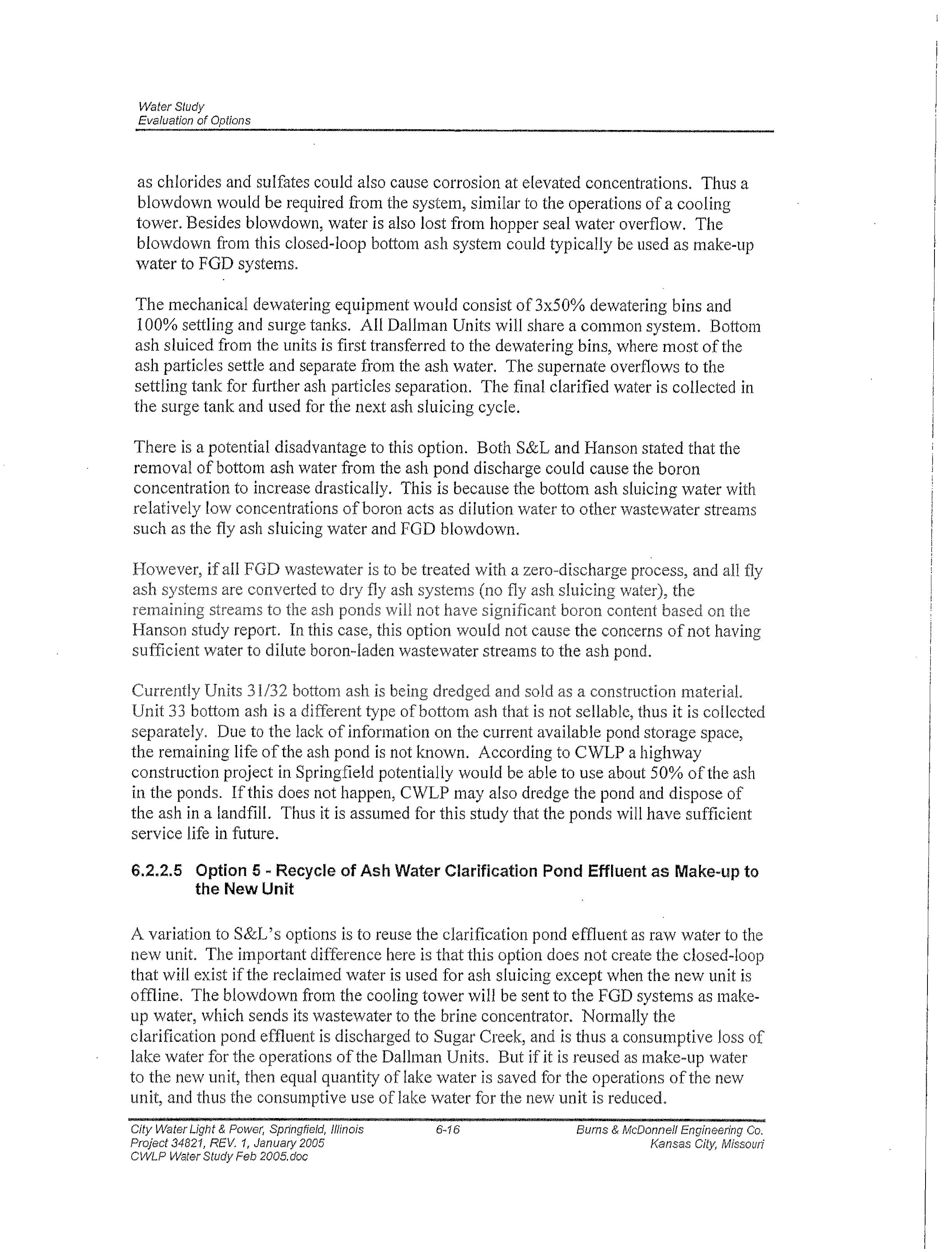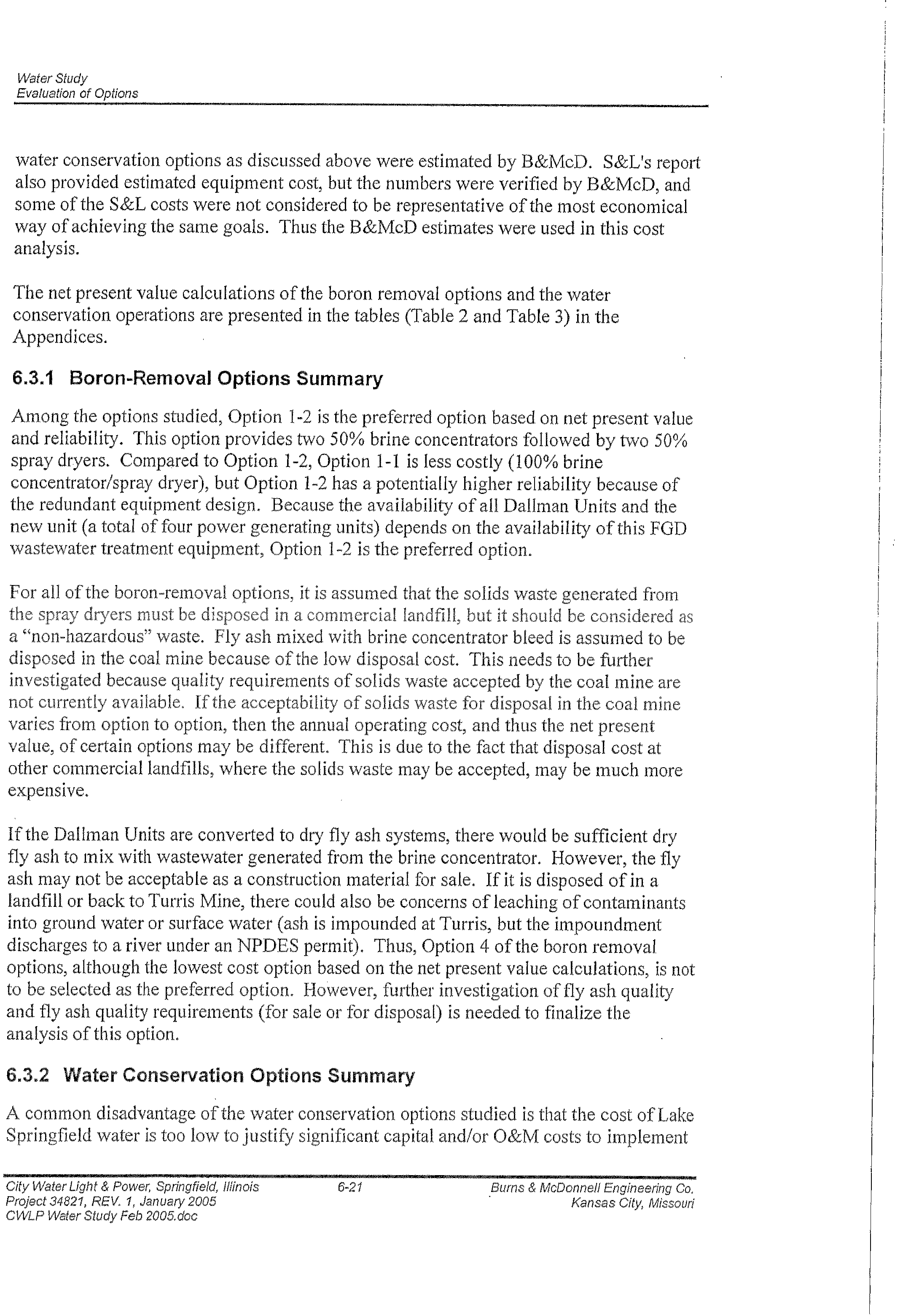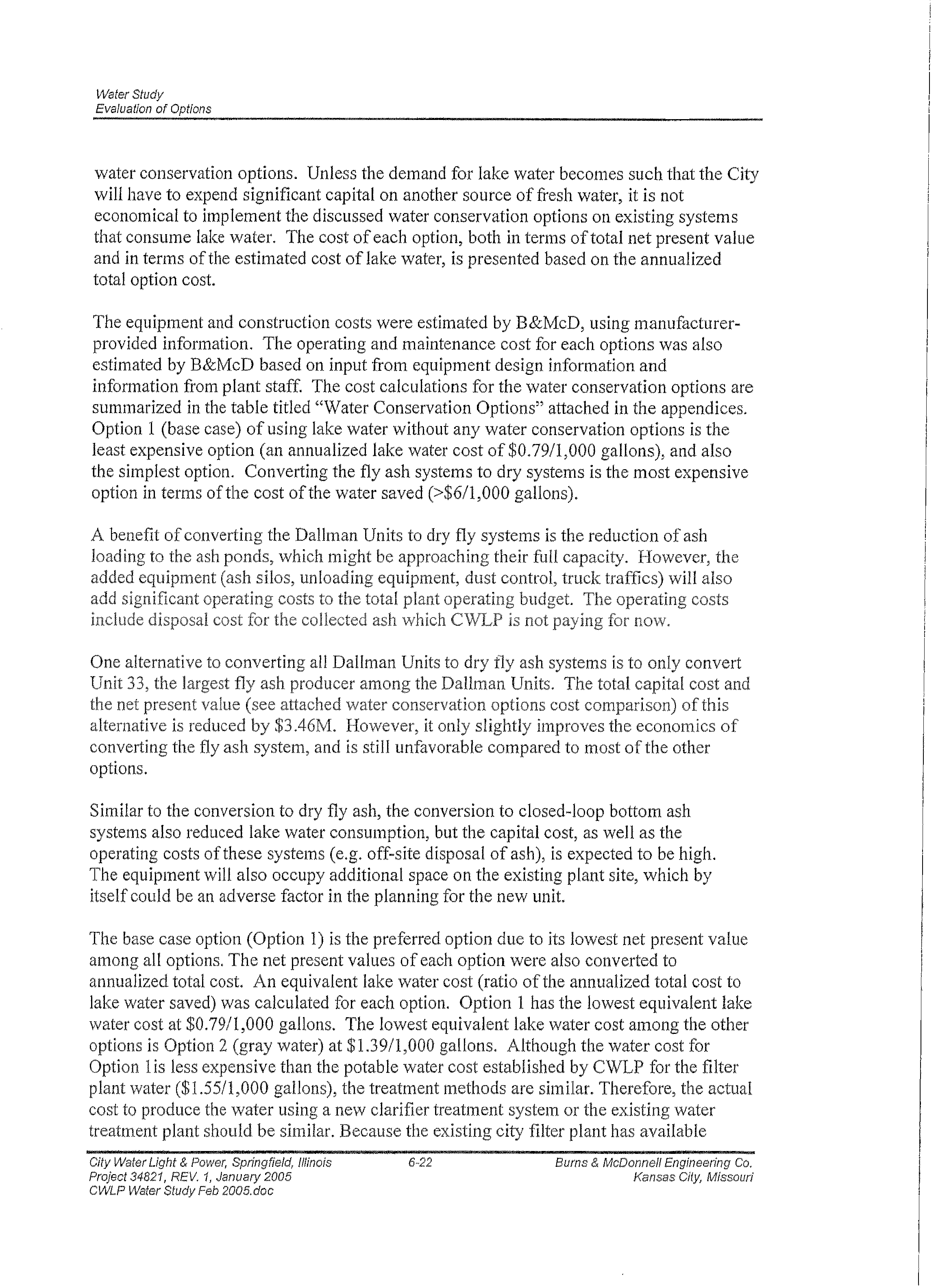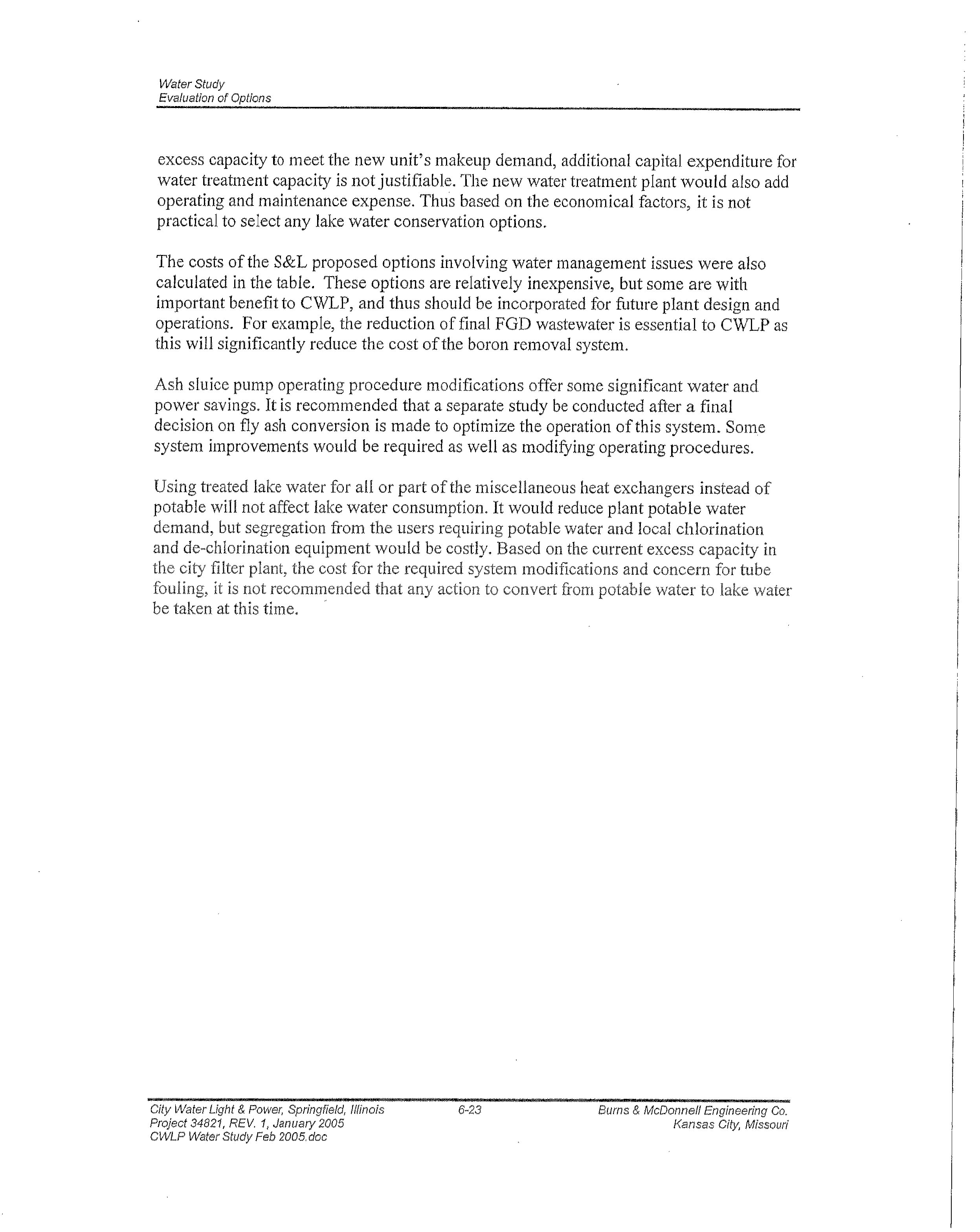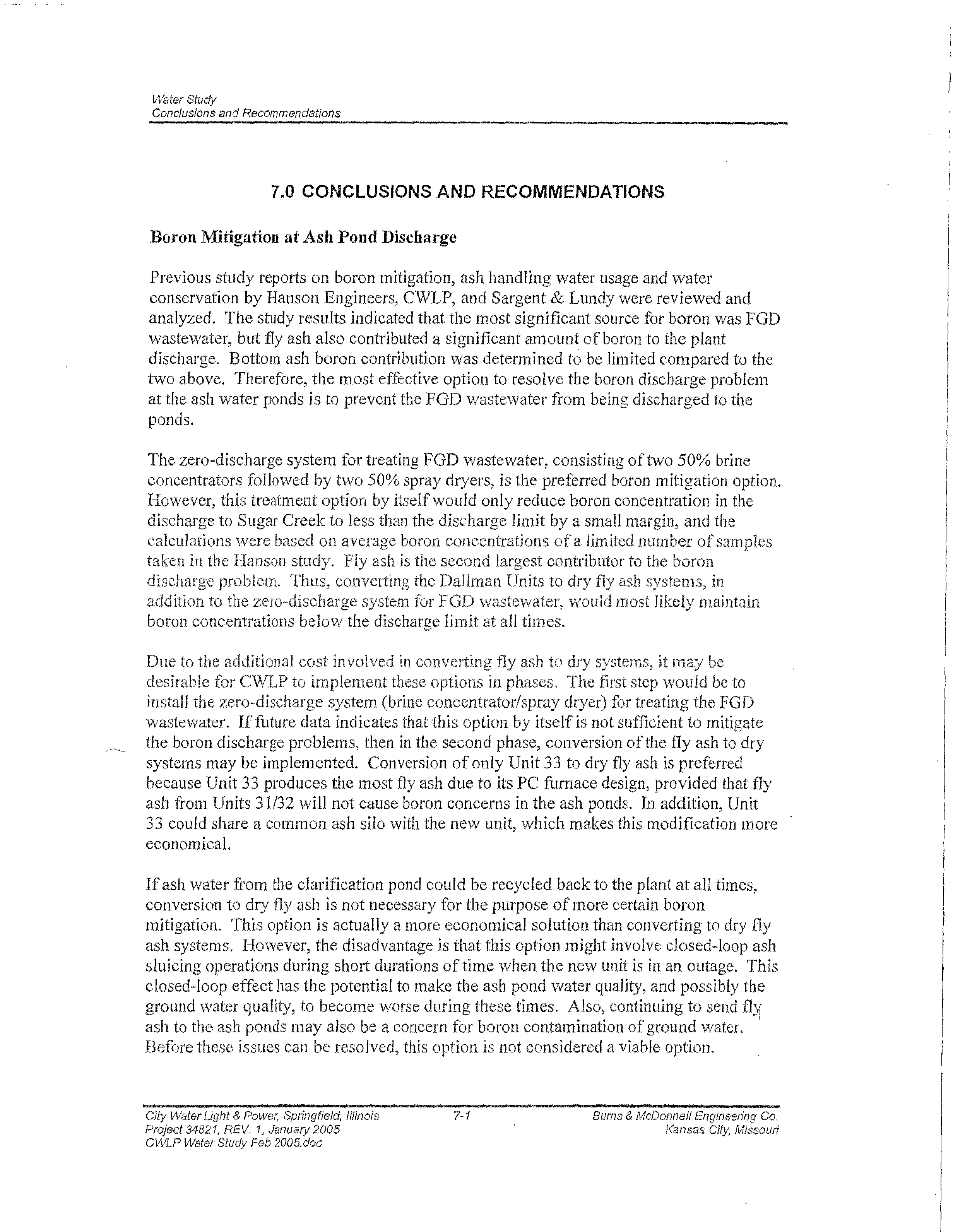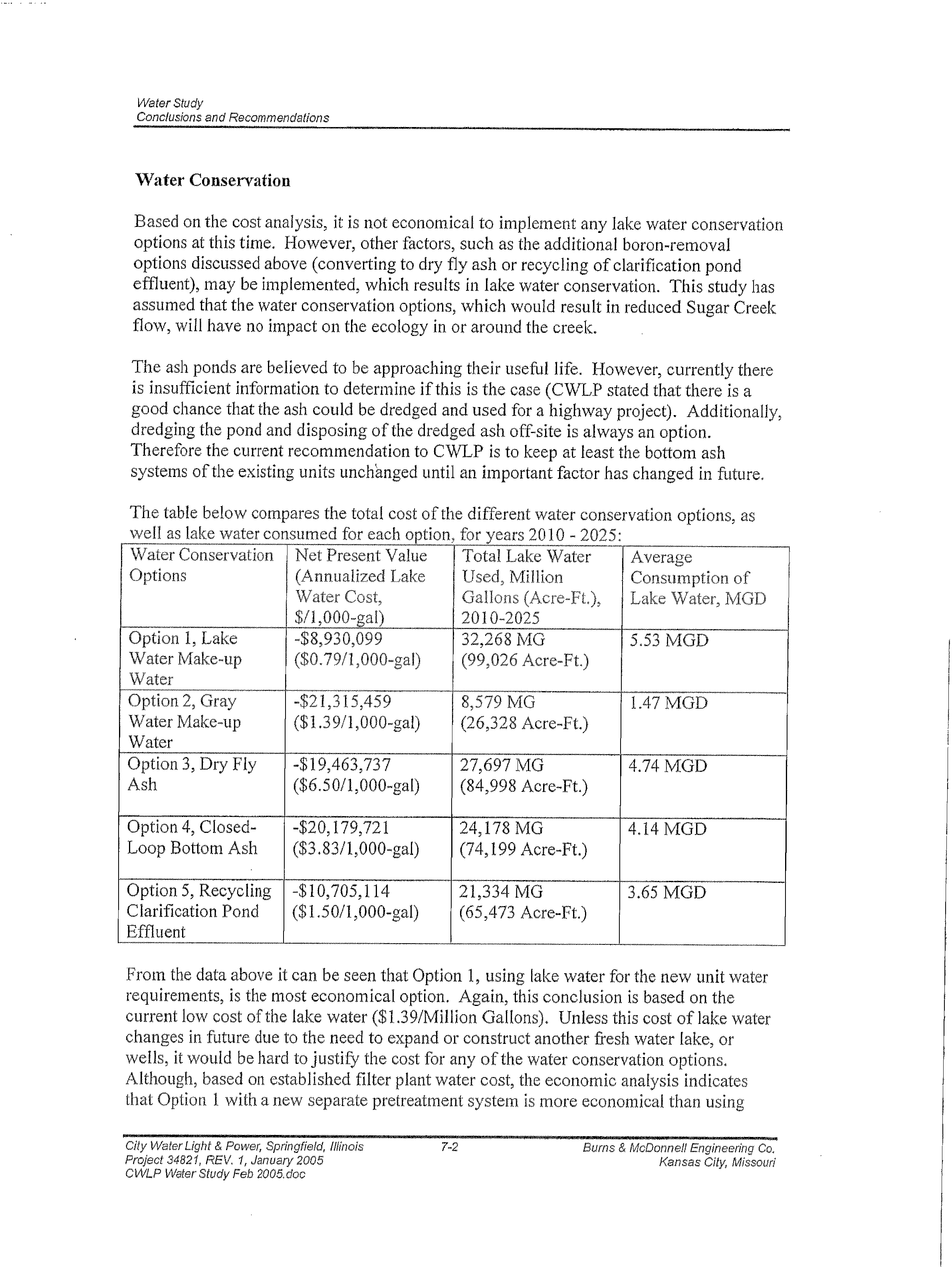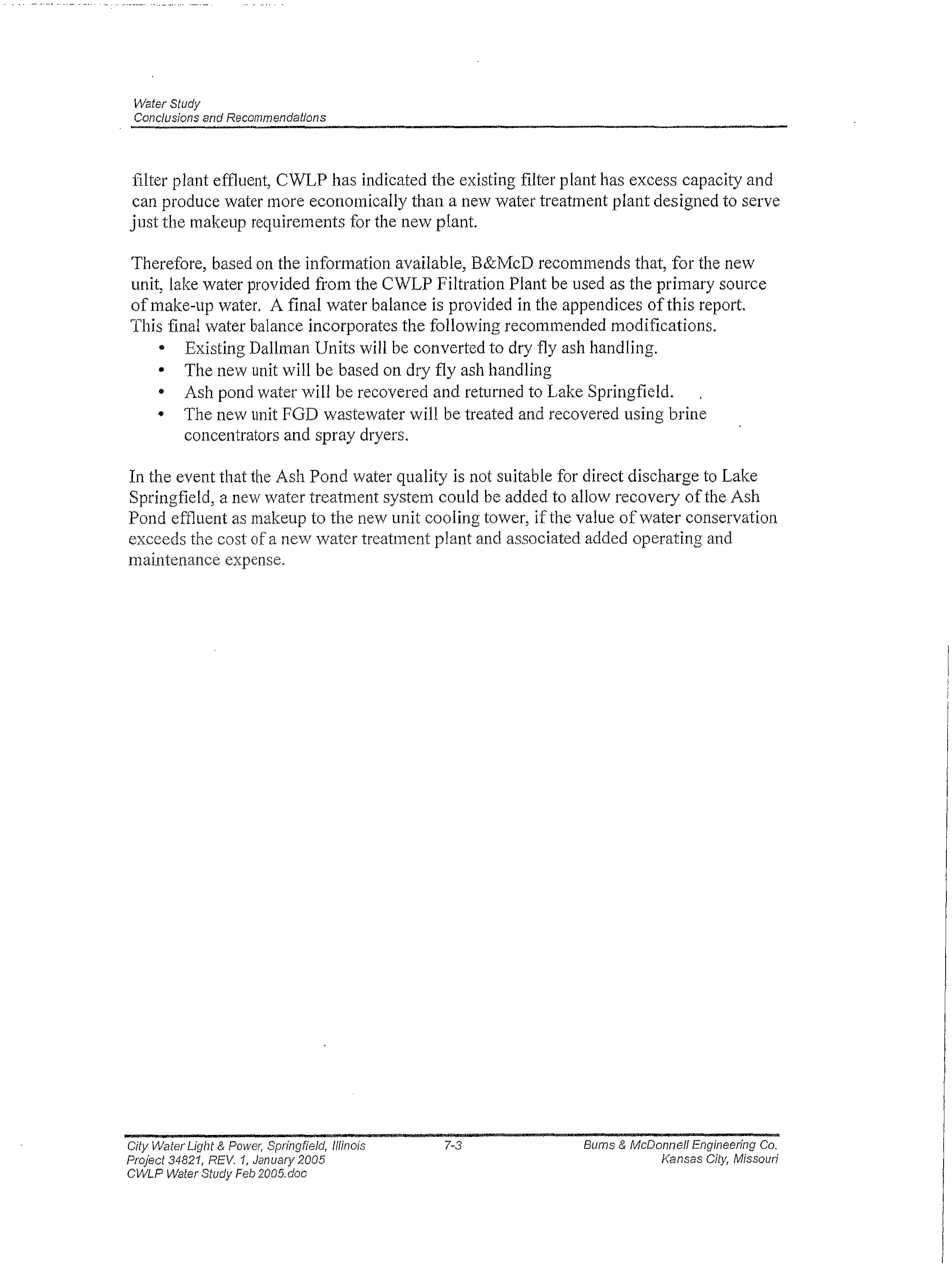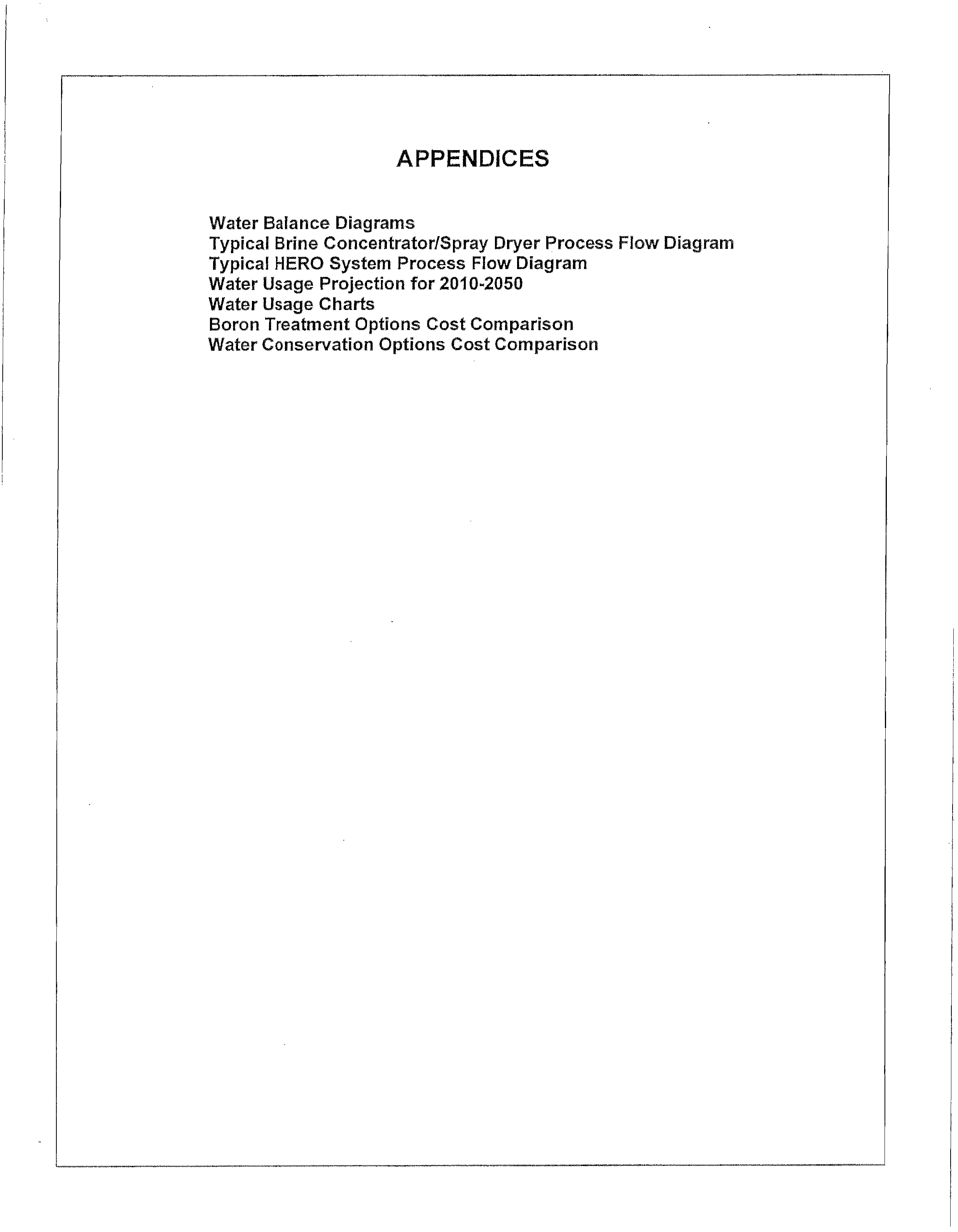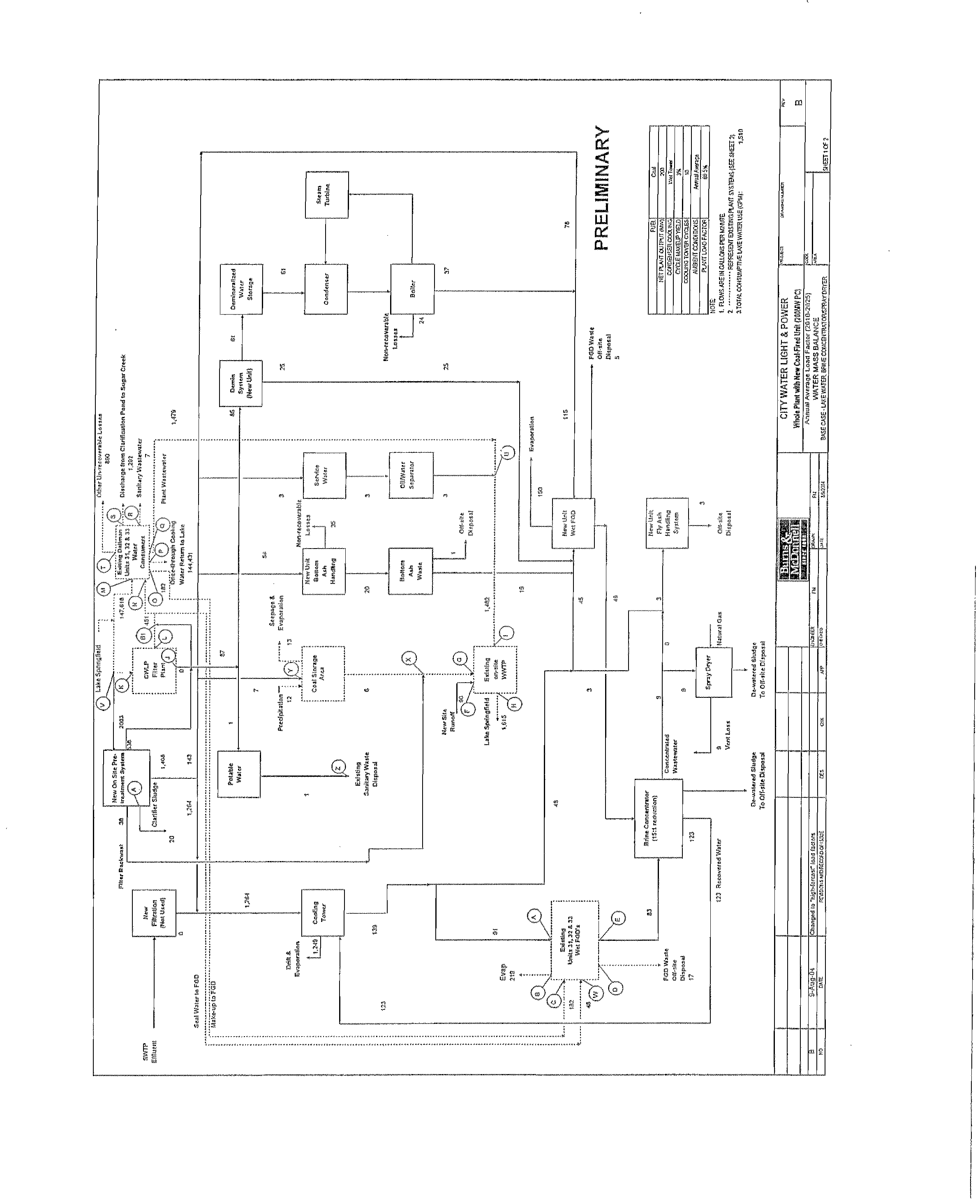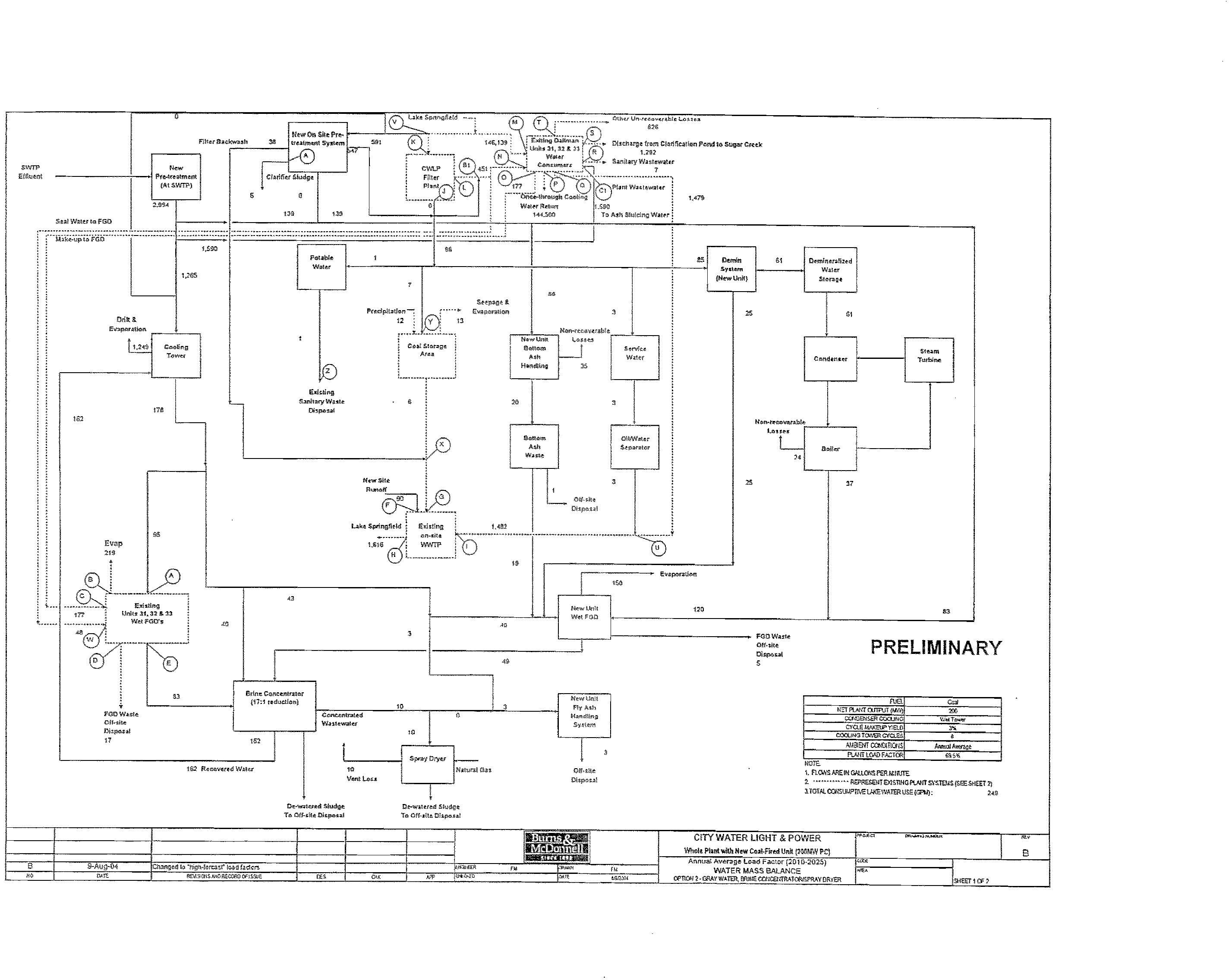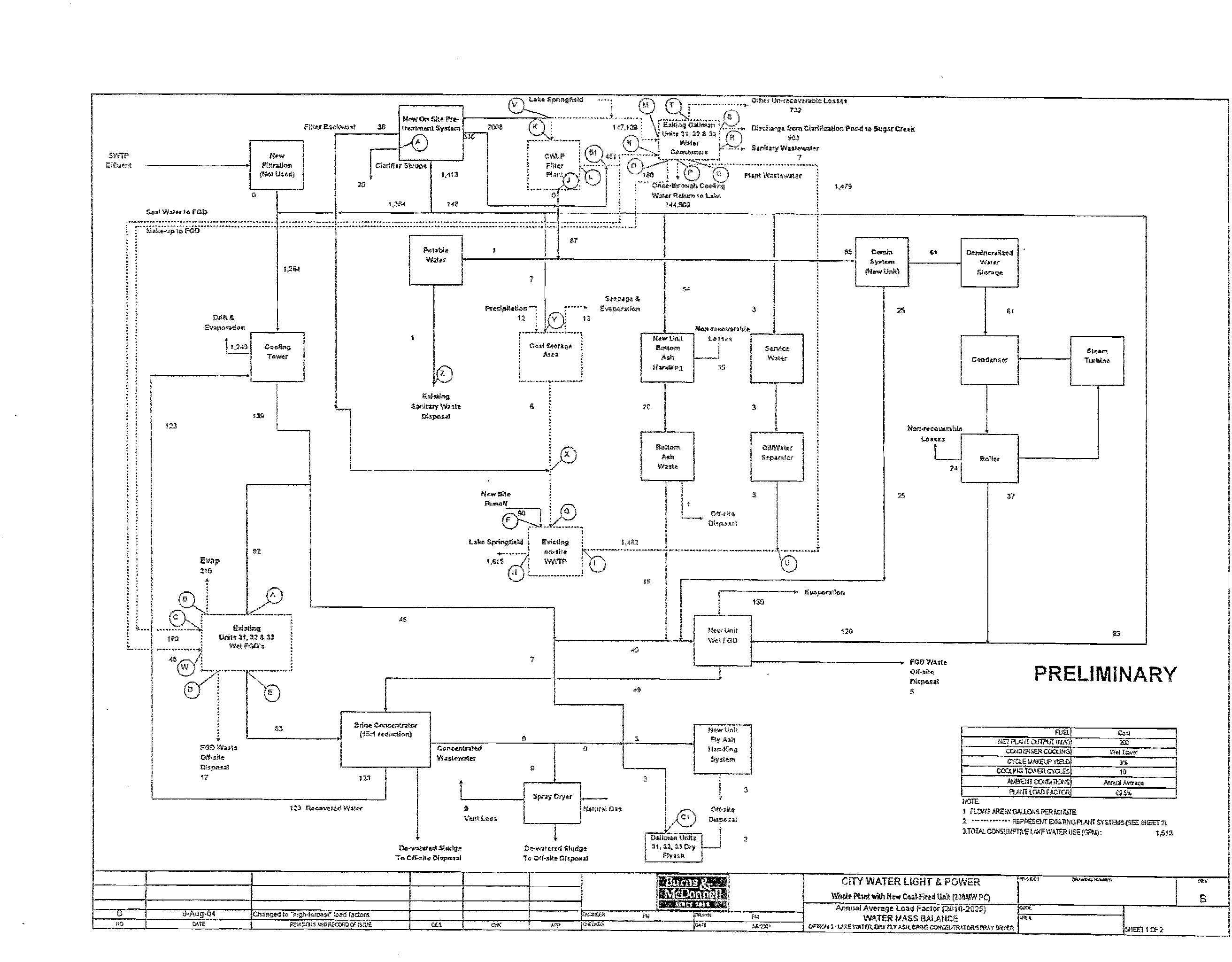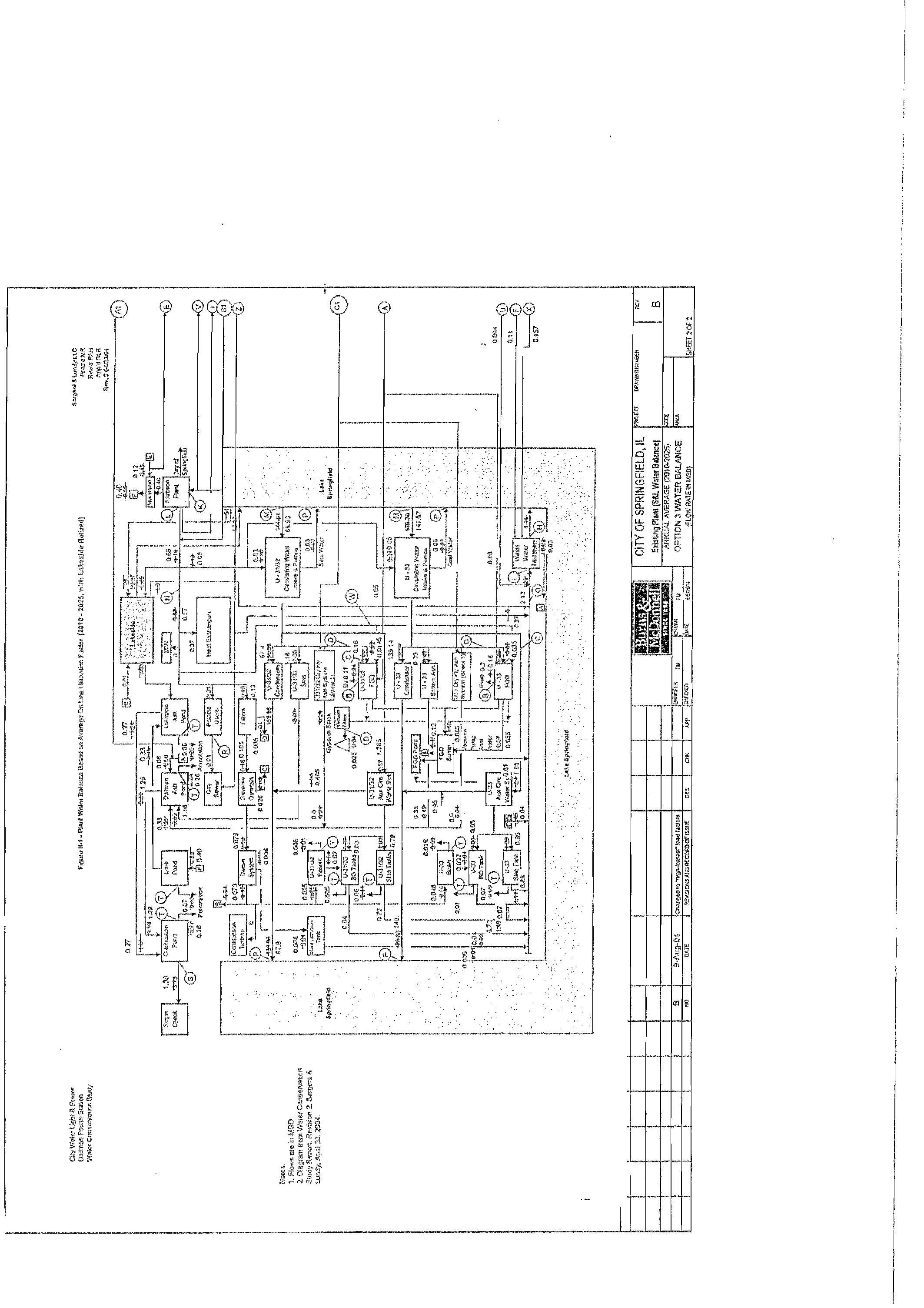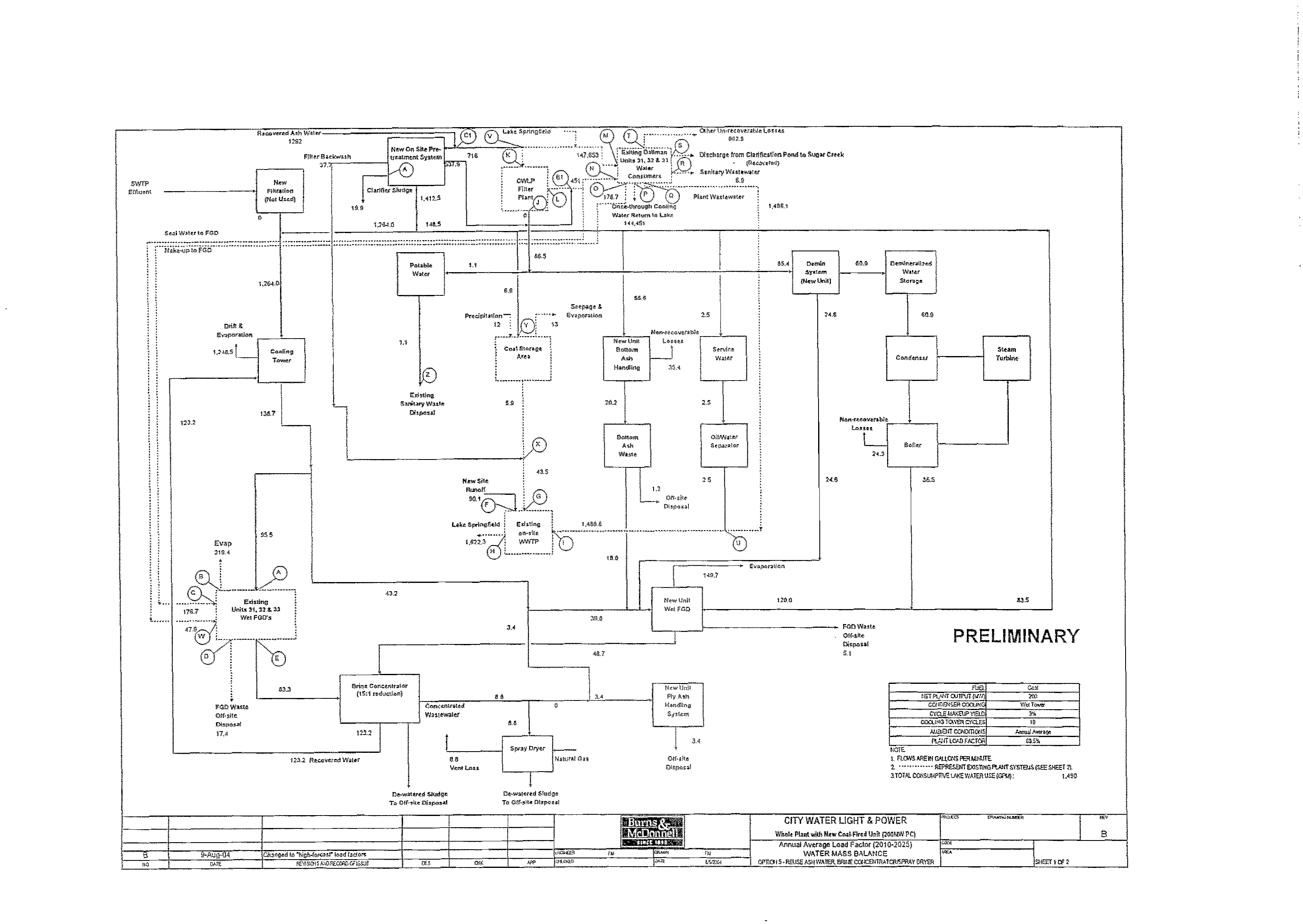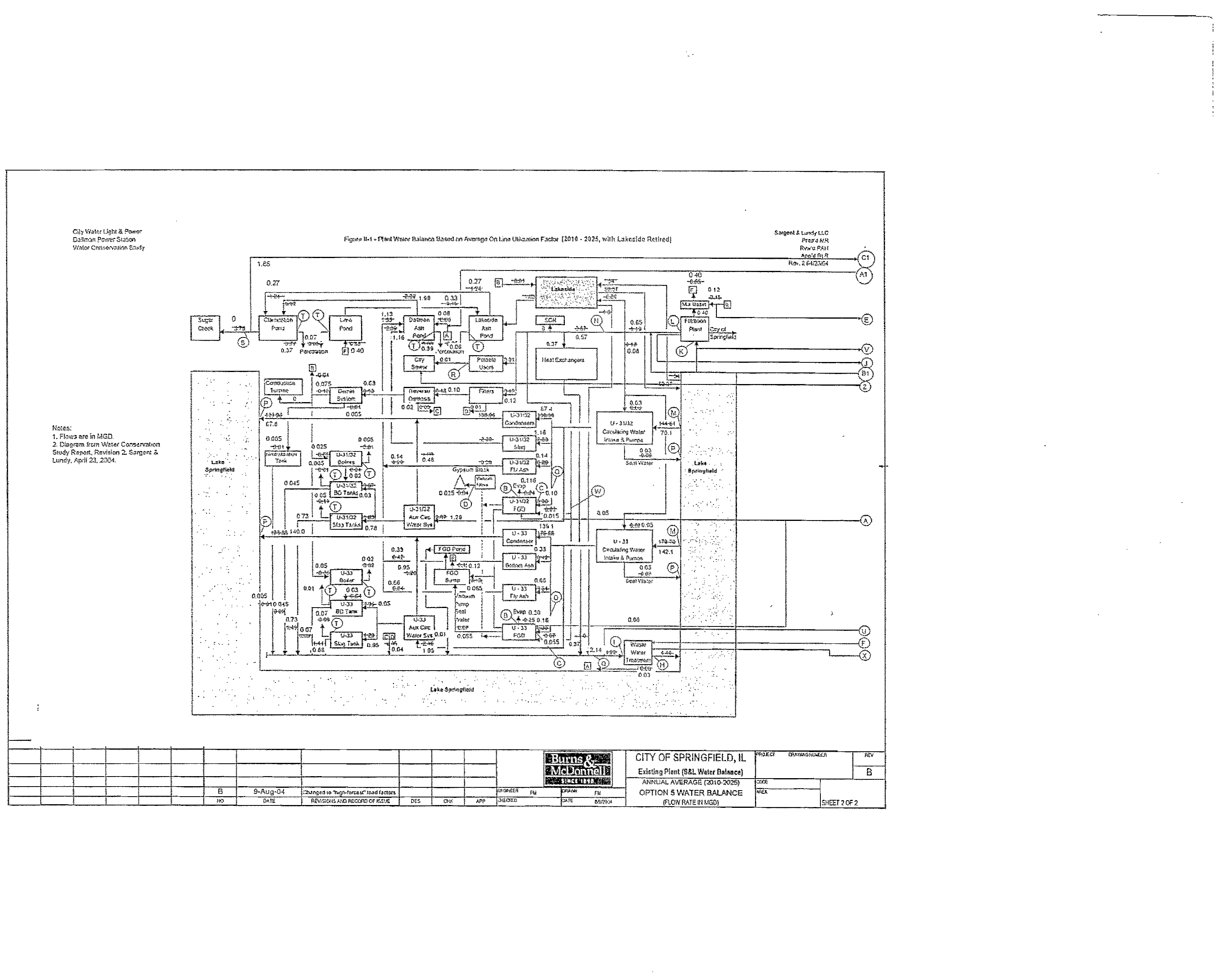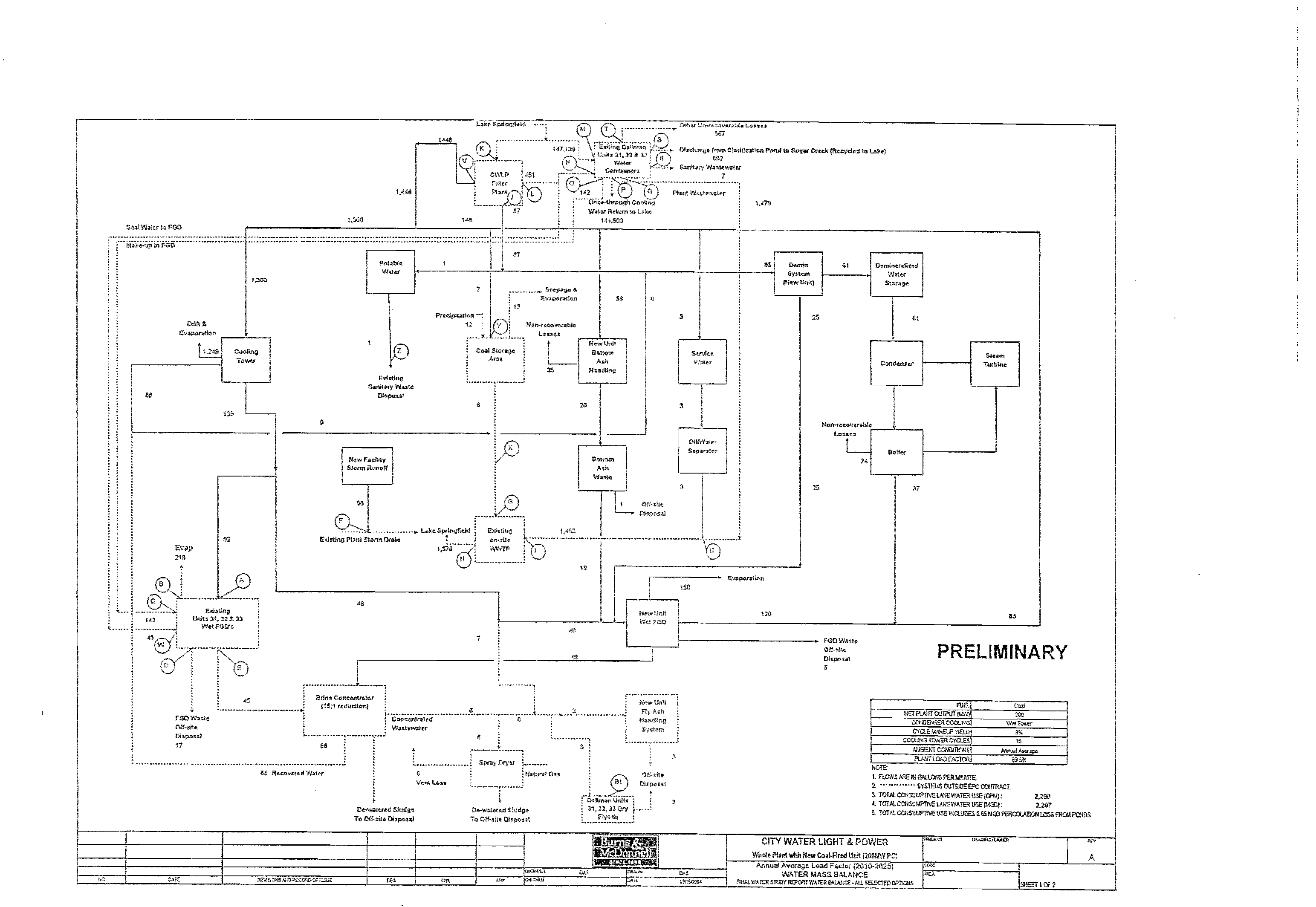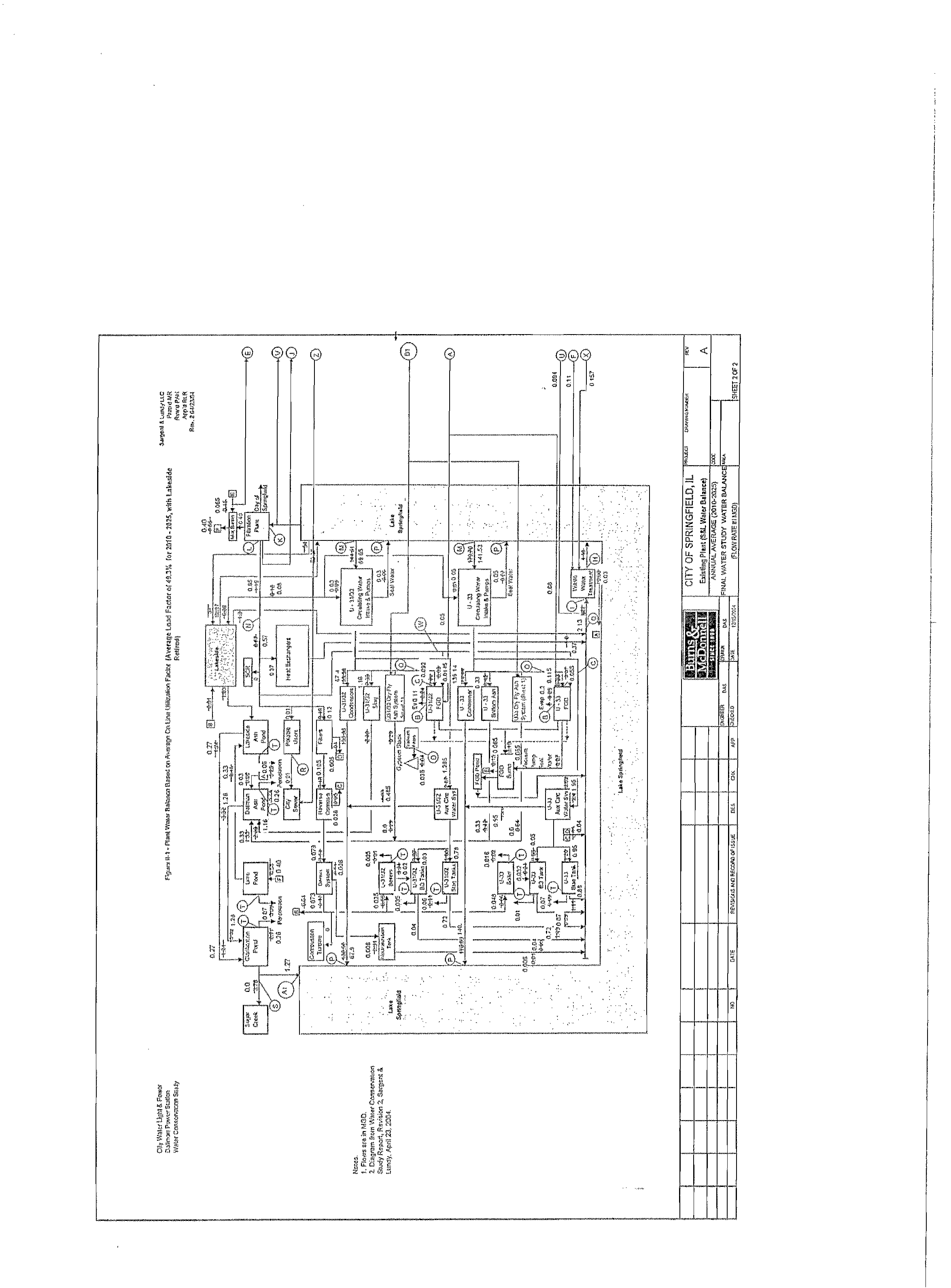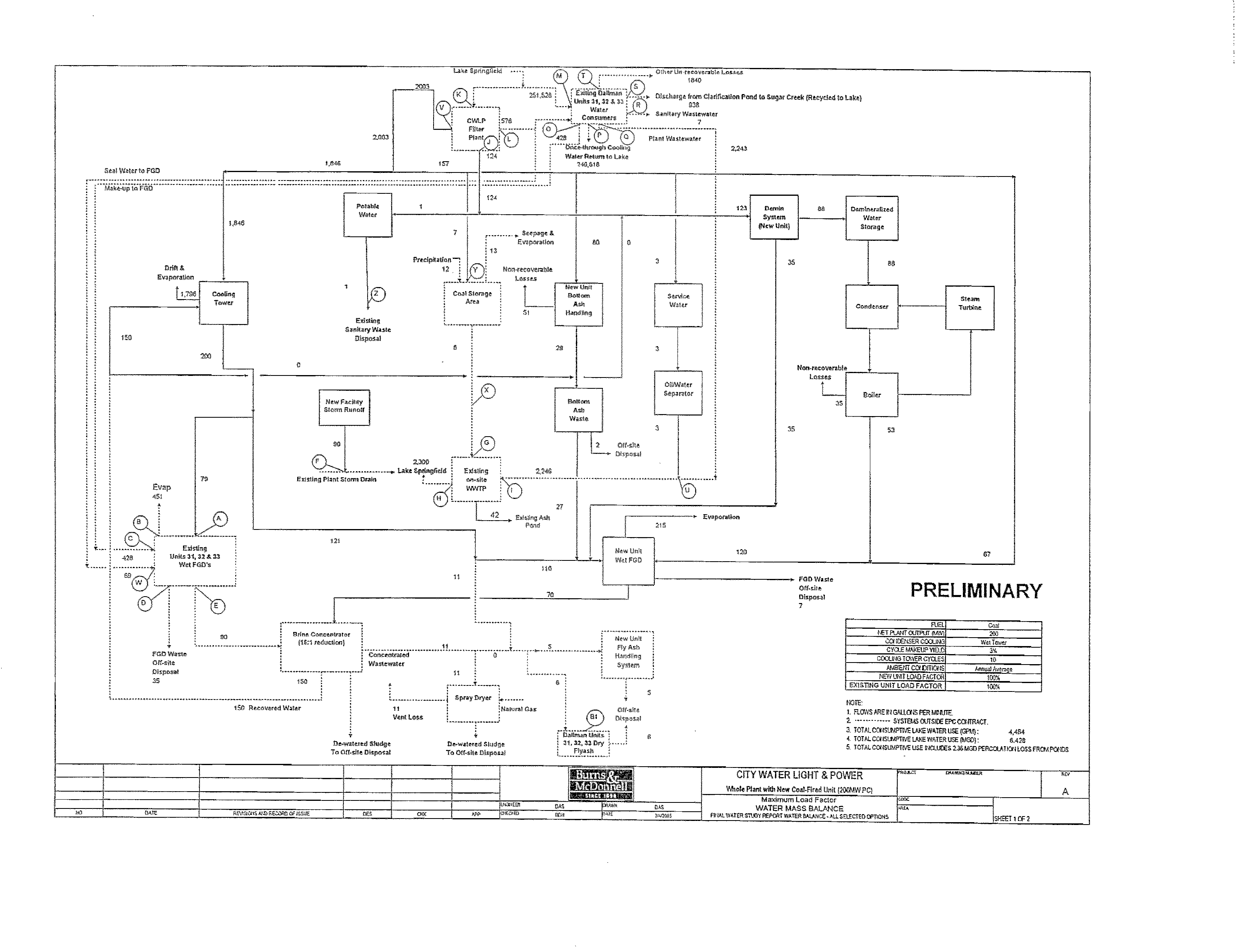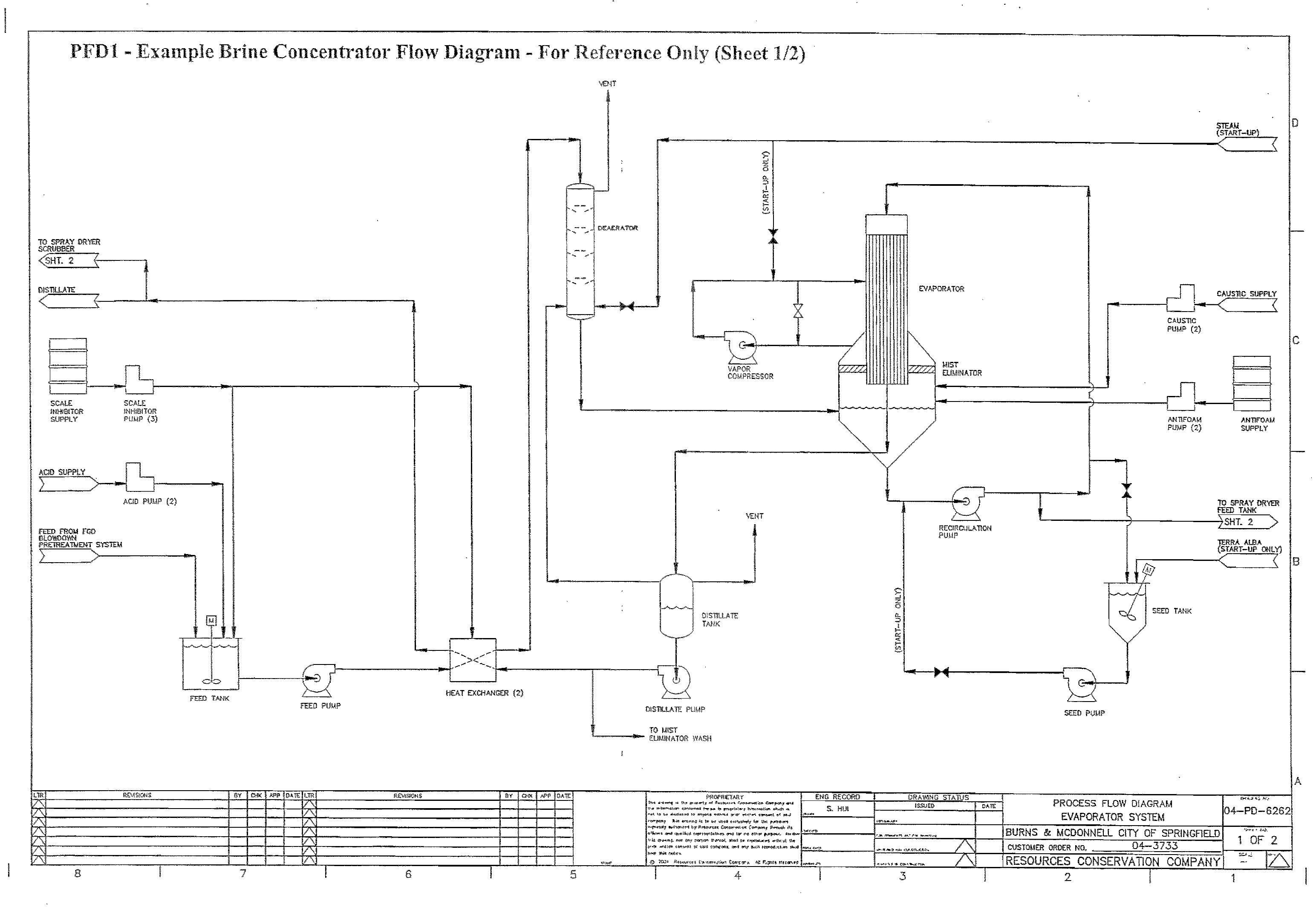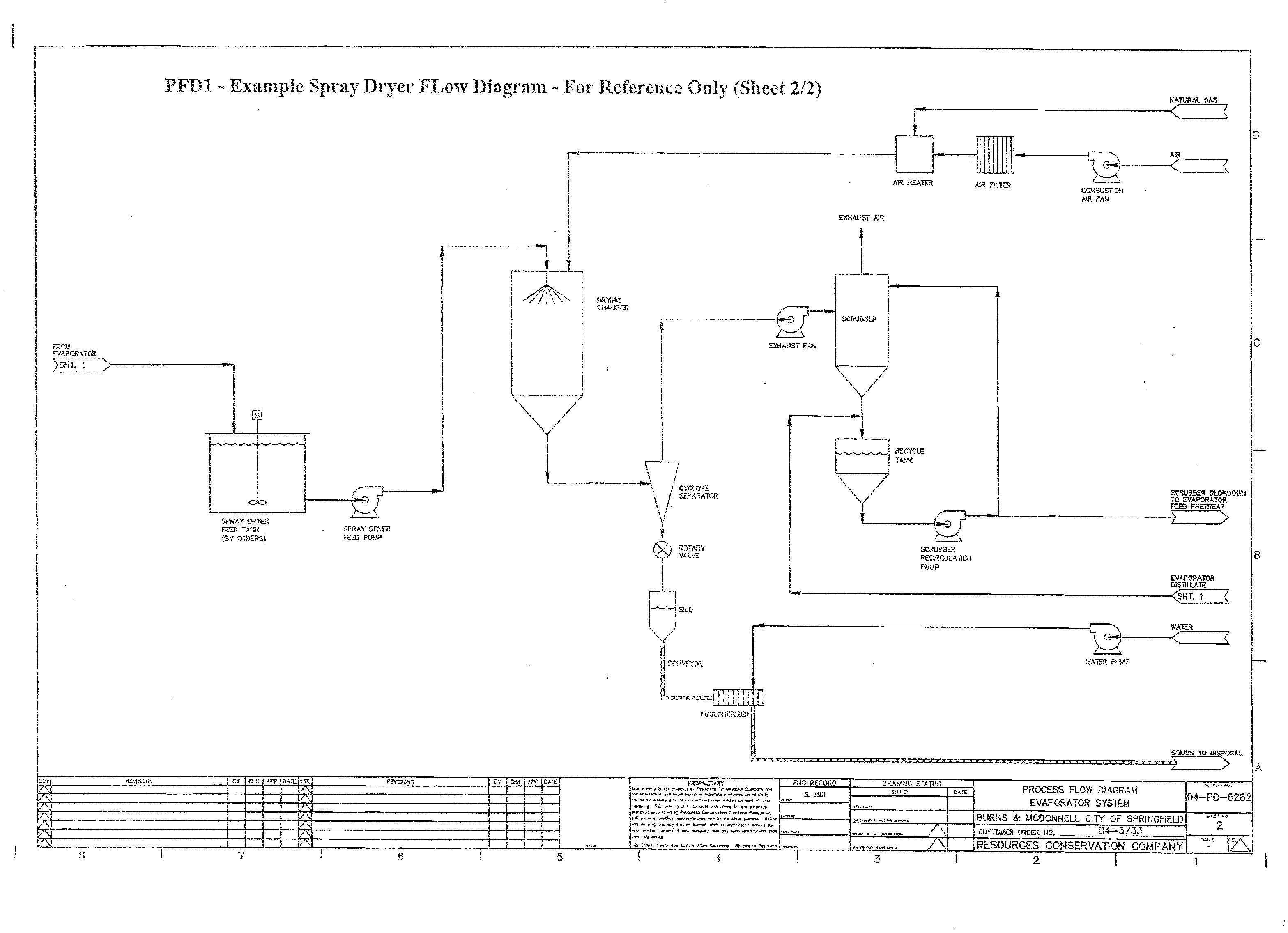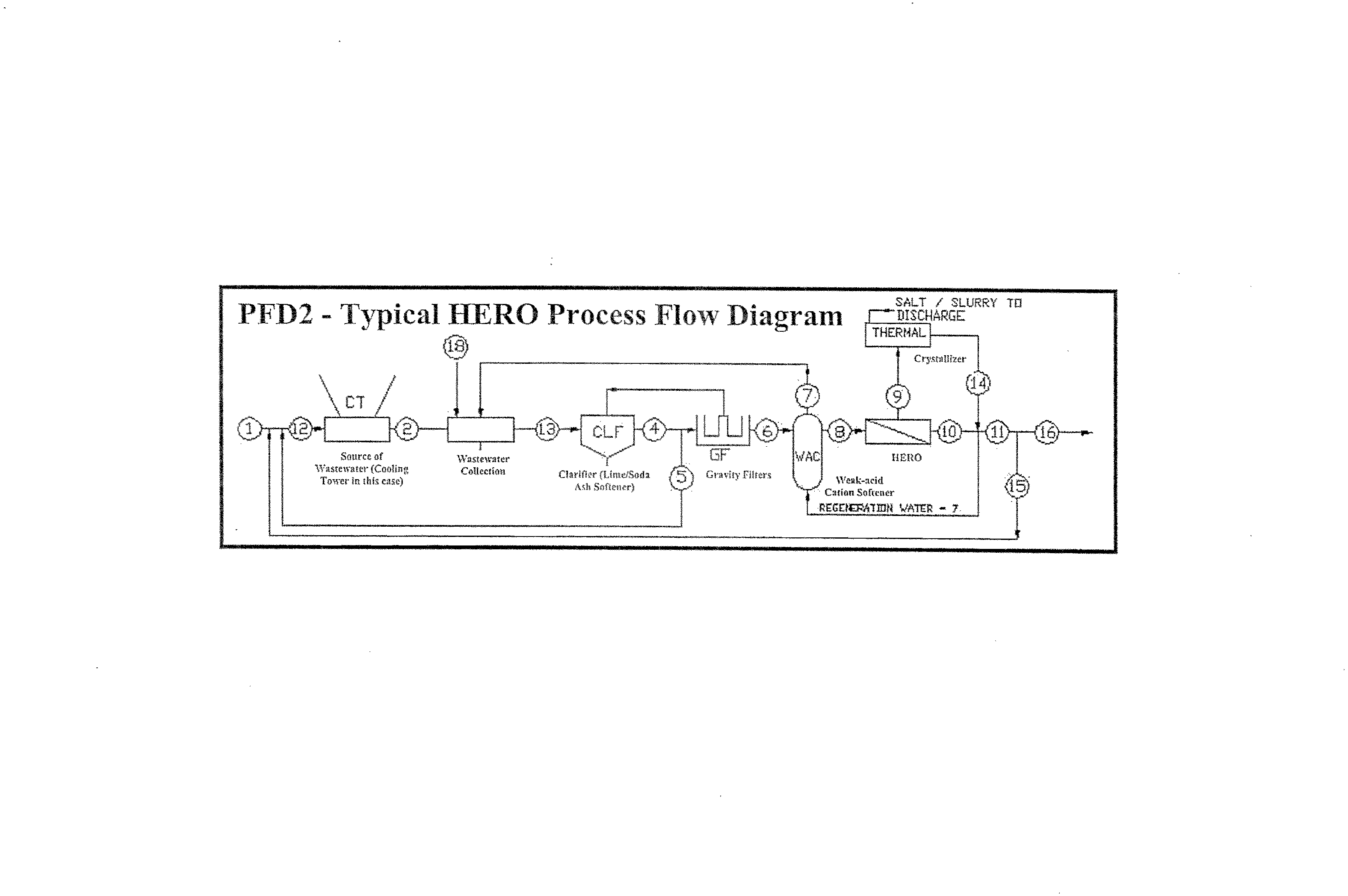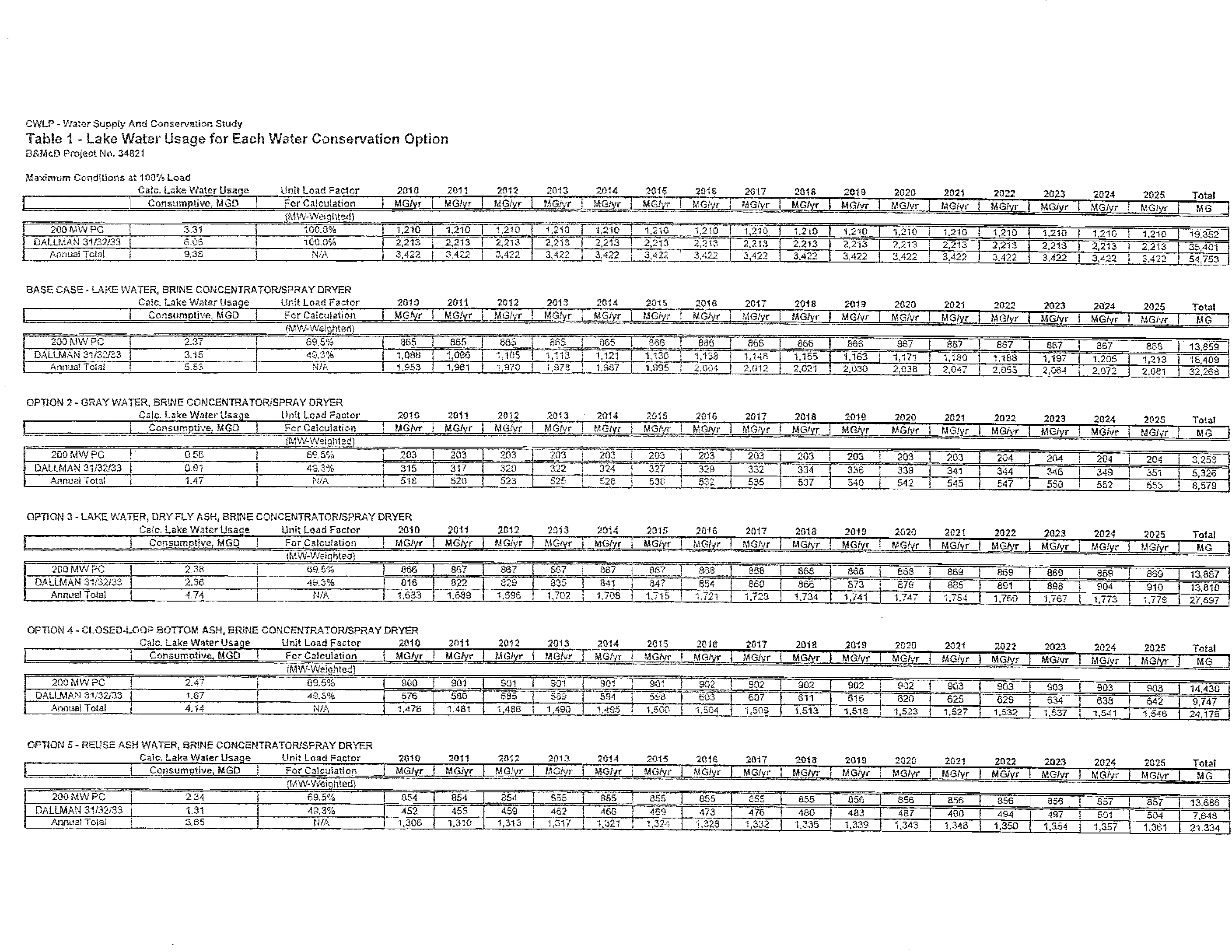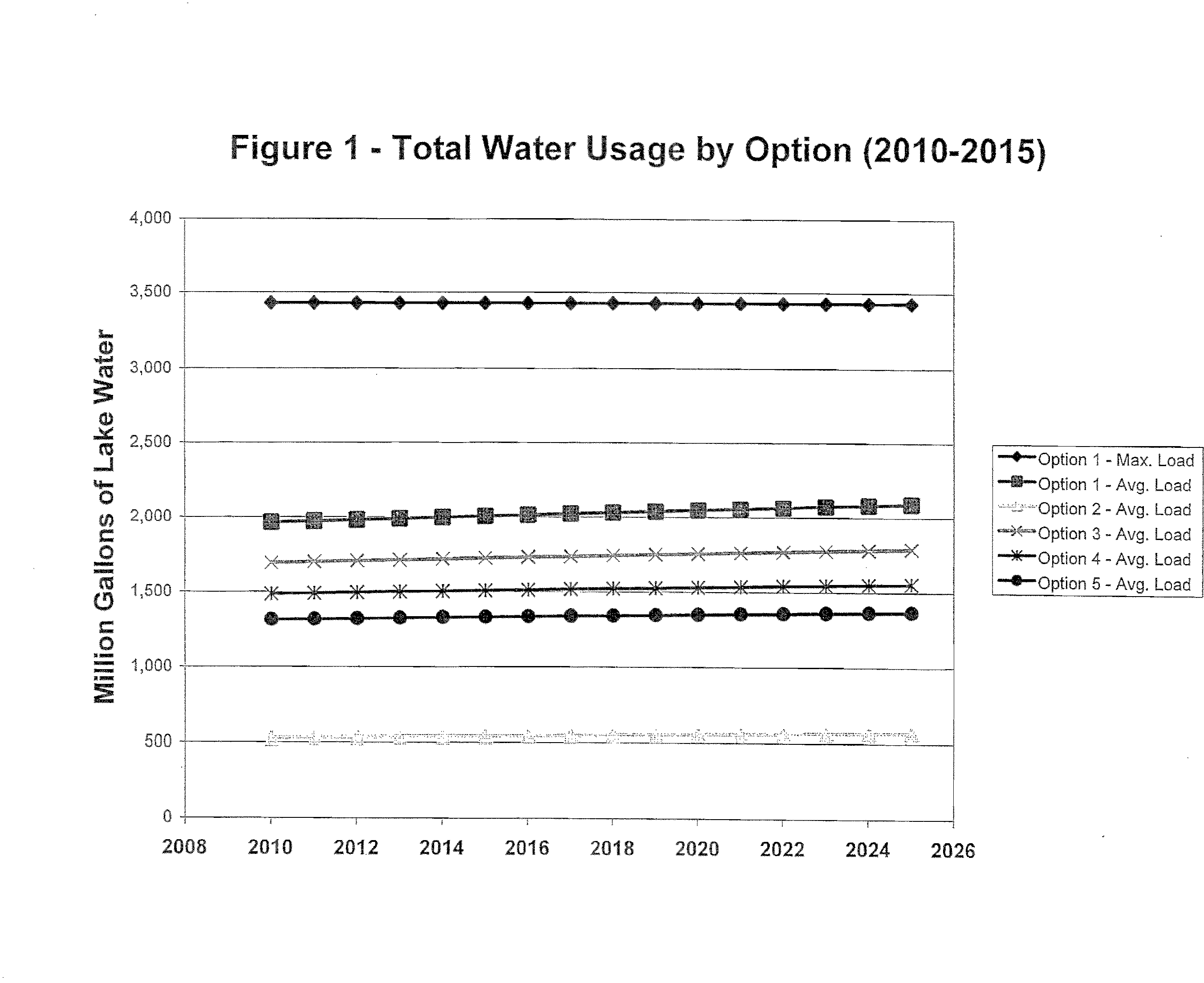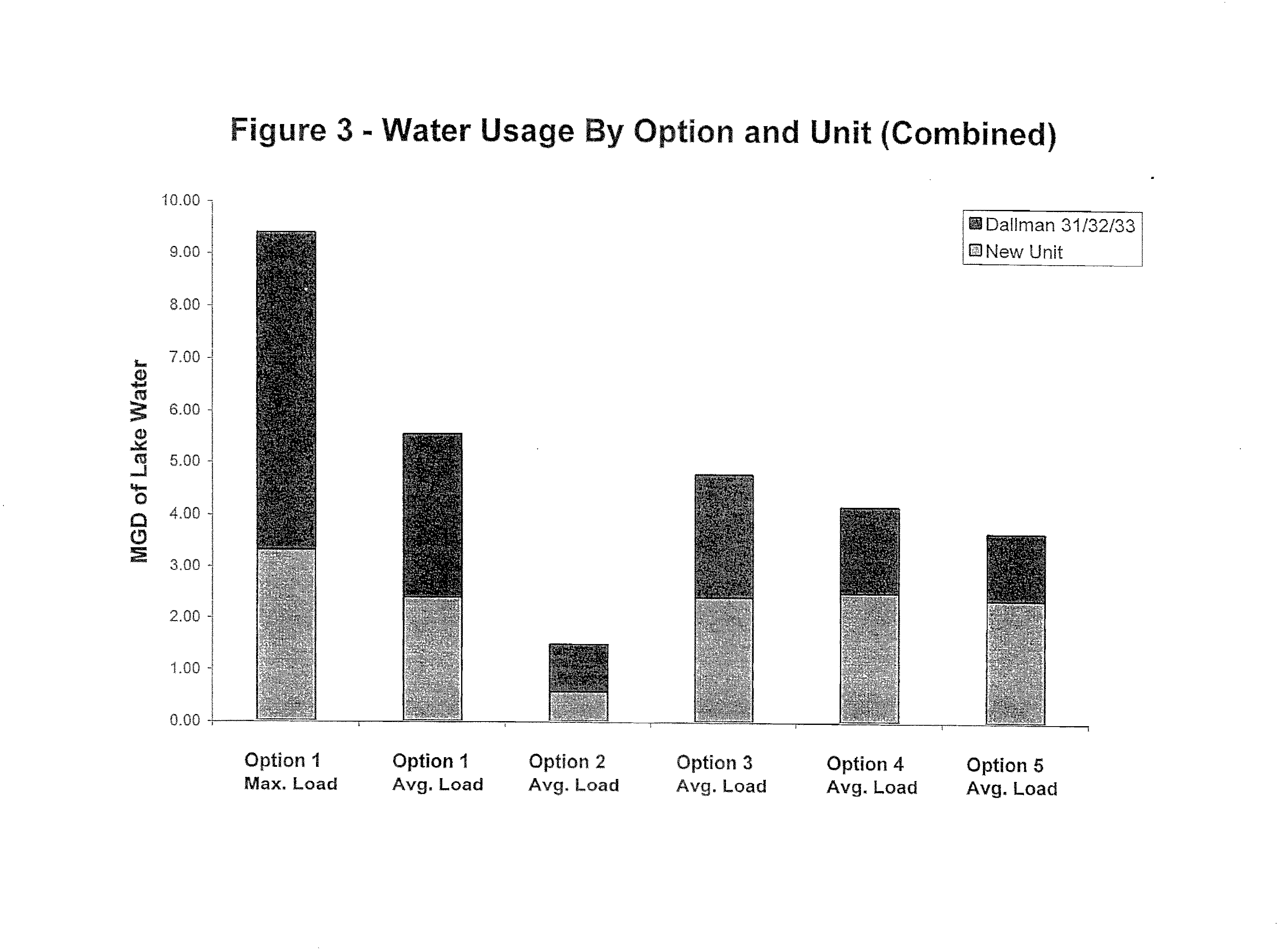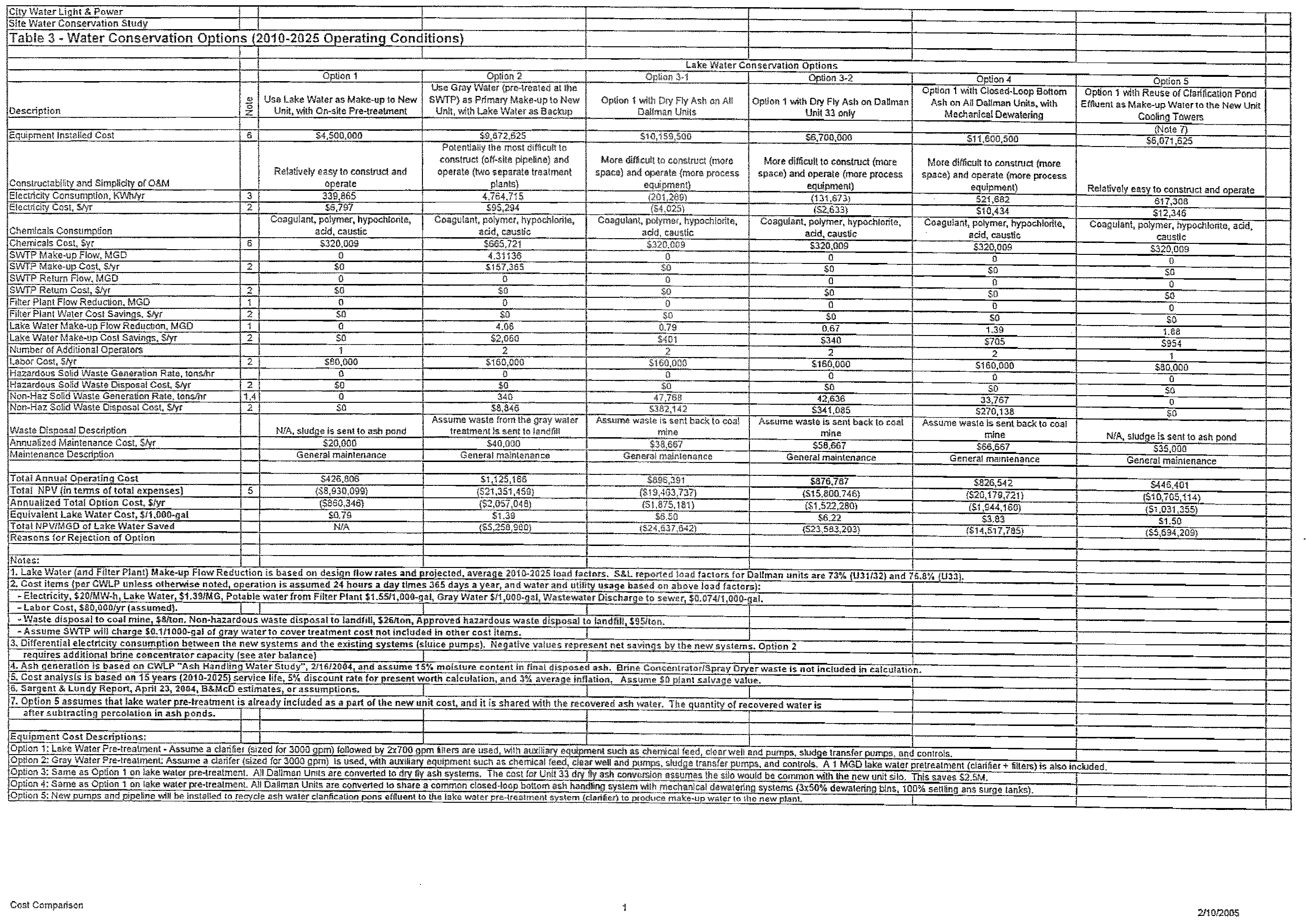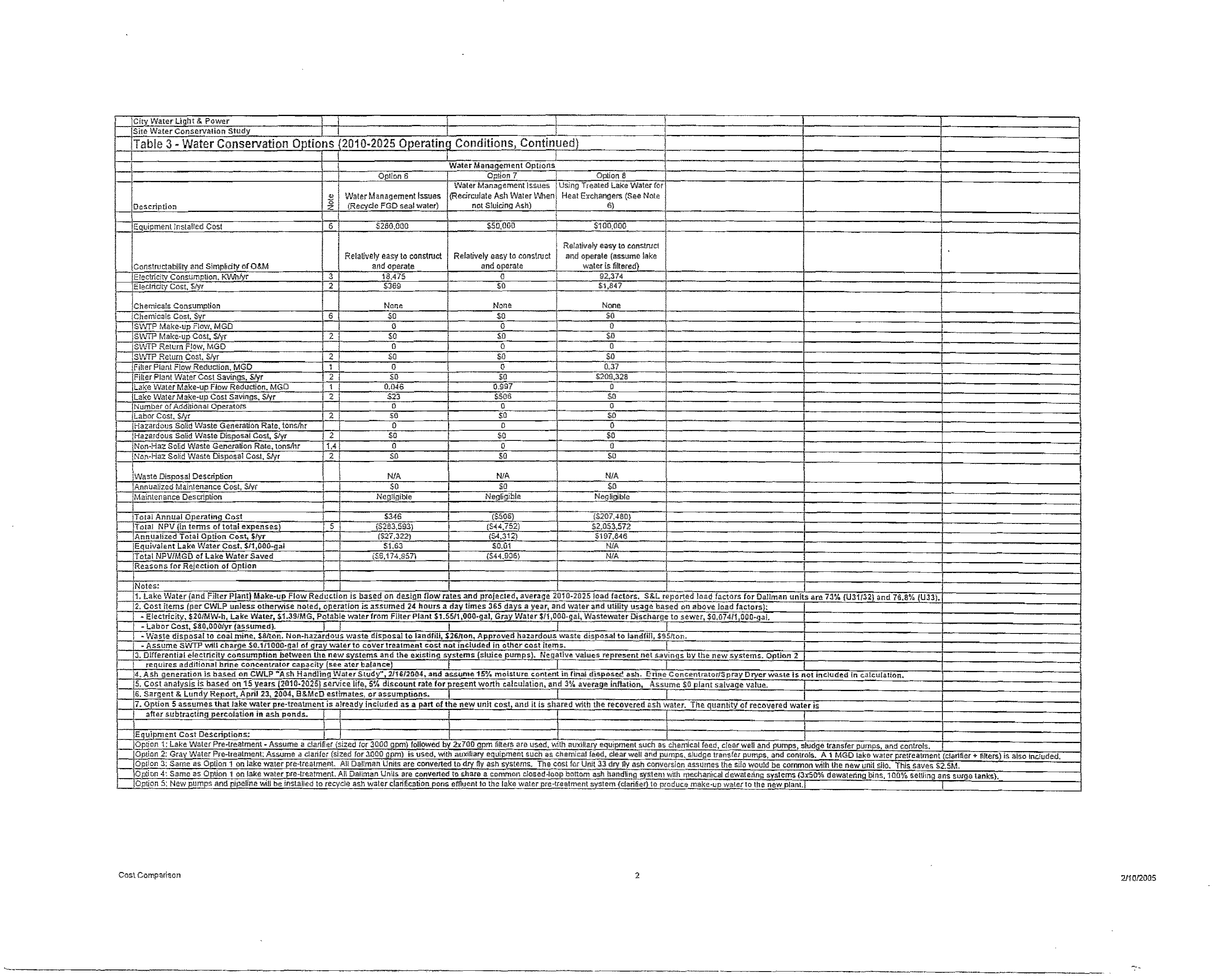ew Generation Project Water S
Electronic Filing - Received, Clerk's Office, November 21, 2008
* * * * * PC #1 * * * * *
Electronic Filing - Received, Clerk's Office, November 21, 2008
* * * * * PC #1 * * * * *
Electronic Filing - Received, Clerk's Office, November 21, 2008
* * * * * PC #1 * * * * *
February
11, 2005
3 100 Stevenson
Drive
City
Water Li
Mr. Brian
Fitzgerald
New Generation
Project
Dear . Fitzgerald:
f _.
'"!)
rd Amendment No. 2
elated De
:.
unbar
6, 20C1Q..
support
the addition of the
new electric
.-
performed
to ý<<idress wat(sul)ply,
boron
r.wmoval
and lake water
conservat
A ttachments
c
c:
Brian Basel
Electronic Filing - Received, Clerk's Office, November 21, 2008
* * * * * PC #1 * * * * *
-JY$(erJ9bldy
tndex and CedifNlan
C
ity Water Light & Power
Springfield, Illinois
New Generation Project
INDEX
AND CERTIFICA rION
PAGE
NUMBER
PART 140.
PART TITLE
FO
PAOFS
PART 1.0
Executive Summary
2
P ART 2.0
Introduction
2
. ý . .ý-_-PART 3.0
,- Water Supply
P
ART 4.0
Wastewater Treatment
PART 5.0
Options
2
3
3
PART 6.0
Evaluation of Options
23
PART 7.0
Conclusions and Recommendations
3
APPENDICES
Water Balance Diagrams
Typical Brine Concentrator/Spray
Dryer Process Flow Diagram
Typical HERO System Process Flow Diagram
W ater Usage Projection
for 2010-7050.
Water Usage Charts
Boron Treatment Options Cost Comparison
Water Conservation Options Cost Comparison
ICATION
7
2
1
1
3
1
2
Design Firm Registration Number: 184-001310
-
'"-CltkWeteiggd(APawaiý Spririyfeld,7gPriols
--R!0=1.._..._-..
Pr*c(34821. January 2005
Kansas ft Mlasoud
W8(erSWyCert
Page RUM
doo
Electronic Filing - Received, Clerk's Office, November 21, 2008
* * * * * PC #1 * * * * *
Water Study
Table
of Contents
TABLE OF
C ONTENTS
1 .0 EXECUTIVE SUMMARY.........................,...
2.0 INTRODUCTION..........,..........,...................
3.0 WATER SUPPLY ..............
...........
2-1
...,... 3-1
..................
3-1
4.0
4.1 On-Site Wastewater Treatment Plant....
... 4-
5.0
I
I .'!i' !' I,
Pro'.-i.Juý_
6.0 EVALUATION OF OPTIONS....
6.1
Wastewater Treatment Options...
6.1.1 Plant Wastewater Discharges ................ ,......... .........
.., 5-2
......
6-1
6.1.2 Ash Pond Discharges and Boron Removal Approach....
6.1.3
Boron Removal Options...
6 .2 Water
Supply
and Conservation Options..................
6 .2.1 Lake Sp
6.2.2 W itr
r
C;onserva
6.2.3 Wý<ler
7 .0
n .................
6 .;3.1 Boron-Remo
..6-11
... ....... 6-20
6.3.2 Water Conserva
C ity Water Light & Power, Springfield, Illinois
"TC)C-1
Bums
&
Mcbc,rn,-.
l
P roject 34821, REV: 1, February 2005
K&r, u iy Missouri
CWLP Water Study Feb 2005. doc
Electronic Filing - Received, Clerk's Office, November 21, 2008
* * * * * PC #1 * * * * *
Water Study
Table
of Contents
A PPENDICES
Water Balance
Diagrams
O ption 1, Using Lake Wýjtc-a with No Water Conservation Options,
Maximum Flow
Option
1, Using Lake Water with No Water Conservation Options,
Annual Average Flow
Option
2, Using Cray Water, Annual Average Flow, Annual Average
Flow
Option
3, Using Lake Water with Dry Fly Ash, Annual Average Flaw
4 Option 4, Using Lake Water with Closed-loop Bottom Ash System,
Annual Average Flaw
Option
5, Using Lake Water with Recycling Ash Pond Effluent, Annual
Average
Flow
F inal Water Study Water Balance - All Selected Options
Final
Water
Study
Water
Balance --All Selected Options (Maximum
Load)
PFD1 - Typical Brine Concentrator/Spray Dryer Process Flow Diagram
(Sheet 1 and Sheet 2)
PFD2
-
Typical HERO System Process Flow Diagram
Table 1 - Water Usage Projection for 2010-2050
C ity Water Light & Power, Springfield, Illinois
TOC-2
B urns & McDonnell Engineering Co.
Project 3482?, REV. 1, February 2005
Kansas City, Missouri
CWLP Water Study Feb 2005.doc
Electronic Filing - Received, Clerk's Office, November 21, 2008
* * * * * PC #1 * * * * *
Water Study
Executive Summary
1 .0 EXECUTIVE SUMMARY
treatment system options
tewater
production rates.
to study water conservation
o
t the Ntevenson Drive generating
porate the results
of
the pr
loped that
sis of var
t water source is treated
economics may change which may
i1:j''. e
ý 'o ns to implement to aid in
finalized.
discharged from the plant. Because o
ise the exiting city fihc. c
plant
has suffic
new generation facilities'
up w¬aý:r cteýzl, ýýid.
Thus city water treatment plant treated
water is the recommended water source.
us boron mitigation studies indicated that the major source
of boron
exiti
liquid blowdown from the Dallman 31, 3'2 and 33 FGU systems. Alternatives for
treatment
of this water stream were investigated during the
water study. The preferred
ndary option
ystems from
r Light &
821,
REV.
1,
E
®1
r Study Feb
B ums & McDonnell E-!7in,-nf
-7
Kansas City, (:ii:soud
Electronic Filing - Received, Clerk's Office, November 21, 2008
* * * * * PC #1 * * * * *
wet to dry handling to
ree of boron that i
it
reek, In
p ond water for makeup to the
new uni
lowdown treatment
equipment
oundwater contamination and ash pond life expectancies
ash
from
the ash ponds.
The
would need to be conducted to determine if this option is feasible. Additionally,
a study
should be conducted on the effect of the existing fly ash content of the ash ponds, as well
l
andfill
leachate, on the ash pond and ground
B esides the recommending boron removal and/or water conservation options, urgent R
ded recycling the FGD vacuum pump seal water. This
being
made by
eludes
a zero
discharge FGD
followed by two
Unii,, i o dry fly ash
Ice-up be
recotr
Tit,-
i
I
c,-, i j
Awntr _ttors and
In the c-,rent
that
the
Ash Pond water quality is
not suitable for
direct
discharge
to Lake
Sprirzi_ iiuld_ a wastewater treatment system could be added to allow recovery of the Ash
Pond eftlucat as makeup to the new unit cooling tower for water conservation.
B urns &
Mchonneýi Ei7gine
r,-nq
C;o.
h=r. -
s
;'Y. Výscluri
Electronic Filing - Received, Clerk's Office, November 21, 2008
* * * * * PC #1 * * * * *
2.0 INTRODUCTION
&McD) to p
new generation facilities at the Dallman Station. The study investigated the availabil
and :Feasibility of water supply sources required for the planned
new coal-fired unit (200
followin
wastewater treatment concerns;
2004 report.
r
,-:ý
o
,'the
r C f ý.
Iti",Jtl'
b
Tn `1:
,(1'tiri the c ;J:t't)glfiiii", e'1-, ,1-thybent,ti I
d y,
Report L-008254, Sargent & Lundy, April 23,
v,irious
p1
ý!I < ýý ?ýh water
streams,
u,1
provided sevei A recommendations to CM'[,P to
reduce boron concentrations in thei
installed SCR
equ
Potentially feasible boron removal. options were identified and evaluated
and three
potentially viable options were selected. The net present value of each o
calculated
based on estimated installed equipment cost,
and annual operation and
Based on the net present value analysis, and other factors, a pre
cted
as the base-case option. This base-case opti
t l on o
r Light
Project 34829, REV. 1,
C WLP Water St udy
Feb
2(705.
Electronic Filing - Received, Clerk's Office, November 21, 2008
* * * * * PC #1 * * * * *
Water
Study
Introduction
Additional methods for conserving take water were reviewed. Three possible water
tliods were selected
for
further study.
These options, combined with two water supply options (Lake Springfield and the gray
water), formed the five options studied to provide far the plant water supply and water
. A. water balance was prepared for each of these live options, and water
as calculated. `eater conservation options were then evaluated u
these
op
lesions and Recommendations) of this
report.
Electronic Filing - Received, Clerk's Office, November 21, 2008
* * * * * PC #1 * * * * *
Water Study
Water Supply
3 .0 WATER SUPPLY
W ith the addition of a new unit at the Stevenson Drive plant site, the water source to
this
operation
must be
chosen.
This section of
the
Water Study report discusses
.'I Lake Springfield
Lakeside
and Dallman Units. It
The
consumptive loss of the lake water far condenser cooling.
of the lake water far the existing units is
a i-111 rn[W : .iur. a ''Cli.. L'lIII
w
ater.
V
L ite DC VV
u-
ump
lant use without requir
. S anitary Wastewater
T
reatment
E
ffluent
(Gray
Water)
The use of gray water as make-up water to power plants is b: corning a mor, widely used
method to conserve ri-esh
water. Although
this type
of
ý:Ii. <,.1
ýn has
w .,.I
problems at some f 'shies, there are several successful cG ses of gray er reuse. The
use of gray water
Lt: ý UpWciat
concerns in the operations and maintenance of power plant
which is the fresh water supply
snore valuable due to growth in demand,
ling
and corrosion within
n ,-"is to be rc:,,,oved by bleu,- town.
ad:";ti, r,:.,1 treatment
if
ant
ýe r vice
water arid
ities exist to provide the lake water to
r plant, Water from the city high
Electronic Filing - Received, Clerk's Office, November 21, 2008
* * * * * PC #1 * * * * *
Wafer Study
Wafer
Supply
t is important to mi
is
located about 3 miles away
ruction of a pipeline to bring the gray water to the site would be
is would be costly and thus is a disadvantage
compared to using the lake
water as make-up water to the new
unit. However, the use of gray water provides
ianificant
reduction of consumptive use of the lake water.
nificant total organic content
and solids content still remain that could cause problems
with reusing gray water result from
h igh potential
for biological
deposit or microbiologically
content
(d
p roblems
associated
i
Light E Power, Springfield, Illinois
3 -2
Burns ? McDonnell E
ngin
1 , REV. 1, February 2005
Kansas
City, Missouri
s t of the suspended solids and organics in the incoming
water are removed,
b 2005.doc
Electronic Filing - Received, Clerk's Office, November 21, 2008
* * * * * PC #1 * * * * *
Water Study
Wastewater
Treatment
4.0 WASTEWATER TREATMENT
T
here
are
several types of
wastewater
streams
generated
from
various plant systems.
they
fall in three
consists
of
wastewater
streams
that can
be
. The
third type
will be
a
ess than the FGD blowdown and can continue to be treated
nd currently the FGD system blowdown. This
S ugar Creek. The boron content of the ash
ily the FGD system blowdown. This
of
boron and
cannot be discharged. This
4.1 On-Site Wastewater Treatment Plant
Dallman and Lakeside Units share a common on-site wastewater clarifier
wastewater streams from the site, processes them
afer to Lake Spr'- ;,field. Th_ ti f:,tment syst-,i-, k
ponds using lake
not
rerno;-e any signifc
.
',;mount of dissolved
:-r-ttd t
r (ý,
arm , Sttch ^s th- FCT3
n 1,1owdown, are n, ,t ,a[:
water supply. The second
6
1r _S would
cause.
i
s uspend,
systems.
The treatmer (pt , o t provi
lake
water or the mitigation of boron dischn)
h plant service water drains, should be able
to
share the common wastewater
clarifer treatment
facility.
However, modification
of
lant N
streams e:_uld be discharge through the existing wastewater clarifier treatment facility.
The disch<ti Ye from the wastewater clarifer plant is directed to Lake Springfield, which is
the rev, ,,: ttcr -supply source to the plant. Thus the wastewater streams treated by
the
wastewater treatment plant are not considered consumptive losses froze lake water.
4 . Ash Pond Discharge
. {ail, float
fication pond.
At
this
stage,
chemi,.i 1
Its in settling; and separation of mos`
ifed water overflows to Sugar Creek (via autfall #004).
ischarge has periodically
exceeded the discharge
Electronic Filing - Received, Clerk's Office, November 21, 2008
* * * * * PC #1 * * * * *
Water Study
Wastewater Treatment
occurred when the plant SCR system is in service (average concentrate
Hanson's study report). The higlh,:st concentrations of
boron
are prom
the
blowdown streams (2010-400 ppm). However, ev
levels have app
ro«,ýftad
the discharge
s ource of boron contamination (40-50 ppm).
d analysis, that eliminating the fly ash sluicing
eters,
t he
baron
discharge problem. Because the p'GD blowdown has much hi
than any other wastewater streams contributing to the ash pon
CWLP personnel have expressed concerns th
ý,:
'ally dur
,e boron are
ru
r<<oni,i Maya
a.;1-1,-nciI in;rt a. dry
system.sexper
indicates that the fly ash
sluicing water
the largest
treatment options for
which boron, as
likely and reliable o
indiscriminately removed (separated) from the water.
in
dissolved
solids,
and may
be
reused as make-up water with
mnf."Alp
r.t :;icw,.ýter
(e.g.,
prcr=: t_,ss.
of th i
Common
zero-discharge processes
i
f ed) must be further treated in a
brine concerti It
it bi,A
to a sol
i: ý n n ý r f- ,!turers have suL
'roject 3 4¬321, REV. 1,
C WLP Water Study Feb 2005.dcac
Electronic Filing - Received, Clerk's Office, November 21, 2008
* * * * * PC #1 * * * * *
Water Study
Wastewater Treatment
allizers may not be able to completely convert the wastewater to a
solid waste.
ever, if an RC} system is used, the proper treatment of the RQ waste brine
crystallizer due to cost as well as the difference
it
the
water
chemistry
after an RO
system.
in this report.
The
high for these systems. The disposal of the solids
from the zero-discharge treatment equipment could be costly, too,
s idered hazardous. This is not typical but high levels of
a
hazardous
material
classification
which would cause the
al expense to go up significantly. Potential constituents of concern
and
boron. Thus, zero-discharge options are normally not economical options far
water conservation, but necessary means to meet discharge limits - in this case, the
boron
discharge limit.
C tfy Wate7ight &
Project 34821, REV. 9, FeLru-,
i,,
ý
,1
cnginee
C ity,
C WLP Water Study Feb 2005.doc
Electronic Filing - Received, Clerk's Office, November 21, 2008
* * * * * PC #1 * * * * *
5.0
OPTIONS
for w ater c onservation a nd boron m itigation involved t he review of
i
dentified options. New options were also considered and evaluated if
they were considered feasible.
5 .1 Previous Study Options
5.1.1 Water Conservat
In the &L study; several potential water
conservation op
as follows:
a sh handling systems
(3)
Dry
(4) Sanitary wastewater
trc-;ýtment effluent as additional water source
(S) Recycle of ash pond e I
i
luent to Lake Springfield
(6)
FGD vacuum pump seal water and routing
of
FGD sump pit effluent
(7)
Ash handlin__
water managem en t
T
(8) Pleat ex. l,
ý,;
me of FGD
blo down from the
of lake wat: r° because city water also origin -.tes
')tal
,r
for the recovery o
s currently being pursued
by
CAILR
ns
i .;r to lab
requires a relatively small cap
its, which will help re
Iso small. Amore
. br
ption
discussed
b3
' < <
gray water to
"
'b
e
-C,-;
nd spray dryers). This op
ply turning them
lips,
w ould be
rr^ c inversion to using lake water as
the
coo
water.
led ash p f"
lake water (clad
e
r
pf-r
water,
it is more econorri'''?l
1ý ý
Uý7- treated
ir; ;b.! crfpotable water, for lxý,ýt ý.:.c h +i -rý°s
:
cad
some otl
i,-,r 11:
;. r
of pot
However, many users offýc.ýý-'ýh
,,;J,
r :;r
Electronic Filing - Received, Clerk's Office, November 21, 2008
* * * * * PC #1 * * * * *
Water Study
Options
currently connected
to the same headers, such as
safety
showers, eye wa
washroom facilities, which require true potable-quality water. The modifications
5 .1.2 Boron Mitigation Options
o r, crystallizer, spray dryer, etc.).
if
feasible, could be significantly less costly, but it is not recommended based
on
the lack
of
successful commercial operations of these types of systems for FGD blowdown treatment
lications. In contrast, mechanical evaporation and/or R4
systems
are
considered
more proven technologies for this applic:tf
i,:)n.
Therefore,
for selective
boron removým1 pr-)cesse.;, erh.. cin?.ly the
ion
exchange
res
wid
in
anu
ý 7-, ý turing),
W ithout s ufficient iniora
l
r
ed-,.) ý. f 'cuses on more,
to
s pray dryer,,- .ý uld be require
re i x;,,.,
ý1
options concentrates c
5 . Additional Options
Besides the opt
the true
potable
water users anti the outer potable water users may
recommends that the following o
,posting a spray
wet to dry h; f
i
t, i lit
is report.
o ption
by activated carbon, ion exchange resin or chemical
l fýý-;s
for this
i ;,
j
ided to CWLI', B&McD also
l
aloe-up to the new un
and boron removal
is using
e concentrator bleed. Dry fly ash unloading (to
off-
quire water for dust control. If brine concentrator bleed
t o mix
d isposa
could be used for
th
if
doing
so meets fly ash disposal quali
Electronic Filing - Received, Clerk's Office, November 21, 2008
* * * * * PC #1 * * * * *
Water Study
Options
One idea considered by B&McD was
to
r
lowdown flow rate
construction are compatible with the higher chloride concentrations. Lower FGD
blowdown flow rates will make the brine concentrators/spray dryers smaller. Based on
the scrubber design at the
Dallman Units, the chloride concentration is maintained below
10,000 ppm for corrosion prevention. Any reduction in the FGD blowdown rate to
conserve water would result
in an
W hile smaller
equipment means lower capital and O&M costs, the
concentration in the scrubber and gypsum may cause the gypsum
ich must meet certain quality specifications,
its disposal will also
ant operating expense. This
option only slightly reduces the boron-
oenetit is not signiticant, t)ut the prowern it orings coma oe
C ity Water Light &
Power, Springfield, fftin
B urns & McDonnell Engineering
Co.
P roject 34821, REV. 1, February 2005
Kansas City, Missouri
CWL,P Water Study Feb 2005.doc
Electronic Filing - Received, Clerk's Office, November 21, 2008
* * * * * PC #1 * * * * *
Water Study
Evaluation of Options
D and 1.0 M
6.1.1 Plant Wastewater Discharges
A ccording to the S &L water balance
w astewater discharge to the on-s
6.0 EVALUATION OF OPTIONS
cost and
benefit
evaluation was performed for the
boron
treatment
4.22 MGD, respectively. The m
orm water flow
which
will still c-gist after
ired.
After the Lakeside Units are retired in 2009, wý_rcwater
ite wastewater clarificr treatment should decrease by appro:ý: i i, i <i i
"the waste water clarif <<-r plant is about 7 MGD
a
ý1. -to
t~'.,rLlý'
al
I'
I.,
f
n'h.
:
pl
i,; for'i.:.:t:rclii-
1 1
1.1!
l
1 !1i1 llll
:
110ý 1 ! h- 11 ý7 , 'IaaL'1ý 0.
a ll Dalhrlan
Uilit' 1 (il'ýs . tFlt: on ,ite wastewaicrý ýý[:irifier treatment
p lant.
e d to the existing wastewater c
plant area
st
C 1 c.,n
t
and the new unit wastewater.
e xisting wastewater treatment
6 .1.2 Ash Pond Discharges and Boron Removal Approach
n <,
the Ranson study, as well as information
from
CWLP's staff, B&McD believes that
refi loving the FGD blowdown stream(s) from
the plant discharge to Sugar Creek may provide sufficient reduction of boron in the final
wastewater discharge to meet the current 10 pl,m limit. Once removed from the Sugar
the FGD blowdown stream
r1 gust
be
treated to removal boron
ihcations will be requi
c,
(i
a w.{i.ste for off-site disposal.
D ; t 1 h
.
_n
l
GD system blowdown
u :
104
1-ýu}ýi.
The
r Light& Power, Spry
, REV. 9, January
Feb 2005.doc
Burns
& McDonnell Engineering Co.
Kansas City, Missouri
Electronic Filing - Received, Clerk's Office, November 21, 2008
* * * * * PC #1 * * * * *
Water Study
Evaluation of Options
wastewater from plant
Outfall #004 would likely reduce boron concentration
in Outfall #404 to below the
current discharge limit. More importantly, if the FGD blowdown streams (including the
new unit) are allowed to be discharged
to the ash
ponds
in future, Outfall #004 would
a lmost certainly exceed the boron discharge limit after the new unit is in servi
combined FGD wastewater is about 201 ppm
of the discharge to Sugar Creep is about 3.78 MGD w
of 17.9 ppm during times when the SCR is in
operation. Removing the FGD wastewater
blowdown from the ash ponds is estimated to reduce the concentration
of
boron
in the
e lc down to about 10 ppm of boron, which is lower than the
of 11 ppm, although the margin is not
large.
vc F,,
I
-n reported. Thu ;, not removing t
I
I t :,te ý-,
,
potenti:-,t '1
c
I 'n- the
The results
ý," (I
stt:;t11-3
rý-iit
Cb,, a'.11
indicated that,
h ponds,
1n-a Dallman
to Sugar Creek from the above 10 ppm to about 5
ry handling alone would further reduce boron
1 ppm
additional reduction
A lt o
s h systems to dry
c
oncentrations) of various
ion of the current
of 0.15 MGD.
The total flow
ac-
is
root
Miclenttocý'!ý.ply
ing, the boron
ischarge to Sugar Creels.
nly,
These were
reviewed
in more detail, and manufacturers that special
h
concentrati, w {-efdissolved
R EV, 1, a' :rt!ý:.ry2008
Kansas City; Missouri
ight & Power; i ,,gf,,,d Illinois
6-2
r, car Mh.Oonnell Engineering Co.
Feb 2005, doe
Electronic Filing - Received, Clerk's Office, November 21, 2008
* * * * * PC #1 * * * * *
Water Study
Evaluation of Options
to remove boron. For example, materials of construction need to be
corrosion
resistant;
ch as reverse osmosis (.RC7) will not have high recovery due to the
limitation
on osmotic pressure, and the high suspended solids content requires pre-
treatment.
T
he Hanson study evaluated several options including selective boron removal, as well as
general dissolved solids remove such as RC) and mechanical evaporation, However,
B &McD's investigation
change resin or a
indicated
that, due to
the application of selective
Id not be realistic (frequent
ion
or media change-out will be required). On
the
other
hand, chemical
ected to be effective, but in this case,
concentra
al methods, such as RC) and mechanical evaporation, are the only
plication
at
CWLP. When
iLccl -,,,-c,`cr normally becomes a
I:igh-qur
brine
cancel'fr.'.1-,I
small,
r <<i I It 1ý
I
1l,
"tý
6.1.3.1
Option
1-1
- Brine Concentrator Followed by Spray Dryer (Singli Train)
, nc Cl:ariic:.4 tporators that separate and recovs
r
hater from the
is high-quality, and may be reused in many
power
plant applications. The roar, [EiraLCd solution left behind is of much smaller
volume, but still in a liquid (slurry) form. The most
commonly
used brine
concentrators
are called
falling film seeded slurry brine concentrators, and most of these use a vapor
compressor
to provide self-sufficient supply of steam to heat up the wastewater slurry,
The heated wastewater evaporate rnd generates steam that
r slurry in. The slurry
is recirculated in a vertica
.:cl-l.tager), with the steam on the shell side. Due to the
chlorides,
the
wetted materials are
normally
made from
d the tubes from titanium. These types of brine
ressor
and the
o usly bled from the system
the system sea
Electronic Filing - Received, Clerk's Office, November 21, 2008
* * * * * PC #1 * * * * *
Options
as 30:1 of
the
wastewater
is achievable. However, to be conservative, in the water
balances for this study, a 15:1 reduction was assumed. The water balances are attached
ices of this report.
The concentrated bleed would be taken to a spray dryer where it is
completely dried
to a
solid
form for disposal. The spray
dryer is designed based on 20:1 wastewater volume
reduction at maximum design flow rate. The above 15:1 reduction is for average
itions which have
flow rates much lower than the maximum design
under the average operating conditions
tle on the bottom of the drying; chamber, or are carried by the hot air to
dowr; .t: i i lids-removal equipment, such as bag houses or
cyclones.
The rema
n, these systems are then comp. cted by an "agglornerizer" to increase
iiý - ,iids.
This is important,*!'
f 1
*; posal cost of the solids is
of total ,
ý. ; I
h Lire base (
be treated by the spray dryer than its
the power plant. No liquid
once,
such
as
that
the incoming
T
he opt
at trains of the br
w unit
a lso
dryer units, each designed for
50°% of the maximum capacity required.
by two 50% spray dryer instead of one 10
cost of this option
will
be
higher due to the more pi
ill serve all
1 1,1-)st
of the other TD) from th-
ine concentrator of the dual un
Power, Springfield, Illinois
6-4
Sums & McDonnell Engineering Co.
>, January 2005
Kansas City,
Missouri
dy Feb 2Q05.doc
Electronic Filing - Received, Clerk's Office, November 21, 2008
* * * * * PC #1 * * * * *
Water Study
Evaluation of options
r ay D ryer
A
n
altern
process to recov
ical evaporation is to use a RO
volume). However,
water
(to reduce
dissolved constituents in the FGD
blowdown streams, very high reco
pressure
and the pressure limitati
system is impossible due to the osmoti
ially available RO membranes,
about 75% (the RO reject is about 25%
most of the dissolved solids end up in the RO reject, this 25
flow would also
contain
about 4 times the concentrations of dis
solves
this problem
1,`.'i;
; alts
1 ,'i
A fter the liiý,.e/soda softener, water would contain relatively low hardness, but si
conc(iJti ;,11 ý- J E is not affected
by lime/soda softener as much as hardness. When
lower solubility.
could
foul
up the RO
membranes. A hi
by operating the RO system at elevated pH (l I or higher
b oron stay in their soluble form and will not cause scaling probloms.
s ilica and
lime/soda
softener, a HERO system (a patented high-pH RO,: y,-,tcm design) is use
ERO is still an RO system, so its recovery is limited by tltC w.; ýzýutic pressure.
Cil
,.
I-ILRO. the size of the crvstalli
! i,
rr
y dryer afr -! the
Cite cost of the HERO is generall
ch
less
electricity.
i
ýYiii
8. ;, REV,
:udy Feb 2QQ5,doo
Electronic Filing - Received, Clerk's Office, November 21, 2008
* * * * * PC #1 * * * * *
Water Study
Evaluation of C?pti
Compared to the brine concentrator/spray dryer design, the HERO
disadvantages. From a simplicity
point of
view, the brine concentrator option is more
favorable because it involves fewer components to operate. In contrast, the HERO
f the lime/soda softener
(chemical.
feed, solids removal and disposal),
p re-treatment of the HERO system, and the HERO itself. Typically, the pre-treatment
includes a polishing ion exchange resin
softener, such as a weak acid cation (WAC) resin
i
re concentrator unit. A typical process flow
6.1.3.4 Option 3 -- Spray
Dryer versus
Fly Ash Mixing
&J,
_1
information,
projected
avera
°fa moisture content
ing only
3
.,
4
for bleed for wet
a verage operating conditions and plant load factors).
Thus for this option to be used,
Dallman Unit 33 trust be
converted to dry fly ash system. This study assumed that
Dallman Unit 33 would be converted to dry fly ash handling for this purpose.
0
S. This will require about 3 gpm
fly
ash system, there would be sufficient fly ash (in addition to the fly ash
from the new unit) for the brine concentrator bleed to
mix with. "Ibis will eliminate the
need for dual trains
of
spray
dyers. A single train of spray dryer is still recommended as
nit
33 is offline (not providing the required additional fly ash).
anct
a pt1 adjustment prior
solids removal (for
Lion
of the
igher
compared to the spray dryer following the brine
concentrator,
ich
is a trade-off with the
cost
savings on
energy consu
Electronic Filing - Received, Clerk's Office, November 21, 2008
* * * * * PC #1 * * * * *
the converted dry fly ash system is expected to be much less than
that of the spray dryer.
Thus the overall
economics
of
this option may be more rat. o;-:J-,1e.
ent. In this case
this option becomes invalid, unless the customers consider
w ith brine concentrator bleed, this could add significant expenses to
the total (3&M cost
of
this
option. Another concern with this option is that many potential customers for the
fly ash fxom CWLP prefer pneumatically transferred fly ash, which does
not need any
tied fly ash.
6.1.3.5 Other Option
,
gr-selective
(1)
ic y: t:,ý ý+. tj
sale, and must be taken
c ost
is higher than regular landfill because of the in
ed in the Hanson study, were also reviewed,
These opti
f f,h
i
63. According
f
,1)
,100 cu.ft.
of resin would hi :
Acid and caustic are normally to-.:for
S-108, the total regeneration
if the capacity of resin is at 2 ounces/f . If
imately 550 cubic feet of S-108 will last about 4 hours
wastewater. As an example, for total treatment flow
rate of 1'74 gpm with 200
The operating cost of the system depends on the concentrat
,,
Jvutent in lieu of a brine concentrator, but some of tf,ý
it lust be provided to treat the
r-_.d to the brine concentrator/spray dryer
option,
11 ion exchange
be
C ity Water L rqjd
P roject
348- 1, REV. 1,
CWLP Water Study Feb 2005. doc
Electronic Filing - Received, Clerk's Office, November 21, 2008
* * * * * PC #1 * * * * *
Water Study
Evaluation of Options
to
the
spray
dryer. The O&M. cost of the ion exchange resin systems is much cheaper than
that of the brine concentrator. But the crystallizer O&M cost may be much higher
than
that of the spray dryer following the brine concentrator.
FGD blowdown for the resin to achieve its typical performance for boron
removal.
Pilot testing would be recommended before this option could be more
FGD blowdown. For examp
applications. This type of resin may not perform well with the water chew
applications are for lower concentrations of boron, and for
water purifica
FGD blowdown treatment application. Most of ion exchange boron removal
The biggest concern of selecting this op
converted
to dry systems,
s with
l; r:
, i
ly considered.
i :M n their
n
aii-,-,icon
, :
r1ie
c u".
(2) A tr;carbon for boron removal.
This
option
v: ;
discussed
briefly
by
( 3)
°'s capabilities by B&McD has not provided any
i11
Engineers; but there was not sufficient inf,rrrn-i
I, )i
L
to determine the
b ility of activated carbon for boron removal. Re, earch into activated
1 by activated carbon. Thus,
thi
i
:',:(ýrn:.e
lim
it because the product failed to perform. Thus th
agent indicated that the company that prcctýjc
more applicable at higher boron
conc:uýlirý IT
o f the high solubility
of
ould remove a sufficient amount of boron from the
be
discharged with other wastewater in the ash
C ity Water
Light
& Power,
Springfield, Illinois
5-8
Bums & Mono
nrneerlng Co.
Project 34821, REV 1, January 20175
K4, v _y, Missouri
CWLP Water Study Feb 2005.doc
Electronic Filing - Received, Clerk's Office, November 21, 2008
* * * * * PC #1 * * * * *
Water Study
Evaluation of Options
6 .2 Water Supply and Conservation Options
Two water supply sources were evaluated for use as make-cap water to bath the existing
unit, Lake
Springfield
and the sanitary
wastewater treatment plant
Lake Springfield is the raw water source to the existing units and
plant ýt, titer Plant) located on the plant site, and it
fly second water source is the
ater supply source as make-up
i
Springfield. The water is the treated, clarifier and filtered before being stored in
large
underground storage basins. The treated water is pump from the basins through a several
fl. =,V
cy and close proximity of the lake,
be installed to extract water from the once-through
through
system operates at a low pressure.
'pl'r--imately
3-mile
p
forv.-arding pumps, won
rce and
cause
severe operational problems in coolin
s ystems, which take cooling tower blowdown as make-up water.
ontent and high bio-activity could
cause
fouling and fouling-induced corrosi
in plant equipment such as coo
cont; l w iw:,rts in the
trcatr<<,r,t, (-spec
c hew
;..ýal
treats
ing station at
the
SWTP, an
ility is recommen
?Isc 1_,jrfij-mentproblems,
W ater Light& Power, Springfield, Illinois
6-g
igher than if lake water is used.
t 34621, REV. fi, January 2005
Kansas c f,,, Missouri
later Study Feb 2005, doc
Id
s tora.,,:.- w uld be requir
c
flýcuive,
some
Electronic Filing - Received, Clerk's Office, November 21, 2008
* * * * * PC #1 * * * * *
Water Study
Evaluation of
Captions
a nd some commercial and
r esidential properties that are not owned by CWL,P. Obtaining casements across other
properties
could be time-consuming and costly. These costs are not included in the cost
estimate for this option,
more costly to use gray water than lake water, as make-up water to the
ay Water as Make-up tea New Urea:
Comparison Items --
Lake Spririgý eld
S WTP Gray Water ---- --
Capital Cost
_
$150,0 00
$ 3.7M'
Pumps., pipeline, and tanks
Pumping Cost
$ 0 .0 013911,000-gal
2
40
hp, continuous
($0 .0211,000- gat if
e
lectricity co t<
hr)
Pu..-i aýý 17
$6
l.
,
It I
- 0 t-}`,
, hs (acid,
-75 hp
,
c,,.
i.
i.s
(acid,
c £,
c y
14
iIif
'
ar°
.
l
ired.
N lýi:::1M!I!n Cycles of
> 10
<8
t -
n r _ i
Co(`
i I TI .'vý'r 1
91
I
,
I I : "`, ird H igh-,iý. I-?; .fill maybe Low-Foul fill may be
Con: i i ! ý'Aion
used for lakrý water due to
required for gray water.
lower potential
of fouling. Cost is about $400,000
higher than the high-
_
effr_cienc_y_fiill..
Additional Cooling Tower
_
NIA.
-
_
More-frequent biocide
Chemical Cost
treatment and higher
concentrations, or more
expensive types, of scale
and corrosion inhibitor
treatment are expected.
Possibly
more chemical
waste
(in blowdown)
due to
lower cycles of
concentration.
__
OtherC t'I.<.i`
- Allinstallation and
-Offsi cr'r,ý`!-Action of
e quipment modifications pipeline, ;ind writing with
are on-site.
outside orb', i izations, could
b e costly.
ingfield, Illinois
6-90
Burns & McDonnell Engineering Co.
Kansas City;
Missouri
Electronic Filing - Received, Clerk's Office, November 21, 2008
* * * * * PC #1 * * * * *
Notes
1. B&McD internal
est
tables).
2 .
3 .
ided by CWLP letter 2/1112044.
o st analysis
ith using gray water
iced that the use
o f gray water
will not
be pursued at this time as part of this project.
They may
consider
future use of gray water if it becomes less expensive than other make-up supply sources.
6 ,2.2
Water C onservation O
ptions
limited
and potentially
very costly. . S&L provided some recoiniriendations in their study for conserving lake
water,
mostly by modifying the plant s= ;f°rns, but also by reviewing and improvi
ional procedures and water rn )
A i
aher
of
i
Thi
1-1 ý
s u-PL. i
solid-,
water to remove ash fines,
rem(,, c, but it prori las signi
ition,
t he
five options
ort. The water balances are
2 010-2025.
it load factors for
o
r-can
lower flows in Sugar Creek which is
currently
where the ash sluiicin-
d isch, a .Ied from the clarification pond. In some small streams reduced flow in cý;o ý ýi ix
drou dhf times of a year could be of concern to plants or animals living in or around
the
streziiný
Try
this study, we have assumed that
the effect on the hydrology and the ecology
o f Sugaý-1
" i .iot significant as a result of the water conservation options di
below.
L ight & Power, Springfield, Illinois
REV.
1, January
2005
udyFeb 2005,doc
6-T1
B urns & McDonnell Engineering Co.
Kansas City, Missouri
Electronic Filing - Received, Clerk's Office, November 21, 2008
* * * * * PC #1 * * * * *
6.2.2.1 Option 1 (Base
Case)
- Use Lake Water for Make-up with
Pre-treatment
acted from
the
existing
Dallman Units' cooling water
e-treatment system on site. This option has no reduction on take
w ill have the minimum cost among
in this report, due to some impurities in
handling
systern
make-up water.
ids, it requires pre-treatment before it could be used as a
some
of the problems caused
condenser tubes
which has been known to cause corros
alloys,
higher-grade
stainless
steel
is an alternative to pre-treatment of the make-up water.
This alternative could save some money on capita-t cost, as well as operating and
of
the make-up water. However, it i, a
r ,-ative approach to remove the problc i a
r , ,r,-i
the source rather than deal try
:
r ; ,
i
di it
not save any
lake eater, but requires the least amount o
6.2.2.2 Option 2 - Use Gray Water for Make-up with Pre-treatment. Use Lake
Water
as Backup
In
this
option, gray water from
the city's San
pre-treated and transferred to CWLP's plant site for make-up to the new unit,
the cooling tuwers. S&L recommended
using
gray
water as ash sluicing water. In
uld be used as make-up water to the FGD
for the new unit. Water used for service
water and
D ue to reliability issues associated with a 3 mile
pil',either
a large storage tank or a
backup water source would be required. Because
lc l c, water is available and less costly
than a
large storage
tank,
it
i
recommended th; ý `. ( e water be used as an ý: azergency
backup for cooling tov,-"r r,i:,'::e-up in case gray w ii,.r supply is interruftc-`.
Electronic Filing - Received, Clerk's Office, November 21, 2008
* * * * * PC #1 * * * * *
Wafer Study
Evaluation of Options
A s discussed earlier, gray water is mare expensiv
a f ltration.
chlorination is also incl
ich is clarification
in
a
clarifier
to remove suspended solids and some organic matters. Other treatment
technologies,
such as microfiltration or ultrafiltration,
may be used in this application, but
the
clarifier
equipment and O&M costs are expected to be less expens
for cooling tower make-up, F'GD
or ash sluicing
water (for the Dallman
sluicing water, it would eventually be discharged to Sugar
line and pumps must be i
to the Dallman
Station. Gray water contains
o blems such as fouling and corrosion, and thus pre.-
this
study,
the pre-treatment
method is assumed to be the
ical growth in the transfer pipeline from
the SW
ischarges its treated
effluent,
thus
the
impact on the
be an
is ,.
i,c.
However, the 1
in the ash pr
,;rd
, -ill
vr .,
,, ,tc_i.
itneeds ý
3rminedif Výi,
is
; r
P..
Yvater on site couto c:_<<
o r dem
) ý_ CIr,ýin::1
as good as the take water in terms of water qua
p owc 1. Plant maybe
limited. The use of gray water is not recommen
ý i i 1: ý t.+;11'5,
b le.
l .`
?a, 1(} cycles of cone c
a was
assumed
in the cooling towers
when
Ice
water is the make-up v; ater, but for this option only cycles is
recommended. This
results in higher quantities of blowdown. Cooling tower blowdown
the FGD system as part of the total make-up water, but suffici
ided for the F GD m ist eliminator because c ooling t ower b 1
acceptable for this app
C ity Water Light & Rower, Springfield, Illinois
8-93
Burns & McDvnr fncýiru ng co,
Project 34829,
REV.
1,
January 2005
K r
%r- ; r9
CWLP Wafer Study Feb 2005.doc
Electronic Filing - Received, Clerk's Office, November 21, 2008
* * * * * PC #1 * * * * *
Water Study
Evaluation of Options
t
t o the bri
water is still of similar quality to that
in
Caption 1.
T
his
design
increases
the quantity
of wastewater to be treated by the brine concentrator
and the spray dryer, which in turn increases the operating and maintenance cost of the
plant.
However,
increasing the
maximum design
capacity
(currently
at 200 gpm) of the
brine concentrator
is not necessary because of this additional wastewater.
This
is because
the average wastewater flow rate (15 l. gpm) for this option is below the maximum design
I thkt it also re
for the short
time durations.
However, the
chance
for all un
extended time
un at higher load
ling tower bl-:o="dov.,n
6.2.2.3 Option 3 - Dry Fly Ash Systems for All Existing D llman Units
between
ammonia r ad
boron
in fly ash wi
Unit
33 generates the most fly h due to its IBC ftirnace (as opposed to cyclones
for Units
31/32),
and its projected lc:.ýd i_LJCT is much higher than Units 31/32. In addition, Unit
33
could utilize a shared silo v iih the new
unit, which will be installed
regardless
of the
fly ash transfer method of Unit 33. Converting only Unit 33 to dry fly ash is the most
is pre-determined
based on
the system
ler
converting
all Dallman Units
to
dry fly ash and converting only Uni
concern with not converting Units 31/32 to dry systems is that there is still a potential
if all fly ash is not removed.
ing any fly ash to the pond is that during times when the SCR is in
ipped from the SCR could be adsorbed by the fly ash, and then
Therefore,
3 is also an option to in iti
discharge limit of
c ost analysis included
later in this report,
e detail. The comparison between
t int
Cr
i n,, a po:
t he bor,_-n
,ii wlic
the ash ponds,
r
(lie ash ponds could be analyzed as follov ;
load factors, more cooling tourer blowdown to the FGD
means
less fresh
. This makes the
combined
water quality worse than that of Option 1.
McDonnell
Kansas
Electronic Filing - Received, Clerk's Office, November 21, 2008
* * * * * PC #1 * * * * *
Lions
The total existing fly ash water to the ash ponds, according
to
the
S&L water
balance, is about 1.13 1VIGD based on the average water balance for the
concentrations
of Dallman Units' fly ash slui
Dallman Units. According to the Hanson study report,
the avera.
ppm, and
41.1 ppm, re
ed on the S&L and
is in operation.
uming an average of the three boron concentr
about
6 ppm, which is
well below
the discharge limit
of I I ppm.
pond would reduce the boron concentratio
about 46 ppm, removin
o nly the Dallman FGD blowdown wastewater be
w unit is in service, the FGD wastewater
from
the
new
unit
f boron), combined with that from
ould potentially cause
vio
%ithout fly ash slu
ash wi
:, not so
?bined with a zero-di: :h_
I:i}rnace
design. Thus converting Unit 33 to dry fly ash
eliminates
t is current being sent to the ash ponds. It is also possible to share
t
he
ash
silo of
the
new unit
with
Unit 33 which makes converting Unit 33 to
dry
fly ash
more economical. However, a concern with not converting Units 31/32 to dry systems is
o n Closed-Loop Bottom Ash System (with mechanical
istina ®allman Uni
involves conve
chanical dew
bins, settlers or thi(';_ rrs). The supernate from th,._
ciý: ,,Aý_iing
equipment is rech
as ash sluicing water in!' :ad of using the lake water. Th,:: system has unrecoverable
Illinois
6-95
Burns & McDonnell E
t 31/32
Kansas C
Electronic Filing - Received, Clerk's Office, November 21, 2008
* * * * * PC #1 * * * * *
Wafer Study
Evaluation
of
Options
as chlorides and sulfates could also cause corrosion
at elevated concentrations. Thus a
blowdown would be required from the system, similar to
the operati
tower.
Besides blowdown,
water is also lost froth hopper seal water over
blowdown from this closed-loop bottom ash system could typ
ommon system.
bins, where most
of the
a ter. The supernate overflows to the
L ion.
The final
clarified
water is collected in
option. Both S&L and Hanson stated
that the
r emoval of bottom ash water
from the ash pond discharge could cause the boron
C urrent
U,:
ý: 33 bottom ash is a ;
sý_
['--<ttuly. Due to the lack ,
th
remai
: irrent
available
pond
stoat
According to CWLP a hi
in Springfield potentially
would be able
to
use about 50% of the ash
t his does not happen, CWLP may also dredge the pond and dispose of
the ash in a landfill. Thus it is assumed for this
study that the
ponds
will have sufficient
service life in future.
6.2.2.5 Option 5
..
Recycle of Ash Water Clarification Pond Effluent a Make-up to
the New Unit
lake water for the operations of the
Dallman Units.
1 icill : ý r c
Lý
pt
when
the
new uni
gent t- i1 i> l~ GD systems as make-
_.;r.__(,
Lni_rator. Normally the
to the new unit,
li .1 quantity c -ake water is sa.v
unit, rd
ljhtr.
.gyp 101
- ;;321,;73'.
-:
1, ý_: ruary X 005
r ter Study Fed 2005. doe
This is because the
bottom
ash
sluicin : water with
ilution water to other w< t,
blowdown.
rind is thus a consumptive
loss of
aloe-up water
of
the
new
Electronic Filing - Received, Clerk's Office, November 21, 2008
* * * * * PC #1 * * * * *
Water Study
Evacuation of Options
Compared to gray water, ash sluicing water
(using
lake water)
is
However, pre-treatment would still be recommended due to the potentially
ntly discontinued, and the plant becomes a
and suspended solids, as well as some metals
content, in
the recycled ash water. Most of
the
recovered water from the clarification pond is from the Dallman unit's ash sluicing
water.
Thus Options 3 and 4 above, which
will
reduce ash sluicing water to the ash
ponds,
will in turn reduce the quantity of ash water that is available for recovery from the
clarification pond. If neither of Options 3 & 4 are selected for actual implementation (all
Dallman Units will still sluice
both
their fly ash and bottom ash to the ash ponds), the
larification pond effluent water available for recovery
,ible way to achieve this is to ree
on the water balance. The average
total raw water requirement
is
about
3 MG
The pre-treatment of the lake water and the recovered ash water is very
id be reused for other applications at the
plant,
then
S uspended solids and certain metals are the primary concern. Thus, there only needs to
bt one pre-treatment system that is shared between the lake water quad the recovered ash
-ýn
. In Of, 1,i
.
1, a clari er system was assumed as the pre-
eýi.dlm}rrýtv,-ýu1d
be
able
to
pre
tr
he
Dallman
Units
only when
nt equipment. This
1. Thus the pre-
ii-
means of tempor,
Creek
is i
age while the Dallman Units
are
still
in
service.
1. The
make-up
to the new unit. The lerz _ c1; f ti
i ý_ý
V,ud
to
be a base
. In this mode of operation, for short periods the ash p,-, .d water quality could
become worse due to the closed-loop content
of the ti
. Thus some lake water must still be consumed.
a n e is possible, it aii
ash
ay
still cause boron.
ystems.
As discuss
pringfield, liiinois
uary 2005
Electronic Filing - Received, Clerk's Office, November 21, 2008
* * * * * PC #1 * * * * *
Water Study
Evaluation of Options
ash pond may not resolve the boron discha
ion
because the discharge of boron to Sugar Creep
is
permanently
to dry systems, the boron level would
be further reduced. This is assuming that there
[ , :,i j
c-n-,
nrr t,_,i -
Yin.ation. Accordingto
e several vround water
still be
discharge
to Sugar Creels from the ash ponds. If all ash pond effluent is recycled,
then the
cost of converting
to dry
fly
ash systems
e liminated.
I n this option; and other water
conservation o
flow in
Sugar Creels will have no adverse
luent) for
Existinq Daliman units
supernate
o f 6
s hould be further
investirated
shou
-Loop Ash Water
Systems
(Recirculatinc Ash Water Clarification
n
4 ab._, re. However, the cost
llman Units
According
to S&L,, only L)allman Unit 33 is suitable for
conversion to dry botto
sting equipment and space limitations. However,
the cost-benefit ratio of this
be unfavorable (bottom ash is only a small por
of
this type
6.2.2.8 Water Mnnageanient Options
gn
( eject 54829,
a list- Y'arious options
to reduce lake
rocedures
of certain systems and equ
C
WLP
Water
Study Feb 2005,
ý in.-to
i s ili;ts Pwmp
c ,tiiý-;ýiýcý1t
to-18
Sums
&
McDonnell
Engineer,
K ansas City, M issou
Electronic Filing - Received, Clerk's Office, November 21, 2008
* * * * * PC #1 * * * * *
Water Study
Evaluation of Options
(1)
recycle of
collected
and pump
o w
for
being dis
(in future). This
ificant amount of water (only
about 0.06 MGD based on the
ater. In this op
Units).
wastewater discharged to the brine concentrator
will
snake
the
much smaller, and thus less costly to install and operate. The equ
mmendations
on
nds. S&L agreed that
a
ly flowing to the ash
ion
node far
11
i
nd the scope
of
thi:, rL i ý-rt. However, eliminating continuous sluice water flow to the ash ponds has
implemeated to both conserve water and reduce power usage in ash slid
shout
significant capital expenditure. Factors such as system water
(3) Use Lake Water fur Heat Exchangers. Currently many plant process equipment
lading building HVAC) are cooled by potable water
years.
to lake water. However, some potable water users (users that require
I
c,: ý'
b
:
%,* r)
are
connected
to
the
same headers as the heat
exchangers.
The separatic u (f f I I «- , e
potable water users from the rest of the system could be costly. Additionally, tube
6_19
B urn: & McDonnell Engi
Kansas City,
Electronic Filing - Received, Clerk's Office, November 21, 2008
* * * * * PC #1 * * * * *
Water Study
Evaluation of Options
s ystem
was
used. Also, the
Ill inch, unless an
o cal pre-chlorination a nd possible de-c hlorination ( required
to meet
6 .2.3 Water Usage
average water balance flow r
ch
year
from 2010 to 2025 were
coons
for each unit
r total water usa
the
five water conservation
rptions
discussed in the section above. The table
titled
"Table 1 - Lake Water Us<<:rc l')r Each Water Conservation Option (2010-2025)"
,ti
tched table in the appendices). The result ofthe
in Section 7.
Lake
water usage for makeup water obtained
on
1, because
the water
stays the same independent 0- the options.
r
,
hake-ul -w,
r
ýýc
because no lake
moval equipment options, the installed equipment cost was either
project
was
the net prr,, nt value of the various options was
calculated
for
2010 - 2025
The most
v iable., op!
L ight & Flower Springfield, Illinois
R EV. t, January 2005
<, ".i um ;
-i1-
ngineering C
K insas City; Missouri
Electronic Filing - Received, Clerk's Office, November 21, 2008
* * * * * PC #1 * * * * *
Water
E valuation or" Options
n d water or surface
water (ash is impounded at Turris, but the impoundment
ost economical
s . Thus the
B&McD estimates were used in this cost
calculations of the boron removal options and
the water
the tables (Table 2 and Table 3) in the
6.3.1 Boron-Removal
Options Summary
Among the options studied, O
a nd reliability. This option
s pray dryers. Compared to Opti
concentrator/spray
dryer), but O
tlic redundant equipment design,
r v
nit
(a total
olid.
waste gea, -r ..;:_ ' from
0% brine concentrators followed
by t, :o
' -1 is less costly ( 100' `
li
in option t, option, t' , ti i,..
1-2 is the preferred
vý:it: . ;;t certain
options
may be ditterent,
or
i - c(
,nmercial landfills, where
the solids waste may
J
r?sive.
may not be acceptable as a construction
mater
by I3&McD. S&L's
report
n I i trough the lowest
cost option
based on the net press j ýý
_i
I,ýd to finalize the
df Il or back to Tunis Mine, there could also be concerns of leaching
au, t-dringfie(d,
1G`inots
J anuei y 2005
?> 705.doc
dfor O&M costs to implement
6-21
Burns & McD gar:
1-,r,-5;1
Ue 11111ch more
tsa,w
Electronic Filing - Received, Clerk's Office, November 21, 2008
* * * * * PC #1 * * * * *
Water Study
Evaluation of Options
ions. Unless the demand for lake water becomes such that the City
ificant
capital on another source of fresh water, it is not
i
I
i lie Dallrit,-Ia
Units
to dry
fly systems is t1 -e,luction of aýh
The e
provided
estimated
i
nfo
1 iy
l'Lýý
C i{ýi
iscussed water conservation options
on existing systems
cost
of each option, both in terms of total net present value
"Water Conservation Options"
attached in the appendic(
lake
water without any water conservation options is the
realized lake
water
cost
of $0.79/1,000 gallons). and also
ý.ý. 1:
lý
r'h b ; ýrc F
.
it
fill
ý-
water,
is
presented
based on the annualized
11
D
.'1n1nii
Ur;<i,
anufacturer-
ons was also
d
` ill un.`'.
conversion to dry fly ash, the conv
reduced
lake
a r::i
'
t o most 01 0 1
y additional space on the existing
lannin2 for the new unit.
p resent
values
of
each
option
were also converted to
ivalent lake water cost (ratio of the annualized total cost to
lake water
saved)
was calculated for each
option.
Option 1
has the lowest
equ
water cost at $0.79/1,000 gallons. The lowest equivalent lake water cost among the other
options
is Option 2 (gray water) at $1.39/1,000 gallons. Although the water cost for
Option l. is less expensive than the potable water cost established
by CWLP for the filter
plant water ($1.5511,000 gallons); the treatment ir<<Allods r ,a similar. Therefore, the actual
cost
to produce the water using a new clari
plant should 1 sirnilar. Because
Electronic Filing - Received, Clerk's Office, November 21, 2008
* * * * * PC #1 * * * * *
water treatment capacity
new unit's makeup demand, additional capital
expenditure for
d maintenance expense.
ater treatment plant would also add
The costs of the S&L propo
calculated in the table. These op
ings. It is recommended that a separate study be conducted
after
a final
to optimize
the operation of this system.
ifying operatin
i i _-r:, instead
of
pots
demand, (
01ý-
mater
and loc-:' iiýýrinat
,f,-f:
tj`
e
i
rlnafiej,i
ry 2(3( --
F eb 2005,doc
6-23
Electronic Filing - Received, Clerk's Office, November 21, 2008
* * * * * PC #1 * * * * *
Water Study
Conclusions and Recommendations
7 .0 CONCLUSIONS AND RECOMMENDATIONS
Boron lVlitigation at Ash Pond Discharge
h andling water usage and water
conservation
by Hanson
Engineers,
C WI,P,
and
Sargent & Lundy were reviewed and
analyzed. The study results indicated that the most significant source for baron
was FGD
wastewater, but fly ash also contributed a significant amount of boron to the plant
discharge.
Bottom ash boron contribution was determined to be limi
two above. Therefore, the most effective option to resolve the boron d
at the ash water ponds is to prevent the FGD wastewater from being discharged to
the
ponds.
irte
SO°%
spray dryers, is the
preferred
boron mitigation option.
this treatment option by itself would only reduce boron concentration in
the
discharge
to Sugar Creek to less than the disch lr.ý:1 limit by a small margin, and the
,re base
ý;,
avý.iý'_
l?,i
c i,
. ý,j
,;",ýf ,:!.ins
of < `i(a;i
,.
dnurnlaer
of s,u
cL,i.,r
tl.;
=
f1(*,,:;
option
by it,--elf
i-
net suiocient to mitigate
)6lems, then
in the second phase, conversion of the fly ash to dry
sion of only Unit 33 to dry fly ash is preferred
design,
provided that fly
ds. In addition, Unit
this modification more
Lion pond could be recycled back to the plant at all times,
is not necessary for the purpose of more certain boron
actually
a
more
economical solution
than
converting
to dry fly
s that this option might involve closed-loop
ash
of time
when the new unit is in an outage. This
possi
grc,ttnd water quality, to become worse during these frees. Also, c,
ý;ý ,
<<ing to send fl4
ash
try
the ash ponds may also be
a
concern for boron contamination "1 gi'ound water.
these issues
can be resolved, this option is not considered a vial: le option.
,
ight & Power, Springfield, Illinois
7-1
Burns & McDonnell Lili?7 ,,,y L:o,
2
1,
REV,
1, January 2005
Kansas city, Missouri
Study Feb 2005.doc
Electronic Filing - Received, Clerk's Office, November 21, 2008
* * * * * PC #1 * * * * *
Water
Study
Conclusions and Recommendations
of economical to implement
any
lake water conserva
ors, such as tine additional boron-removal
1
or recycling
of clarification pond
s in lake water conservation.
This study has
assumed
that the water conservation options, which would
result in reduced Su
flow, will have no impact
on
the ecology in or around the creek.
The ash ponds are believed to be
approaching their useful life. However, currently
there
fficient information to determine if this is the case (CNVLP
stated that there is a
that the ash could
be
dredged
and used
for a highway project). Additionally,
isposing of the dredged ash off
site is always an option.
Therefore the current recommendation to
CVvLP is to keep at least the bottom ash
its unchanged until an important
factor has changed in future,
toLI ccA of t1., diG ., `,`later conservation
op ti
4
.o .r
;;.ii
I
wt
t',
III
S
;,Ilir
I
'I
i,1
_
ater
A erafe
t J:
r
:,',,^,
( A Tt'
;
T
?i
;e
x
". i I' i,
r'
4.on t
k
-
fs
Lake
1`.
I'
3 D
5 .53 MG0
1 .,(
ii'
rv
($0.79;
t,001=i-gal)
, .
L` A,. re-Ft.)
,
1.-.,
r
r ,
i :
421,315,459
1.47 MGD
`, iI,
J f ::-:L_- iýla
($1.39/1,000-gal)
(26,'-,28 Acre-Ft.)
0 , Itlon 3, Dry
Fly -$19,463,737
27,697 MG
4.74 MGD
Ash
($6.50/1,000-gal)
(
84,998 Acre-Ft.)
Option 4, Closed- -$20,179,721
24,178
MG
4.14 MGD
L oop Bottom Ash
($3.83/1,000-gal)
(74,199
Acre-Ft.)
O ption 5, Recycling
-$10,705,1.14
21,334 MG
3.65
MGD
Clarification Pond ($1.50/1,000-gal)
(65,473
Acre-Ft.)
ýororrical option.
Again, this conclusion
is based on the
.,rý.1,
(11.39/Million Gallons). Unle " this cost of lake,
nc_ ý:A to expand or construct ono [ I L (J° I i : ý,i
water
lake,
or
stiff the cost for any
of
thu
w4o,,)
--nsý_:rvation
options.
Electronic Filing - Received, Clerk's Office, November 21, 2008
* * * * * PC #1 * * * * *
and
Recommendations
filter plant effluent, CWLP has indicated the existing filter
plant has excess capacity and
can
produce
water mare
economically than a new water treatment plant designed to serve
just the makeup requirements for the new plant.
provided from
the CWLP Filtration Plant be used as the pr
ter. A final water balance is provided in the appendices of this rep
following recommended moth
1
concentrators and spray dryers.
that
the Ash Pond water qual
stem crould be added to allow recov,ýiT
ur"it
cn, ý l i n e tower. if the
value of ww
r conservation
ýn` ý"A associated added or,
i;and
ringfield, Illinois
='
Burn
2005
Electronic Filing - Received, Clerk's Office, November 21, 2008
* * * * * PC #1 * * * * *
APPENDICES
f or/Spray Dryer F
Flow Diagram
0
Electronic Filing - Received, Clerk's Office, November 21, 2008
* * * * * PC #1 * * * * *
Electronic Filing - Received, Clerk's Office, November 21, 2008
* * * * * PC #1 * * * * *
Bil
l
1 11
e
m
I IV
-L_
'
U411
Z
a
o ý
U
R 1
1.1
0
-HE
e
3'I
m
e
a
fl
Electronic Filing - Received, Clerk's Office, November 21, 2008
* * * * * PC #1 * * * * *
asz
£va p
215
Electronic Filing - Received, Clerk's Office, November 21, 2008
* * * * * PC #1 * * * * *
cywa.Opapapa
drpma-ruc
aaaroe peearSbWi
NO:n
IFt.MeYtIUlagKa uxppnlWVysOrLgIhiyYenFabar
(t610.7D15,MIh InkeeNe Nafndl
MFa?R
9W4vORgF ialwEmba
A-PNI
puaica
11r.3MSt.
x 75
N oes
LPoneanicMGQ
2 awg-danvmaCý
W*.A
ApA
pa2R21
0i
wn2,5agenG
tuMy.
170x.
, .N
I
I
1
I
I
I - ý -I -s-nugasýa.venTaý.ru+.um.
ý
1 - -I
w
arE
ýnrunwaeearoffýrE
aes
p -- m- -F-- -M
as
rip
w
eaaw
CITY OF SPRINGFIELD, IL
E7NIYpPW,t(6i1.WatarB,leneel-
A
MwLAE-
14102.)
OPTION 2 WATER BALANCE
FLOW M1E W Y001
ua
r B
9 ff770F1
Electronic Filing - Received, Clerk's Office, November 21, 2008
* * * * * PC #1 * * * * *
SW7P
Mr.-
7 ,479
Sez7 Waxe7ta Fan
t ry
ý
ý &7
Fan W. 1t
0 0ý0e
kekpexxt
Electronic Filing - Received, Clerk's Office, November 21, 2008
* * * * * PC #1 * * * * *
§1n
V ill
I
x
) if
p
0
m
8
BB i ll
,
IN
n
2
0
4
9
I
lg
R
0 319
I IT-II
Electronic Filing - Received, Clerk's Office, November 21, 2008
* * * * * PC #1 * * * * *
Se4 WMSrtaFa}
Rd'§cu
._..__.........__.._
pzaFG:
_-___-__....
..ý
i
ck......
Electronic Filing - Received, Clerk's Office, November 21, 2008
* * * * * PC #1 * * * * *
3
S
a
a
S
S
i
e
m
J
v
s
a
a I
I
m
I
0
H
H
0
b
i
S
Electronic Filing - Received, Clerk's Office, November 21, 2008
* * * * * PC #1 * * * * *
All
a s
aý.g
d35
1X12 Rc cs`nr
t1Nattr
Rmw.
To .1 ,
a6
Yaa1LCax
o t.wsMrtG SiaCgs
7o- GTýattt SF}apaaxi
Fm Want
o1t.nt
c;aýsaa
a¢
B a
9
P RELI'c"AVIARY
h
.'!i
l
I
CITY WATER LIGHT a I'OWC7
z:
I
YV
1 '-
1 ý1
Electronic Filing - Received, Clerk's Office, November 21, 2008
* * * * * PC #1 * * * * *
P-
FpnrrY.,.IýYfwrlWrmt4vldýnixe,MOnL'nUYta Farb(20fý-20Mýw1h4aircttJaANhMI
a 1jF-m
WýCýwA?
R-
PM'
"ftft
iwr.a"1141
Nxp:
1.IM-
ft-
Wa1r
2 DIM-
on
Sw*R
2Mm
I S.F.
5,vp,rta
LuiMy"RWNpd1 23.2327W.
9
I
X0.04
w r,wwn
w F- m
C RY OF
SPRINGFIELD, IL
E,4f2PImtISLLWMCOdwce)
AW,UALAVEItAb (Nfa7Wý
°ý
OPf10N 3 WATER BALNICE / +
Fwxwrenumý
m
1"IX
M+sanuowmoasns R9 PK
0 W2OF2
Y!
ZRW
0
Electronic Filing - Received, Clerk's Office, November 21, 2008
* * * * * PC #1 * * * * *
1.443
1 1ý.
!,4M
PRELIMINARY
--------------
-
-a W?w
N
-toas
Ycm Lasx
}
..v.
1
°c
U.....
-
3297
-iouým+Xdpwp9
CITY WATER LIGHT .
d+4i-1eiNxAwAAH-Ceatr'"-
Ann" A-ge L--
;MATER 311 B-1
w'ýrsrvr41c9xuun
Electronic Filing - Received, Clerk's Office, November 21, 2008
* * * * * PC #1 * * * * *
all
K
i
rc
y
I
Q
t
J Q
W
H
U
8
I
iv
0I
0
I
H
I
0
9
b
i
0
Electronic Filing - Received, Clerk's Office, November 21, 2008
* * * * * PC #1 * * * * *
2M
r
ao9
9,d46
NawPxcpup
Src.-rn Rxnal(
PAC to Sugar Cit0 (R.yded to ukej
2,241
1 21
E 110mg
SanazgW.-
Fsposil
t^.!
WTE
1, RC'
,
2.
....._.-..-
"a. TOTAI"n
S. TOTPi.:
5. TOT-
Electronic Filing - Received, Clerk's Office, November 21, 2008
* * * * * PC #1 * * * * *
'rl1
xa
a
i
Il
I
I
i
l
0
T
N
L
g
O
r
a
0
Mý4
I
Q
w
S
s
u
Electronic Filing - Received, Clerk's Office, November 21, 2008
* * * * * PC #1 * * * * *
PFD1- Example Brine Concentrator Flow Diagram - For Reference
Only (Sheet 112)
W IRIATE P UMP
7D SPRAY ORM
MFR
7 D MIST
EWKAT0R RASH
F® TMK
F ® PUMP
N EAT DMANOEN (2)
m nK w
I LI
i
R
u
6
7
I
FEýt
I
w
1-1- 1"
6
1--Q
1
11 7
11
1 1 11
1
1
i
1
...
SEED PUMP
01S161A7E
TANK
ANi1FOAM
ANTFOAY
PUMP (2)
SUPPLY
7 0 SPRAY DRWR
FFfD TANT
SEED
TANK
STEAL
(STARr
C AUS710 SUPPLY
A .II)
0
C
s
A
1
4
R ESOURCES CONSERVATION
COMPANY
3ý
2
Electronic Filing - Received, Clerk's Office, November 21, 2008
* * * * * PC #1 * * * * *
PFD1- Example Spray
Dryer FLow Diagram - For Reference
Only (Sheet 2/2)
r x~W
0
4-PD-626
D
C
1?,.
ý MMýwOw.ýýMM"
s M 19
P ROCESS FLOW DIAGRAM
EVAPORATOR
SYSTEM
BURNS Ac MCDONNELL
CITY OF SPRINGFIELD
CUSTOM Cgmm
NO.
04-3733
RESOURCES
CONSERVATION
COMPANY
2
B
A
1
Electronic Filing - Received, Clerk's Office, November 21, 2008
* * * * * PC #1 * * * * *
PFD2 -
Typical HERO Process Flow Diagram
DIST / SLUR
RY TO
THERMAL
Electronic Filing - Received, Clerk's Office, November 21, 2008
* * * * * PC #1 * * * * *
MaArstvm Conditions at 100°9 Lead
Calo.LakeN
r:
Const -
Opt-son
SASE CASE- LAKE WATER, BRINE C -ENTRATORISPRAYDRYER
Caic. La e" 03<..
Unit Load Factor
2018
2019
2020
2021
2022
2023
2024
2025
Total
MGI
r
&9031
r
h1Gt r MGI
' MG r M,G r MGI r
ti7 r
MG
866
867
1
867
OF ,:0:: 2 - GRAY WATER, BRINE CONCENTRATORISPRAY
DRYE
Ca!e. Lake Water Usage
t1 Load F
- LConsum
tire, MGD j. 1 Cal,
i
2018
2019_.._. 2020
2021
2022
2023
MGI
203
203
203... 204
204
I 204
2c74
3.253
334
339
341
344
346
349
351
5.326
537
542
545
547
550
552_...._._. 555
8,579
O PTION 3-LA:*_<;ATER,DRY FLY ASH, BRINE COPN"=':.T=-.TO- SPRAYDRYER
CaTc. Lake Water Usa2e
L .:"-' ;td Factor
2010 2011
2012
2013
20
__20
.
2017
-
"
2019
2020
2021
2022
2023
2024
2025
0
Ao6
1,741
OPTION 4- CLOSED-LOOP BOTTOM ASH, BRINE CONCFNTRATORISPRAY DRYER
Cale. Lake
Water
Usage
Unit Lead Factor
2010
0 sti
D
0 1 901 1 90
e69 1...._u69--F-S6 9
869
13 867
891
898
904
910
13,8'!0
1,760
1,767 1 1,773
1.779.
27.897
Total
2017
2018
2019
2020
2021
2022
2023
2024
2025
Total
ýMGfyr
IAGNr (..MGtyr MGiyr MGlvr
MGtvr MGtvr tdG'vr t9Gtur
tdf
Electronic Filing - Received, Clerk's Office, November 21, 2008
* * * * * PC #1 * * * * *
Figure
1 - Total Water Usage
by Option (2010-2015)
L
N
R
O
N
G
O
C
C
O
I
4,000-
3,600-
3 ,000-
2,500-
2 ,000-
1 ,600-
1 ,000-
500-
2008 2010 201.2
2014 2016 2018 2020
2022 2024 2026
0
-'*-Option 1 - Max. Load
(Option 1- Avg.
Load
w;r-Option 2 - Avg. Load
Option
3
- Avg. Load
Option 4 -
Avg. Load
(Option 5 - Avg. Load
Electronic Filing - Received, Clerk's Office, November 21, 2008
* * * * * PC #1 * * * * *
Figure 2 - Water Usage By
Option and Unit
0 New Unit
" Dallman
31132133]
O ption 1
Option 1
Option 2
Option 3
Option 4
Option
s
Max. Load Avg. Load Avg. Load
Avg. Load
Avg.
Load Avg. Load
Electronic Filing - Received, Clerk's Office, November 21, 2008
* * * * * PC #1 * * * * *
Figure
3
- Water Usage By Option and
Unit (Combined)
ti
m
O
VE
10.00
9.00
8.00
7.00
6.00
5.00
4.00
3.00
2 .00
1 .00
0.00
M
Dallman
31/32/33
® New
Unit
O ption 1
Option
1
Option 2
Option
3
Option 4
Option s
Max. Load
Avg.
Load
Avg. Load
Avg. Load
Avg.
Load
Avg. Load
Electronic Filing - Received, Clerk's Office, November 21, 2008
* * * * * PC #1 * * * * *
Cky
Water ht & Power
She water Conservation Stud
T able 2 - Boron Removal
Option
s
Based on 2010-2025 averse load
factors
option 1.1
-6F- -1-2
Option
2
Same
As Opoon 1-2 crew
orly one
Spray Dryar Is Used (as backup).
Dual-Train (50%) &1na Cancwtmtcrs
1x100% LktleModa Sooner, followed by Normally
BC waste Is Mead wall New
Single Tmia Bdne Concentrator
followed by Du*Tr&M (50%)
Spray
2x50% HERO faHowed by
Unit and
Delimit Unit 33 (Modified for this
D escription
i followed Sktglo Train S Dryer
Drors
1 x100%C
d
o ption on
Ash
Equipment
Installed Cost
6
56,155,000
$8
W-120.000
59 356000
Emensive c ellitfuctlon and
Extdmtive eonsbuM011
and
more exlensne construction and
EMewtve cansbuctlon
artd Ceilglllpted
Comet
and
flab
of O&M
rafts
complicated
ations
cam fed rations Quart Option 1
operations, tut
aim than Option 1
Ekckid
Consultation.
KW
2.37
1181
1,027
600
1.027
Eiectdctgr Cost,
2
$208,8 0
79,
$87,51
6178,887
Natural sea Cordumplim MMSTUthf
2.3
3.996
3.998
0
0
N atural CasCosL
Styr
2
$210,930
$219630
50
so
Chemicals C
ChenticaisCasl,
8
550.000
550
$471.760
$50,000
SWrPMak Flow MGD
0
0
0
0
3WfP Mak Cost, r
2
50
$O
SO
SO
SWfP Return Flow, MOD
0
0
0
0
SWTPReturn Cast.
2
30
S
O
S o
$0
Fiber Plant Flow Reduction, M
1
0
0
--
00
Mar
Water Cost Se s,
2
$0
--
fig
so
$0
Lake Water Wk Flow Reductlon MGD
1
0.18
0.18
0.16
0.18
Lake Water
Cost SeviO
s. &yr
2
Sol
591
$91
Sot
Number of Additional
aters
2
2
2
2
G boroost,
2
S16f1000
$180.000
5160,000
5160.000
Hazardous Sam Waste GenoraBOn Rate non
0
0
0
0
tiuardeas Solid Waste
al Cost
2
$0
60
50
60
Non" z SoBd yWSte Genenuon Rate, ton
4
6,729
20
13,441
44,326
Non-Ham Sand waste
I Cost,
2
$144,714
S148714
5349,476
$354,625
Assume waste Ill sent back to a
Assume
waste Is son back to a
Assume waste is seal bit to
a
Waste Die at Deaufpti0n
easanefdal l
andfill
c om
l landfill
dommerdai
unaM
Assume waste is sent bark
to cowl nine
Annualized Ma ntoMnce Cost SNr
a
$50.000
550,00(1
$50000
$70.000
ToUI Anmtal renal Cost
5825622
$796.539
$1 118,649
6814,421
Total NPV terms of total
expenses
5
14,723,835)
WE)
(517.731,181
577 009,40
Differential In N1W Com red l0 9ase Case
$1171111.2a
61,220 630
(S1
296,84
Total NPVIMGD of Less water Saved
581,797,973
($91.725,336
(598,5001
(594,941.15
R easons for Relectiop M 'on
Z oo
tes"
1. Gke Water and Filter Plant Make-u Ftow
Reduction is based on design flow rates and ecta eve
2010-2426
toad
tactc ra,
2. Cost items per CWLP
unless othsnwise not operation is assumed 365
days
a of a nd th-in ae factor
she".
a
based an the due<asa water balance
-Eieddd
- GkeWatertt.380dGPOtablewaterffanFilterPlantS1.55n00
Gray Water SH0
al
Wastewater Discharge to sewer18.974M-800-
t.
- NaturalGas.SNMMBTUassumed
-Gbwcost,SW,00 (assumed
- Waste ds
to coal m Bilk Non-H azardous waste
to to
S28Aon
A
_ _
owed hazardous waste disposal to landfill, 596non.
3. inferential consum ion between the new a toms and the exist
stems.
4. Ash oration U Weed on CWLP "Ash Handitn Water St u ,
L1U2004 and
assume
16X moisture eomeM in MW p
ed ash. A
Sawme t6X moisture to a9 balled soilds waste.
5. cost ana sis M baked an 16 ears
Ice, S% doceunl rate for cant worth calculation, and 2%
avers kdiad Assume So plant salvage vane.
6. Vendor (nforaat'
9AMCD
esdaatas
err
assum
7. Duakrain BC 50X is assumed to
use 15%
Iris
e1
than sin 84raIrk SC 100 6n the average due to lower emrlen
of turned dawn operations of dro latter.
Equipment
Cost
Dascri tions"
All options: maxkrmm ta Cal ca r$ is assumed to 200
A
O
0
ions
ions:
1-1
Dual
1-2
and
forwardln
3: acne concemrator
m anal pWg
and e
at each of m
e
e t hree FOO
.
costs
bktwdown
were from IonksIRCC.
n
R
Unit
C
31132
stated
Unit
1
33
for ads
Me row uldt)
lion
to
the
send
mete
water
ale
to
errs
the
more
boron
UeatmanL
' than
540
non
each,
systems thus use 30% for
WAStilcdon C ost
.
!=-
2: dual- a self-cleanto sum ales 0,000 are used to
berso90s.
BlowdMM MUMS 15 asswned to Cinch a to the
seal
water
em orthe vacuum Idler
feed
= 2.
ktdudes one limelsoda softener, dual media Idlers, dual YWC non elsilan resin sartamr
one ess0er ana idusmten and dual
HERO wkh a0 su=ary eq ant.
FWalial at FGD blawdown 5
Ill nit pereasa - tin ioywa -
are
al
Option
3:
Assume Unit 33 fly ash is converted to Dry on for the
ase of n11ne concentrator
wastewater
. f of Una 33 d ash tom is based m 8872nD
eatimatu.
I
C ost Comparison
t
2 11tV2op5
Electronic Filing - Received, Clerk's Office, November 21, 2008
* * * * * PC #1 * * * * *
Water Light A Power
a
-
te Water Conservation Stud
Table 3 - Water Conservation O tions 2 010-2025
Operating
Conditions
O tio 1
2
L ake
Water Co
-6
mervalWa-CFdons
pn
en
n31
Option 3.2
en4
'on5
11sa
Otey W er (pre4r0etad u 81e
'
OPNon waft Closed-Loop Bolton Option
t Reu6s of Clad
Pdp
Use
Lake
Water a Make-up
to
New SWi P} es Pdmmy Msk"P to New Option t whh Dry Fly Ash on A8 Cfelm 1
with
Dry
Fly Ash en OnBman Ash on AO Oatlmen lkiq w8h
E04ent as Makes-up Watano the New Unit
OesUttption
i
UniLw8ltOnsRePmiroaktreM
IMRýwiMLakeWNSaaaectup
Dadrtranthdts
lhdl33oNy
MarJtaNeaiDewa(oky
COO6tgTowem
E "
nt
Installed Cost
6
$4500,000
$9,572.625
Pat 9m h
iffi lt t
51015
56,700.000
511,600,500
ate
56,071625
en y t e most d cu o
mm wd (olbake pipdne) and
More dUIdl to co nWm (more
More 614cu8 to caminKY (me
More d TmN h cdmnact
(rnon
ReladvaN easy to coruinicl and
operate (No separate treatment
specs) and operate (mate
process space) attd opaata (mm praeas Wee) and operate (mere process
Cortsbuctadf and
Si
0r06M
o
plsetM
uwnem
uipmsot
Relafely ea
to consWd and operate
Ele
Com on
El l
S/ f
--
3
2
339865
4 7W,T15
1 2881
137,673
S2t,Be2
817
ecu
s
y
36
595
540251
52,6331
$10,434
$12,346
'
Coapulaa.
PONMKI
hypodaod4
Cowlant,
Polymer,
hypoddode. Cwt Pdymar.
hypomkx8e,
tpWnL pullner, hypocMoma.
Bularit
polymer,
CoVulard. Polymer,
bypodt09 add
Chemirak Consu an
add, c anaf
acid etus0l.
add,
eaustk
add. Ca00fe
end, maul.
,
,
ratlstie
$
so
Return
Return
C=4 W
$
so
Plant
Water cost
$
Water
$
R
$$
"an waste
ate,
S8
S9
SD
Disposal
$
SC A46
Assume
waste from the
gray
water Assume waste is riot back to coal Assume wane
is
seat beck to cad Assume waste is seat back
W coal
Waste Disposal Desod
.
WA,
a
is
seat to ash
PwW
treatment Is seo to landfill
rains
tram.
mitre
NIA, sled e (s sent to ash PWA
Annualized
Maintenance C
520.000
$40.000
$38667
558.667
566,667
535,000
M aintenance De
m
G enets m NMduna
General
mahaanano
General muntenence
General
malmmance
General nbmkeunce
Gvteral rmintenanee
Total
tin Cost
T t l NPV i t
f t t
l
5
5426,808
80
St
1 ,186
391
567 787
682£;542
5446401
oa
n erms o o a expenses]
($ ,930, 90)
(S21.351,45
18 4W 73
(515.800.74
17721)
10.705 tt4
Annualized Total Option Cost,
E
60,3481
.051 048
(51,875,181
1.572,280)
(St
944,18
5(.031,355
uivalentLake Water Cost,$17,6BOgat
50.78
St.30
58,50
-
5622
53.83
57 58
Total NPVfMGD of Lake Water 5aWd
R
f R
i
i
f
WA
53 980
(3 24.M 7,542)
(523,583,203
( 614, 517.7&51
.
($5ý694ý _2 09)
easons or eject on, o ( on
Notes:
1. Lake Water and Fliter Plant ll
Row Reduction is baud on des
n
flow
rata
and
red even a 20162025 load he tets. S&L
ad Wad tatters for
Daemon units are 73% 31132 and 76.8% 1133 .
2. Cost items
CWLP unless atrervdse noted o oration is assumed 24
hear
a do tines 365
days
a ear, and
water and of
based en above load lactars
-Ekttrfe' S20(MW-h
Lake
Water 1.3911116 Po4blewater$omFiIlerWmr$1.mr a r3ra
WaterSH,00
Waslsww
etosewer;0.87Y100
al.
-Labe,COSt 58000 leeward
-Waste da eel to coat mine ;then. Non-haurdaus waste d
al to
landfill,
A roved haxar
oars
waste
d
t o fend $0 ton.
-AssurteSWTPwill ch
S6.1N
of firmy water tocovertreatmentcost notMdndedinotkvcutamns.
3 Differential ele ' consmn ' between the new systems and the existing
shdca um s Na attire vetoes re
sat net ..wings b tba new s stem s. Option
2
tdresadekioWbrineeeoeeetrator
c' seeaterbafance
Ash dG MraNon Is based on CV" -Z" Hand n Water Stud xrt 2 and assume 1514
maictur oontent W Mat disposed Belt. acne Contxntralarl y
rwasta Is not cud
calcinatio n.
5, Cost ena sfs is based ee 15 is 2616202 service N( 5% discount rah fer
rots
calculat and
3% avers lolls
Assume So ant salve a
vatua.
4Se
ent6Wnd Re
A dl 2aa4,BigWesftmtm orassum one,
7. Option 5 assumes that Win water
abrtent is
ahead ledtrded as a d of the new unit coo and it is shared with the raaovmed ash water.
The ant of recovered water (s
aft" subtradin emoktouinashponds.
E
ui
am Cost Descd Noes:
Option 1: Lake Water Pre4reabnent " Assume a denier si zed for 3000
kGowed 2x788
fRen
ate used wish atelf
stWr as
cat
kad deswNl
and
tranelar
end amirds.
O
O on
on 3:
2:
Sans
G Wales
as Op
Pre4raalrtteM:
tio n 1 on lake rats
Matpne a dadfs
.
slzW
All DaBman
for 3000
Urns are
t used,
c orrected
w41h
t
aura
o ry my out termd
k axh
. TM
ac
coct
chemkot
tar
U 33
atwel and
, stud a transfer
pumps.
and
mnaak. A 1 MoD tote water
m dwiier+ peal
k eke Mcfxled
ash convwsfon assumes Me $90 would
ba cararnn "a am new rant sib Ttfs ear=5M
.
.
O 'on
is
Swat as
n
1 On tote water preuealnrau. AN Dabnan 1kAa are comancd to share a mnanamen
n
bottom
ash
with medulnlml carat
(SZ5ý
d
Mint. 10
'"
.
O n 5: N mr
and Ins w4 ba krtanee t o
de ash water danlWatlsn
atauent W the lake water s traarment
tp ,caratmaks+r
w ater to kho new nL
0%
aen am s
a
tanks
.
ffieaimk Cost, r
6
5320.009
5685.721
5328.809
5320,008
889
5320,0
SWfPMake-u Fbw,MGD
0
4.31138
0
0
0
0
S Mak Coal
51yr
2
O
5157,355
S0
>r0
ý
SWI'P
FW
w MGD
0
0
e
8
8
0
SVdTP
2
SO
0
>A
SO
ý
Finer
Plant
Flow ReducNaL MGD
t
0
0
0
D
8
Fher
O
30
0
2
50
50
$0
ý
Lake
F WwRaducean,
NGD
1
8
4.08
0.78
0.67
1.38
1.08
LakeWalsfda
Cou
2
SO
52068
5401
340
57x5
5954
NumbarofAddltiona o en
t
2
2
2
2
t
Hazamam
hobs Cod.
Soid Waste G
mnaakr
2
6(10,000
0
180
0
88
180.800
0
5180,008
0
5180
0
888
510.000
0
HaxeNOUa
Die at cost
2
SO
50
silt
NorfHez5oldWeateGeneraeonRSM,temarr
14
0
340
47780
42638
3 767
0
Non- ex
a
yr
2
59
5352142
5341,085
5270136
FO
Cod Comparison
1
2110(2005
Electronic Filing - Received, Clerk's Office, November 21, 2008
* * * * * PC #1 * * * * *
:r at3Qtt O pt io ns 2t04fl-20262 2mtýnd!f n
-
.
C
ontinued)
_
t
wt'' ...
__ _
,r
.
CC
_
_ .
.
Cptian s
C escrintion
w
z°
Water management
tsar
'".
s.
,.
t.
(R-yd. FGDse.Iwater} °
ý
meat in=Palled Cast
5
S2F"
".""
Sr` u,vvJ
-..
r
andSMNFfitynf0&M
I
f
R e la
Struct
and
-
f
f ;
0 !rVd
R .Wvelyaasyto constmc "
E
and a amts
i
.
,.a. i,ýf
3
,
g
.
`
v
-
2
,
6{i
ý
7
rr
I
P
Floe
N one
ýA
i
i
40
Srl
--ý
-
, ,
v.
'
I
0
C
}
,r
g
2
5(
Sik
s
-ý
i
-
ý
,
i
,
o-saas
I
_
P
_
`
_
-
2 '
S23
0
_
..
-
2 I
i
Ptai
-
tt
0
zar
2
59
.- :fl
ýd-
-
s
1,4
0
0
2
so
I
$6
NeC
4
-nmnses)
5
I
" -
f'
°
i
ts=
k
[114
'1
{:
1
,
-i
h
is 6a
tn do
rates and
3,
-
d i
-' _
i -
f or :itman unfts arc 73°,k (lJ3i;32
arsd 7fi.0°,:
U331"
-
-
-
_
-
3 Pc_
.
Z --- 711_.n_2
r ei
:
o
.. n,.
insiur
'eC, nd wat¢r 15
.
-
_tu,
}ea
¢
_
r
..
to
IGD l
a
.m .-r+ fi3ters} ss akso incuGed.
--
-
IIfe CORV2:
-"
-
G
,)
_
:S
' n4:;
"
p
_e
t
Rfitt .
1i
PM:
__
.ý.
.
=
_
c
lent ld , _
n=
-.
4 ,°B6tn5ýý:'ýY 3L
,7
-
",
-
n5 au
C.S; Cmýsan
2
21$02105
Electronic Filing - Received, Clerk's Office, November 21, 2008
* * * * * PC #1 * * * * *






